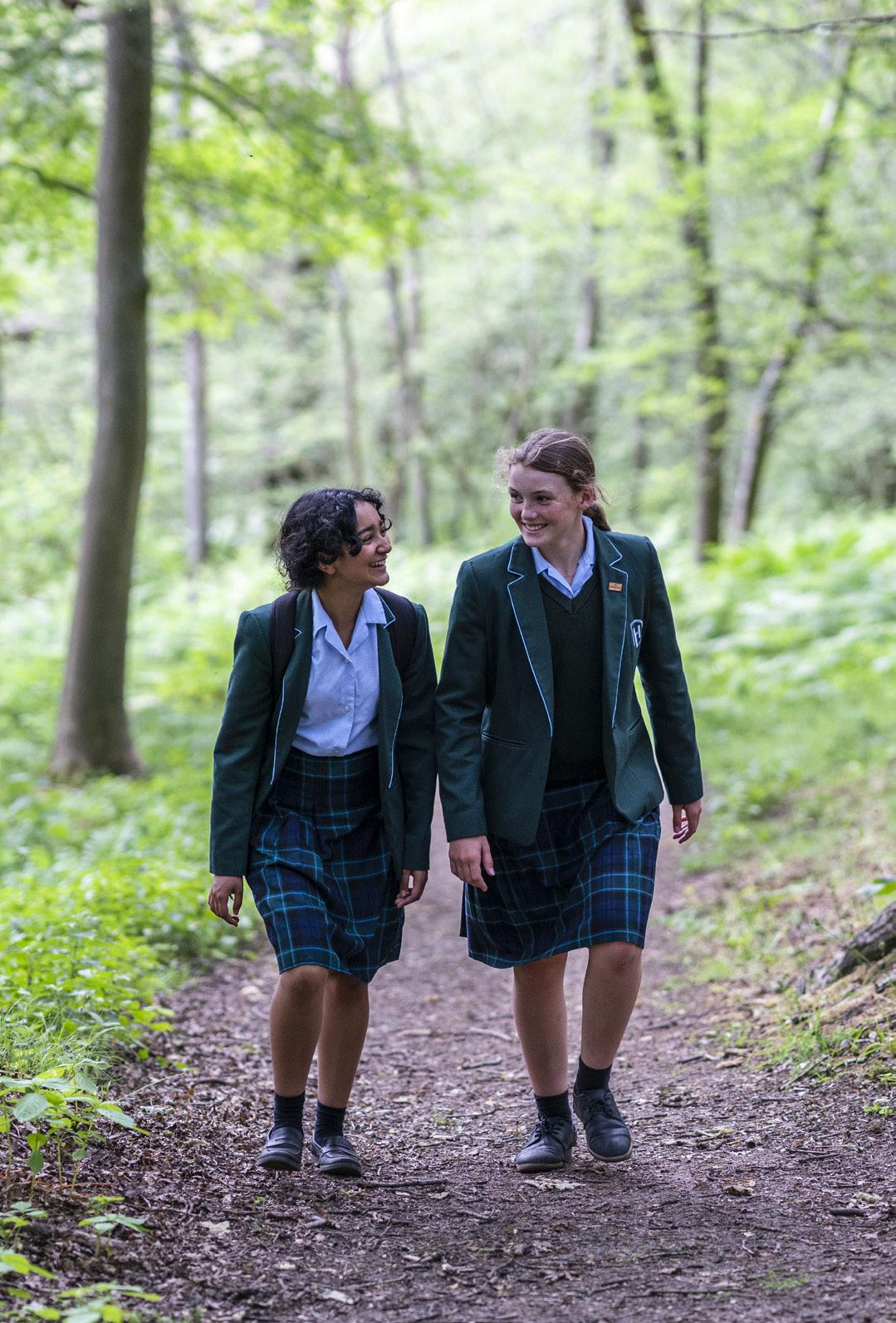100 YEARS
IN COLD ASH



In this issue, we feature interviews with alumnae on their roles in the Science, Technology, Engineering and Mathematics (STEM) sectors including Hannah Fothergill-Wilson (DH 2005), Vivienne Yeung (DH 2011), Charlotte Aldrich (DH 2017) and Madeleine Wild (DH 2011)
You can also take a walk back through history and read about how Downe House has evolved in the last one hundred years since moving to the site in Cold Ash from the village of Downe in Kent. This year also marks twenty-five years since Mrs Emma McKendrick became Headmistress and the School community celebrated this milestone in various ways including twenty-five cakes to celebrate her birthday in June!
It has been a particular joy to see the return of many of the Foundation events this year and the addition of new events to the calendar such as the Regional Reunion at Inveraray Castle in Scotland. Bringing the Downe House community together both within the UK and around the globe!
I hope you enjoy this edition in the spirit of celebrating 100 years at Cold Ash. If you have any comments, questions or suggestions for the next edition, please do email us at foundation@downehouse.net.
You can stay up to date with the latest news and events through the Foundation online network www.foundation.downehouse.net or through our social media accounts @dh_links
With best wishes,
MRS ALEXANDRA BARLOW DIRECTOR OF EXTERNAL RELATIONS



What a wonderful time we have had since April 2022 when we began to celebrate the Centenary of moving to the Cold Ash site. It is striking how many parallels there are between 1922 and 2022 with the School recovering from the impact of the Spanish Flu in 1922 and for us now, we are emerging from the global Covid-19 pandemic. It is clear that the School had suffered a period of significant disruption as a result, and the move to the larger site of Cold Ash was one that required great courage, vision and commitment. The buildings were not complete: girls had to sleep outside; water was scarce; and there was a need for changes to the curriculum to reflect the needs of the time. However, Olive Willis and her team simply got on with the task in hand – that of creating an environment where people mattered more than buildings and young women were educated to be strong and confident individuals who understood the importance of making a difference in the world, and the value of being part of a community.
All of those founding principles still stand and, as we emerge from the recent global pandemic, I am acutely aware of the importance of encouraging our young people to have confidence in themselves and to strive to be the best versions of themselves that they can be whilst also respecting and appreciating the diverse nature, talents and skills of those around them. We want them too to understand the power of working together as one school, the importance of playing a positive part in the local community of Cold Ash and of course on the global stage too. We do all this in the most beautiful and inspiring, but easily accessible, rural location. We could scarcely be luckier and as we enter our second century on this site, that spirit and ethos of Downe which I witness in our students every day can give us cause for great hope; they are remarkable young women who will make a difference and I believe Olive Willis would have been proud of them, as am I.
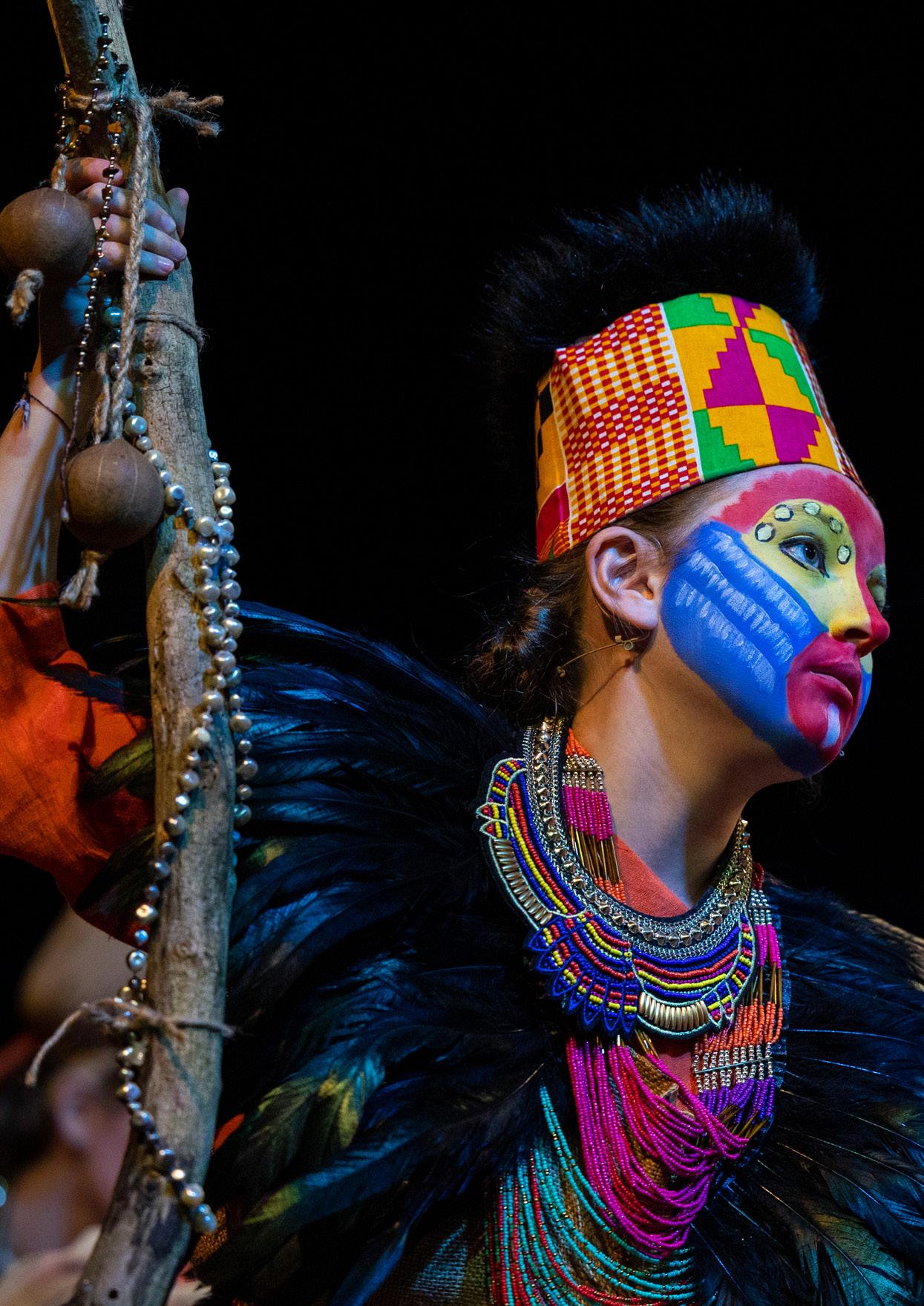 MRS EMMA MCKENDRICK
MRS EMMA MCKENDRICK
Celebrating 100 years in Cold Ash, two girls in the Cloisters area circa 1930.

The girls are wearing their summer uniform with hand knitted cardigans and accessorised with leather belts, usually borrowed from their fathers or brothers!
Photo courtesy of the DH Archives.
A reflective look back at the history of Downe House School and our Founder Miss Olive Willis
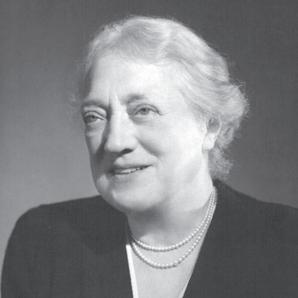
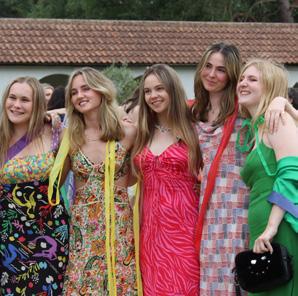
A celebration for the ‘Class of 2022’
A wonderful weekend of culture, performances, art and sport
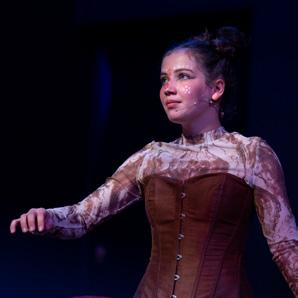
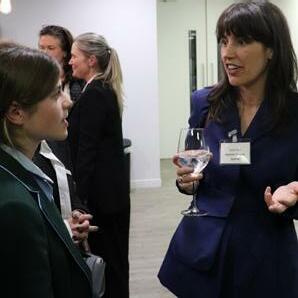


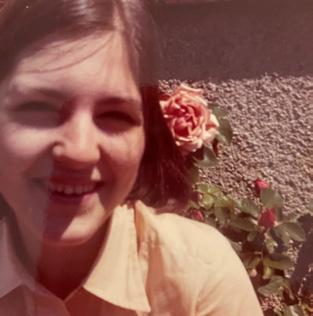
Celebrating rising stars within our alumnae community in STEM focused roles

We catch up with Izzy Huber (DH 2018) and her journey on raising awareness of mental health

60
A tribute to some wonderful alumnae
Old memories, old friends and fun stories at Downe House reunions
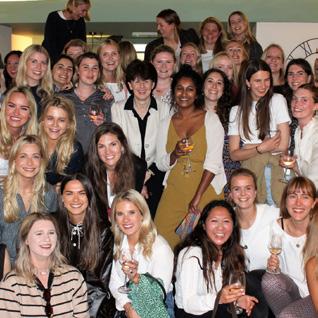
Celebrating 20 years at Downe House, we catch up with the Director of Creative Arts, Kirsten Mortimer
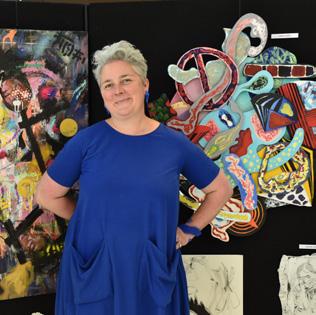
Compiled by
Guest Editors
Akinkugbe
and images
of Communications and Marketing
Contributors
Thank you to all our contributors, within the school and externally.
mention to our Archivist and the DHSA for their contributions
Magazine Designer
Craig Stevens


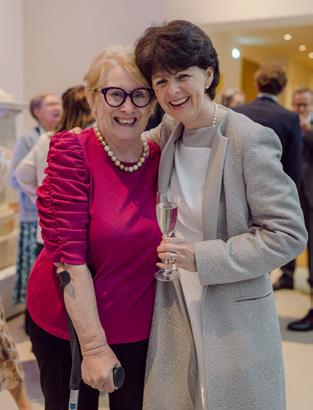
Asurprise gathering descended on the Ashmolean Museum in Oxford to celebrate Mrs McKendrick’s 25 years at Downe House. Much to Mrs McKendrick’s surprise, alumnae, former staff members and the Leadership Team joined the special occasion to celebrate her time at Downe House. Fru Hazlitt (Porter DH 1980), the Chair of Governors, gave a heart-warming speech to the guests in honour of Emma’s achievements and dedication to the School. A wonderful occasion to mark Mrs McKendrick’s 25 years at Downe House.

Mrs McKendrick was recently been shortlisted for the prestigious Tatler Award for The Best Head of a Public School who goes above and beyond.
WORDS ALEX BARLOW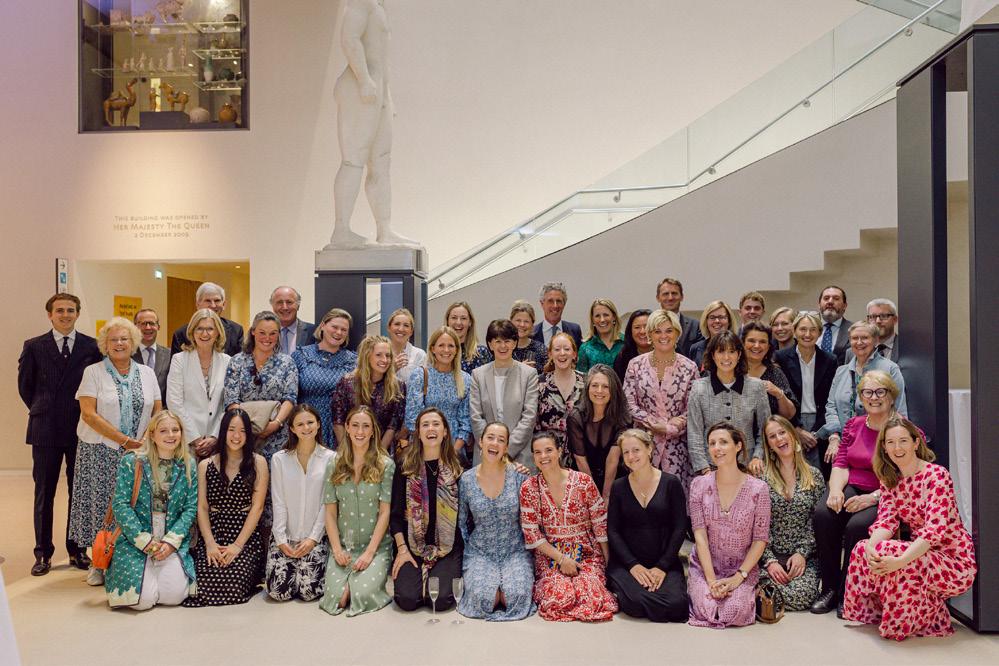
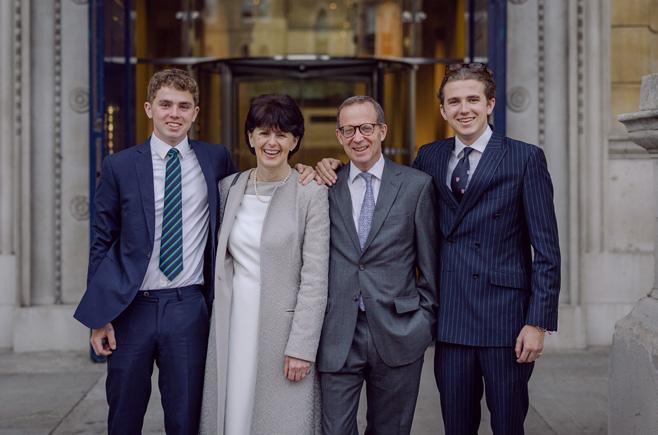
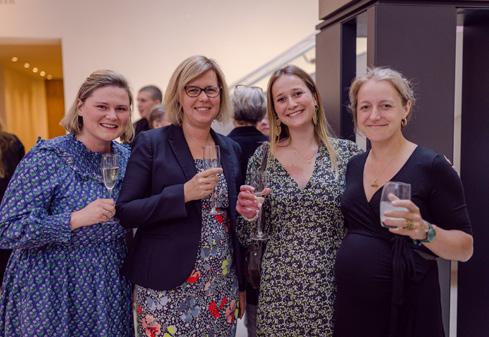
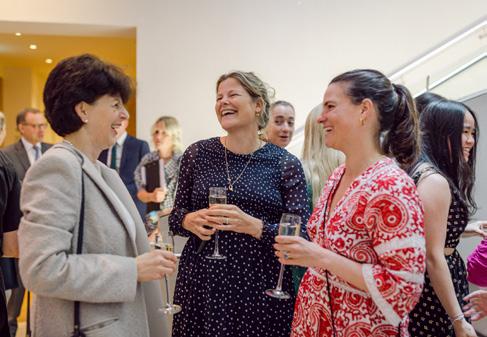
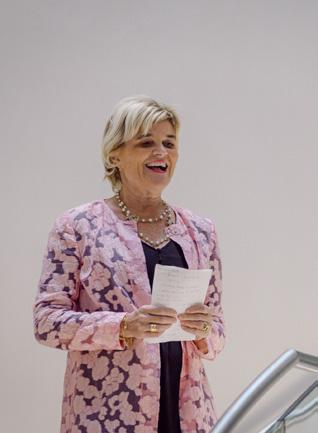
As 2022 marks a very special 100 years at the Cold Ash site for Downe House, we step back in time to look at the early years at Downe House. Founded by Miss Olive Willis and Miss Alice Carver in 1907, the first School was located at the former home of Charles Darwin in the village of Downe in Kent. In 1922, the school moved to Berkshire to start the Summer term.
In the early 1920s, an increase in the number of pupils and staff at the school and the pressure to develop the area around the village of Downe in Kent, meant that the School’s founder, Miss Olive Willis, sought a new home for her school. Whilst visiting a friend in Berkshire, Olive and her sister Dorothy came across the sale particulars for The Cloisters Estate. Olive was clear that she wanted a place on a hill, with relatively easy access to London and enough land to offer some real countryside for the community to enjoy. On their first visit, they realised that they had found their new home.
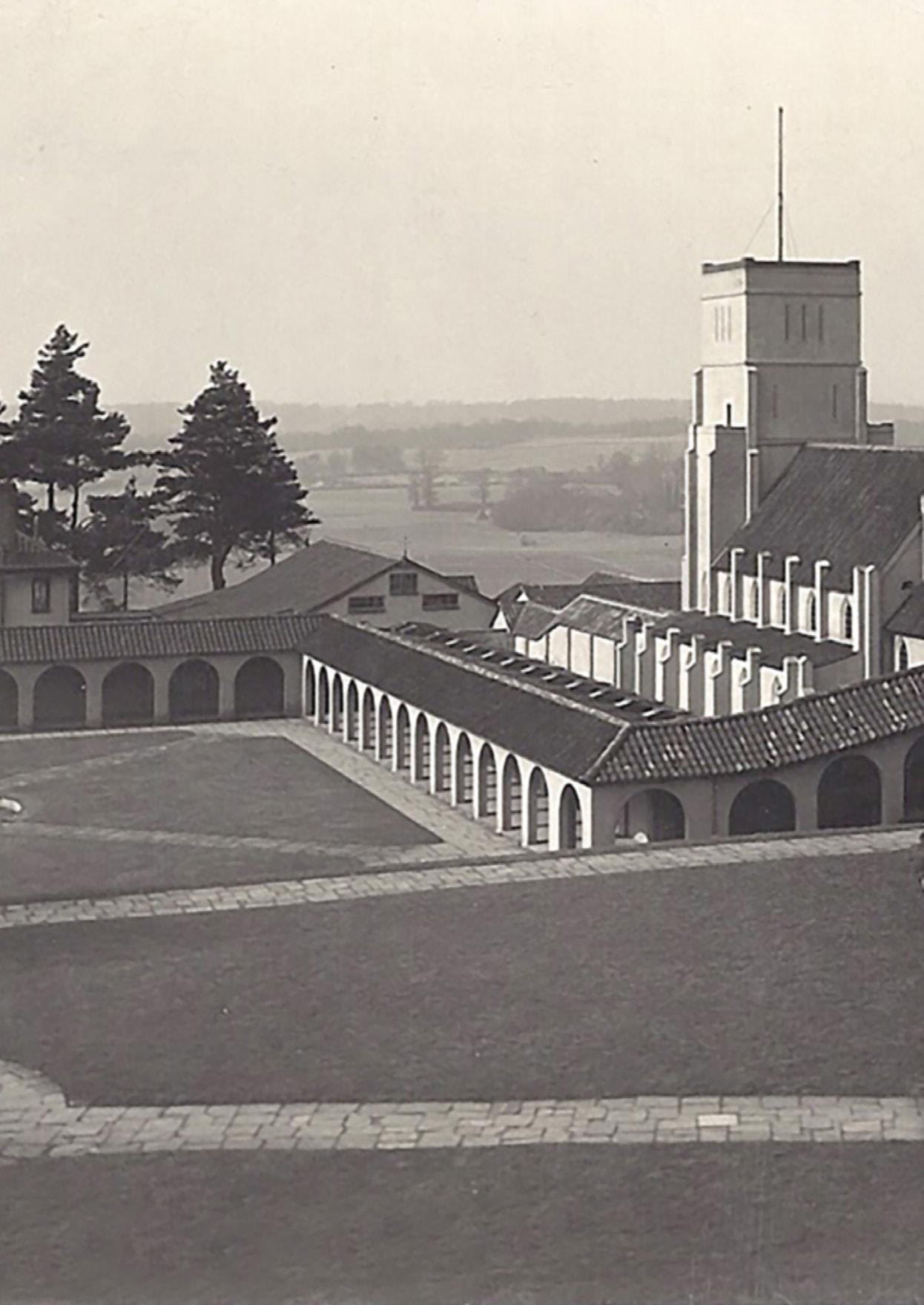
Miss Nickel (a former Geography teacher turned architect, chauffeur and right-hand woman to Miss Willis) set about making the necessary changes to the layout of the buildings with the help of local craftsmen, and the final move was made after the close of the Lent term in 1922. Furniture, books, kitchen equipment, linen, blankets and other belongings were transported over, by road or the railway. The buildings put up by the school in Kent had to be removed, under the terms of the lease, so they were taken down and all materials were moved to Cold Ash. There are even reports of steam engines being used to get everything from Hermitage Station up Red Shute Hill to the school.
For a short time, some girls slept outside on camp beds as not all the dormitories were finished. A balmy start to the Summer term and a supply of exceptionally comfortable wood and canvas camp beds made this a great pleasure; the tradition of sleeping outside as a treat on warm nights, under
the cover of the cloisters, has continued over the years.
In the late 1970s, a house system was introduced, and the house names were chosen to reflect aspects of the School’s history. Darwin house was of course named after Charles Darwin, Hill house after Red Shute Hill and Hermitage house after the village in which the school now resides. Miss Willis had a small cottage in the Quantock Hills named Holcombe, and that cottage sits on the edge of the village of Aisholt. Ancren Gate took the name from the original Cloisters Estate, The School of Silence, a religious order founded in the early 1900s by Adela Curtis and Lily Davison Cancellor. ‘Ancren’ coming from the term Anchorite or Anchoress, is one who withdraws from the world for a solitary life of prayer. Ancren Gate was built in 1914 as part of the School of Silence, when Downe House moved to Cold Ash, the building was used for staff accommodation and after a time it became a boarding house for the older pupils. As the school enrolment increased, in 1992 Ancren Gate was split into two houses, Ancren Gate North (AGN) and Ancren Gate South (AGS). Tedworth house takes its name from Tedworth Square in London, where Miss Willis spent the last part of her life and York house, one of our Sixth Form houses, was named after York Terrace, near Regent’s Park, where Olive made her first London home. The other Sixth Form house, Willis, was of course named in honour of the school’s founder, Olive Willis.
The Cold Ash site has developed over the years, but Miss Willis’ founding principles remain, Downe House is
a strong community where each member is respected and valued for their individuality, and where the needs of girls and young women are at the heart of education. Despite considerable changes throughout the years and development of the site, returning alumnae and former staff find the DNA and core principles remain the same to this day.
Mr Iain McMaster (former parent) wrote about Miss Olive Willis, “The fact that she could greet any one of her girls after 10, 20, even 40 [or] more years, by name and with a smile of real recognition was not due to her wonderful memory and correspondence but because, at School, she had seen right into them with hopefulness. This deep knowledge and the love that inspired it, had made each an undying part of the other.”
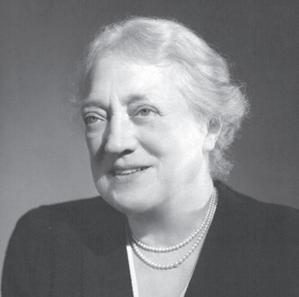 INFORMATION FROM THE ARCHIVES
Miss Olive Willis
INFORMATION FROM THE ARCHIVES
Miss Olive Willis
Among the greatest pleasure I can think of in my summer was that of sleeping out in the Lily Pond on a camp-bed, one of a circle of six or eight, and waking up in the deepest part of the night to see nothing but the black sky full of stars bounded low down by the Chapel, the Cloisters and the tree in the Greek Theatre. That utter serenity was so silent that one’s ears strained to hear a distant bark or the breeze against the wall and the dew lay in thick drops on the grass and blankets. The change from the bustle and noise of the day was profound, and yet the place was immutably the same.
JENNIFER GOSSE (DH 1950) WAS A PUPIL AND LATER TEACHER OF ENGLISH AT DOWNE HOUSE
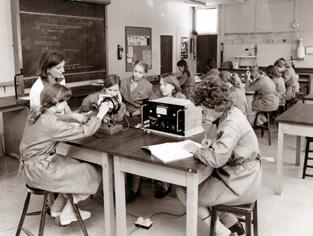
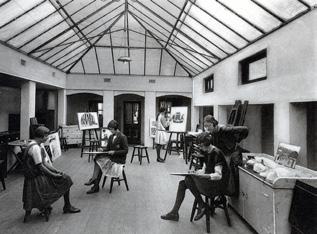
The tradition of a special summer weekend began in 1911, when Miss Willis invited all past pupils to come and return to School for a long weekend, giving them an opportunity to reminisce together, to see how the School had developed and to meet past and current pupils and members of staff.
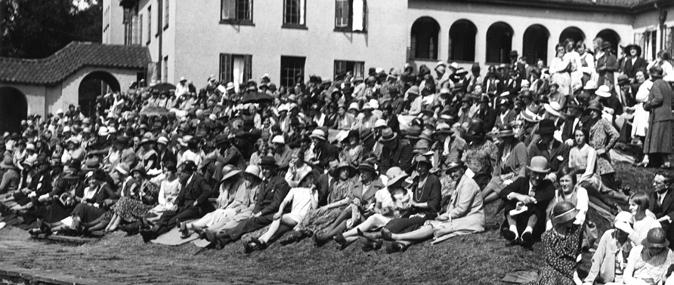
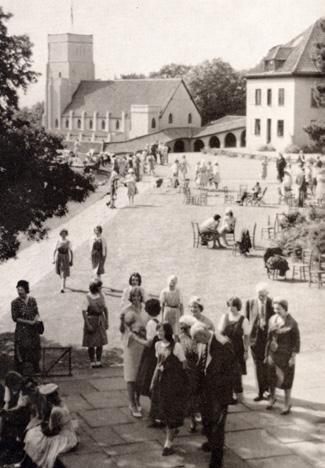
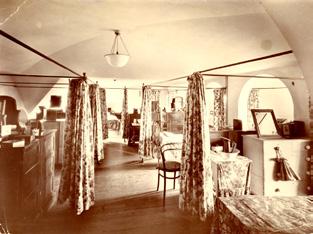
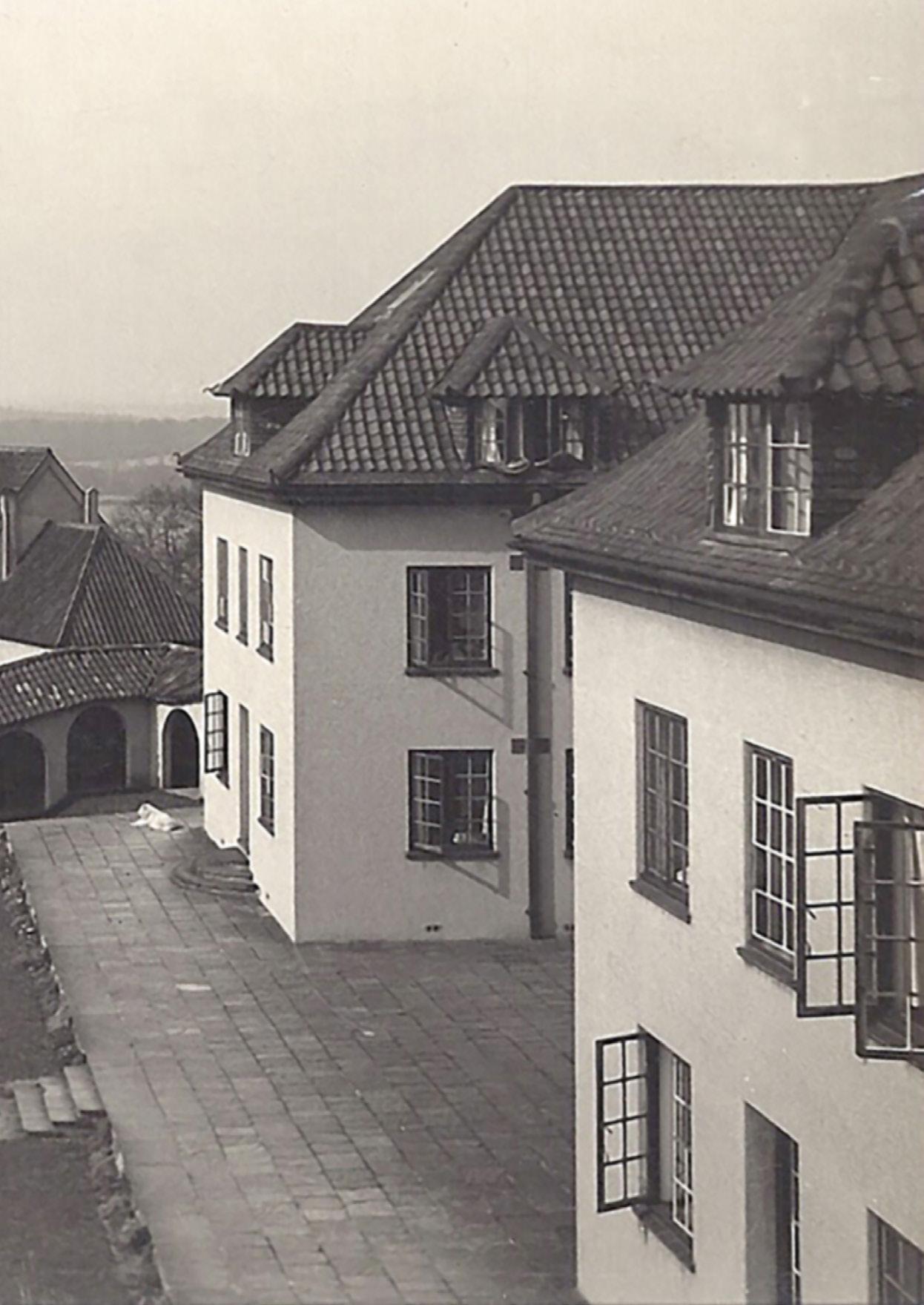
There would always be entertainment provided by the current pupils; a concert, a dance show, a dramatic production, a Chapel Service and a formal dinner with speeches.
As time went on, and numbers grew, the celebrations were limited to Saturday and Sunday and the School could no longer offer accommodation. Visiting families, past pupils, staff, friends and supporters of the School would bring picnics and be treated to a splendid afternoon tea and a variety of performances. Classrooms were open and each department would put on a display of current pupils’ work and achievements.
In the 1970s the celebrations became known as Music Weekend and the programme always included
a ‘piano prom’ where staff and pupils performed together on as many pianos as could be fitted into the Concert Room, whilst allowing space for an audience! Latterly, the celebration weekend has become our Founder’s Weekend.
The circular area in the middle of the lower Cloisters was a shallow lily pond when the School first came. It now has a memorial to Olive Willis in the centre.
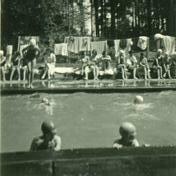
The rooms on the south of the Lower Cloisters, S, P, Q and R, are named after Senātus Populus que Rōmānus – the Senate and People of Rome. On the other side, the small cloisters rooms were used


as music practice rooms before the new Music Block was built.
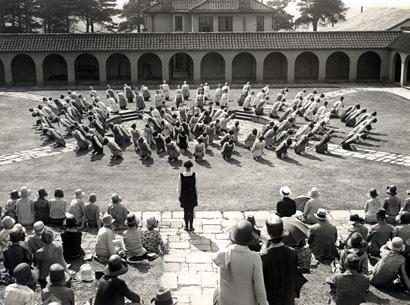
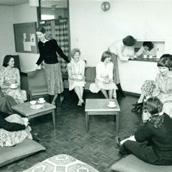
Chapel is an important part of Downe House, a place for prayer and reflection as well as for community praise. All Headmistresses have followed the Founder’s principle, she wrote “At Downe House I tried to lead girls on to find their own spiritual way.”
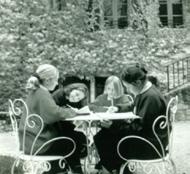


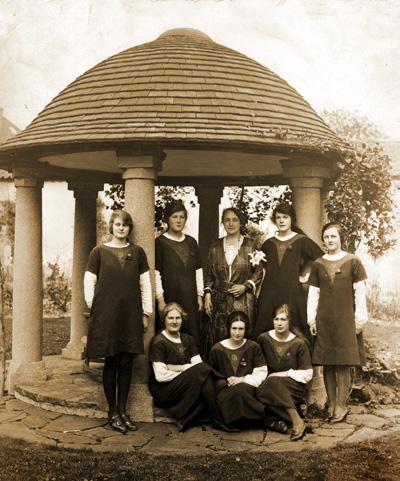
The Pepperpot, sitting next to our History Block was part of the original School of Silence and it covers a well. When there was a prolonged dry spell shortly after the School moved here, this well had to be used; the girls and staff forming a line to pass buckets of water to the houses. It was essential that a new water source be found, so a water diviner was called in and the girls, interested as ever in everything, tried their hand at this and were found to have some talent for it!

A plentiful source was found under the central area, between Wakefield House and the front door of Aisholt.
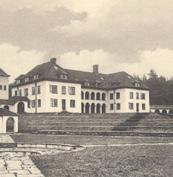
Aisholt House is at the centre of the School. It was founded in 1979 and situated in two wings, East and West. It was part of the original main house of the School that was built in 1912. Aisholt is named after a small somerset village in the Quantock Hills. Miss Willis had rented out and stayed at a thatched cottage called Holcombe, then sometime during WW1 she bought it.


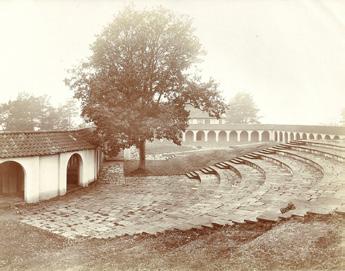
Our mighty oak tree next to the Greek Theatre is shown on the earliest plans we have of this site. A German paratrooper landed in it during an air raid on Cold Ash; probably quite startled to find himself surrounded by girls and teachers and he was swiftly taken down to the local police station. Not only is the Greek Theatre important for productions, it is a place for girls to sit, talk and read. In fine weather, the warmth of the sun on the stones makes it a perfect spot to reflect as darkness falls.

“Everybody knitted. Needles and wool, airforce blue, navy, and khaki, tumbled out of lockers, lay on chairs, piled up in ‘Confiscation’, grew in willing hands into scarves, socks, and sea-boot stockings. We knitted in break, in rest, whilst we watched films on Saturday evening and also during our lessons. The Forces Comfort Funds must have been swelled by an enormous flow of garments from Downe House –for our speed was incredible and competitive.”
“In our dorm, we possessed one (literally) enormous asset. Elizabeth owned a wireless set, it was vast and ran off the light, attached by a huge wire which hung across the middle of the room, while lesser wires festooned the walls, to form aerials and earths. Movement was restricted while it was playing, and it was better to sit, or else to lie down, but I am sure that no wireless before or since has ever given its listeners more pleasure. During those, long, dark and bookless evenings, with the blackout blinds up and the blackout rules enforced, we curled up and listened. When ‘Band Wagon’ came on, it was carried, with much groaning, into the passage, where it entertained a growing audience.”
RUTH ASPINALL (DH 1939) WAS AT DOWNE HOUSE DURING THE YEARS OF WWII. SHE WENT ON TO BECOME A VERY SUCCESSFUL AUTHOR.
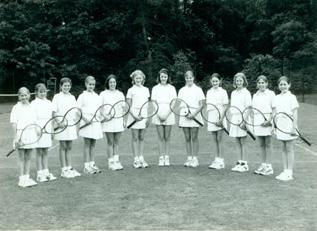

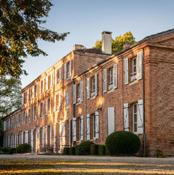

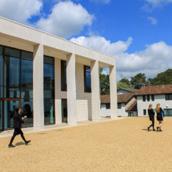
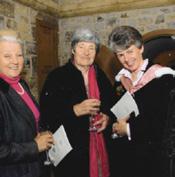
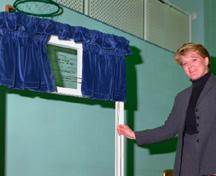


Nancy Wansborough (Joy DH 1927–32) became quite a cricket player, and was a member of the 1948–49 English Women’s Cricket Team. They travelled by ship, stopped and played in Columbo, Perth, Brisbane, Sydney, Bathurst, Deniliquin (where they enjoyed a Christmas Eve Dance and Midnight Mass), Adelaide, Port Pirie and then on to New Zealand. Nancy is centre front above.

Take a step back in time with a collection of School photographs from across the decades.

Please feel free to contact the Foundation Office for an enlarged copy if you can spot yourself, we would love to hear from you! Email: foundation@downehouse.net

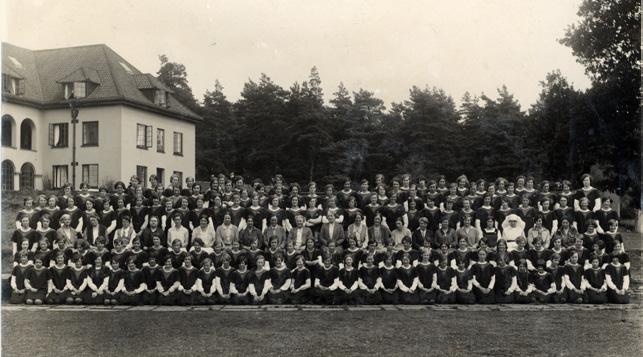





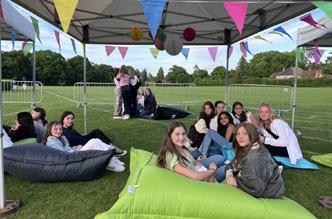
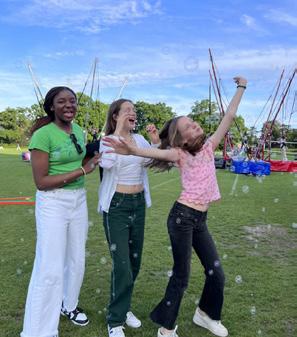

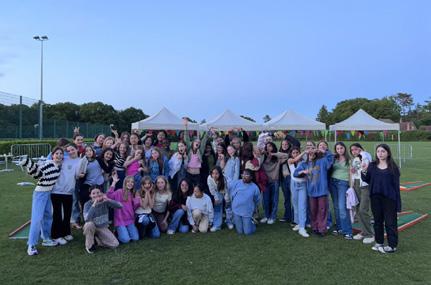
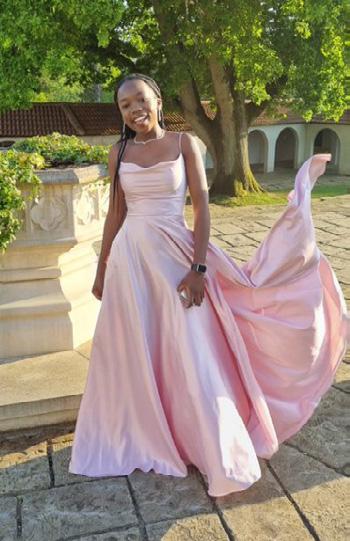
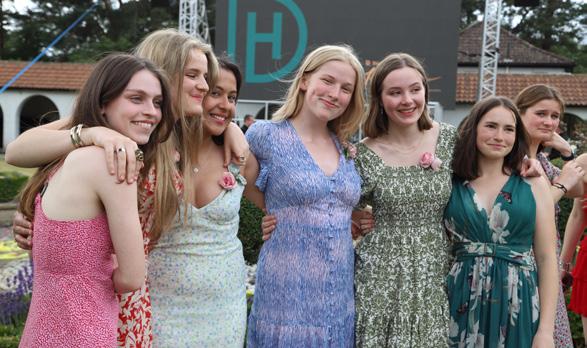
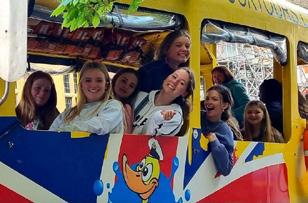
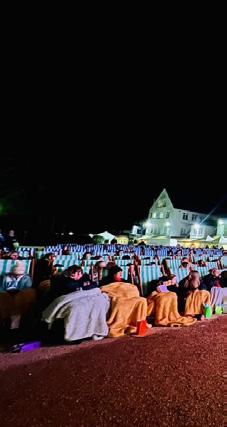
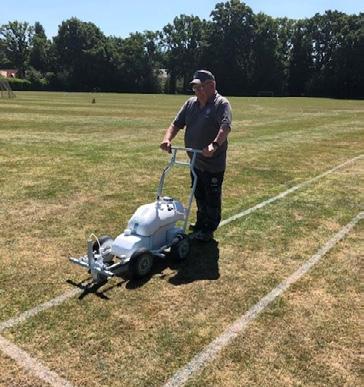
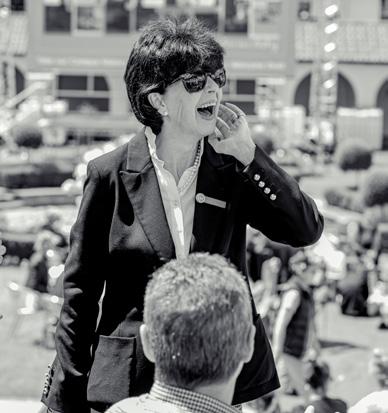
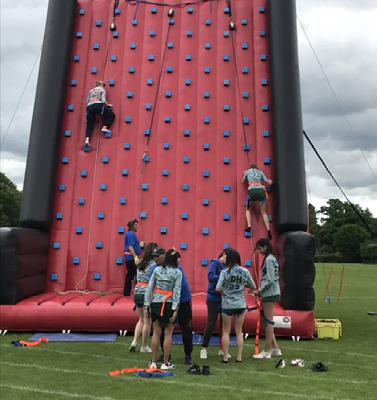
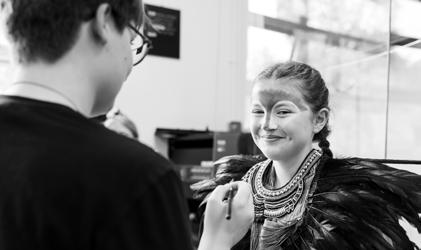
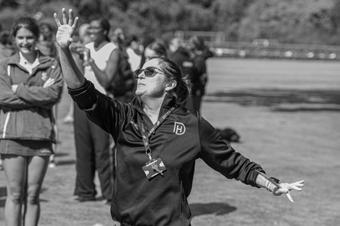


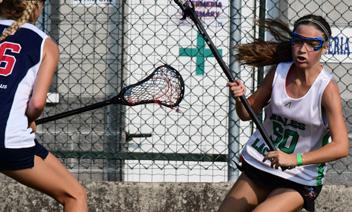

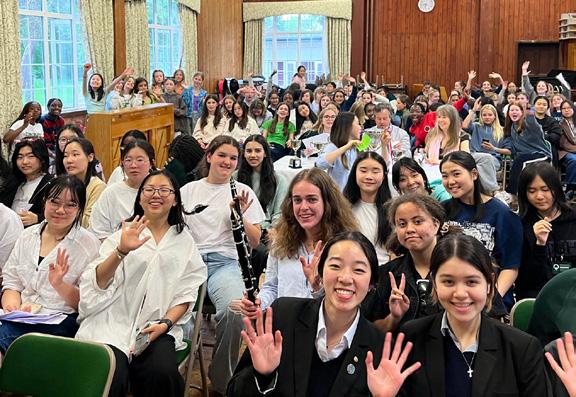
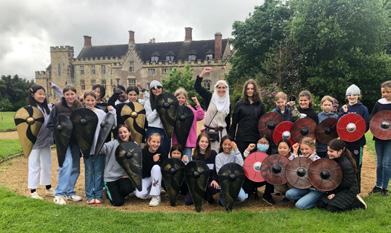
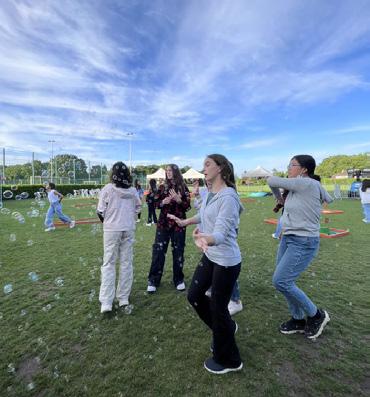
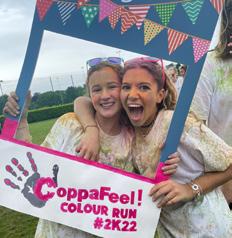
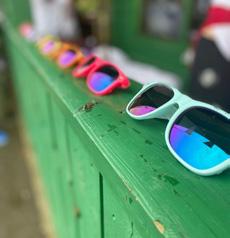
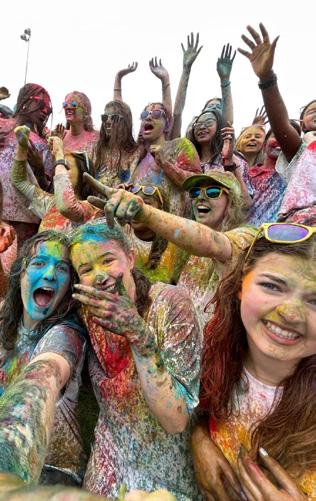
Back in May, a grey and drizzly afternoon at Downe House was transformed into a riot of colour with a 2k run in aid of Coppafeel. The event was organised by York House to raise money for www.coppafeel.org as part of their chosen house charities for this year. It was a fantastic afternoon enjoyed by all and raised over £1,500. Well done to York House for a great event!
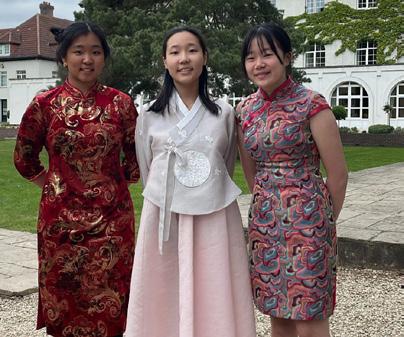
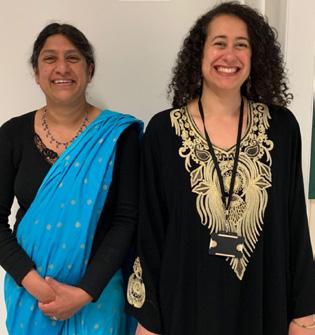
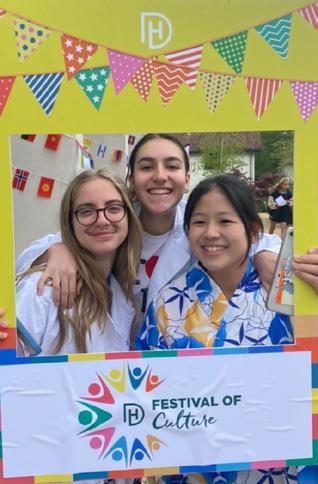

The Global Ambassadors’ team launched a wonderful event where everyone dressed up in a costume that represented their own culture, or a culture they had an affinity with. The spirit of culture was truly embraced with street food stalls, music performances, mini Olympics and everyone made an outstanding effort with their costumes. It was great to celebrate such diversity and culture across the School.
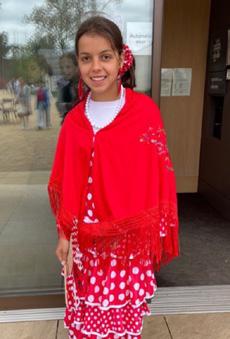

Back in June, we celebrated the diversity in the School community with Downe House Pride 2022, with a rainbow-washed Murray Centre. Throughout the week, the School held competitions, discussions, interactive quizzes, a film night and The Great Downe House Pride Bake Off, along with raising money for Educate and Celebrate and Switchboard, the LGBT+ helpline.
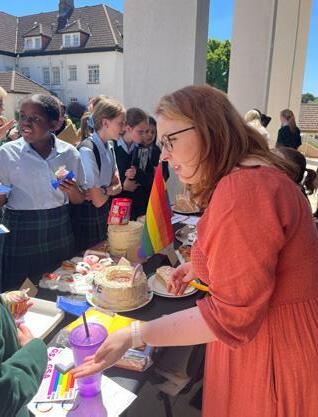

Downe House Muscat welcomed Mr Inglis (Headmaster at Elstree School) along with his family in June for a tour around the school and to meet the team. Mr Inglis’ daughter, Eliza (DH 2020) enjoyed chatting through all her wonderful experiences at Downe and the incredible friendships she made.
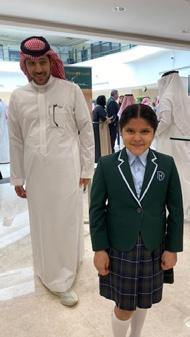
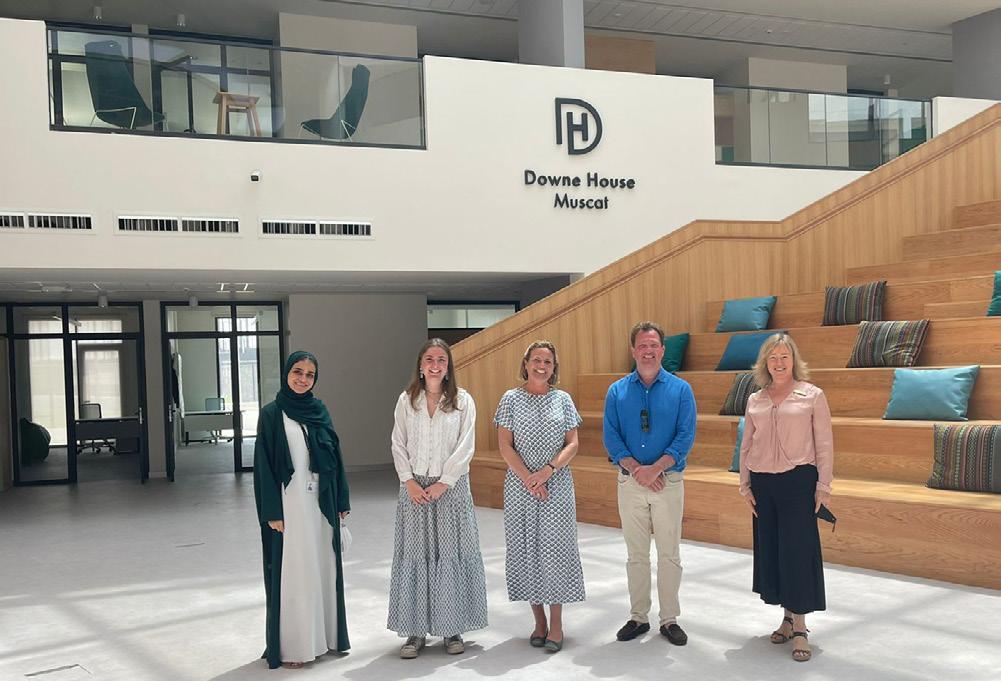
In a brand-new chapter for Downe House, June saw the launch of Downe House Riyadh. We were privileged to be joined by the British Ambassador, members of the Department of International Trade, the Ministries of Education and Investment, the Royal Commission for Riyadh City and representatives of the press and television. Mrs Emma McKendrick attended the launch and had the opportunity to address parents during the day and take questions from them.

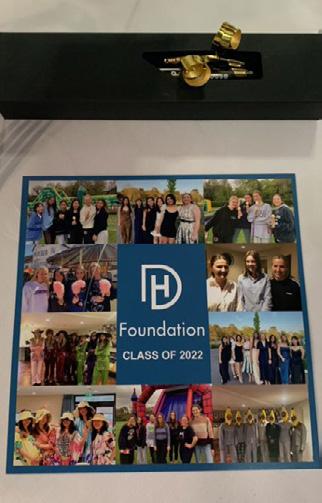
A wonderful evening with our 2022 Leavers, thank you to Marina Sykes (DH 2010) for her inspirational speech. Wishing the Class of 2022 all the very best for the future.
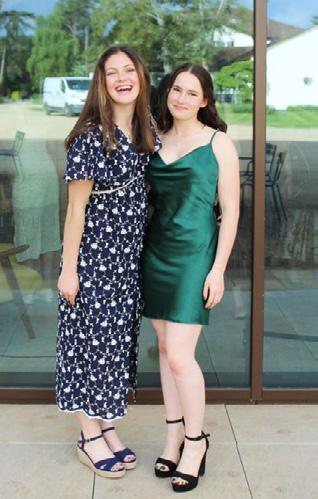
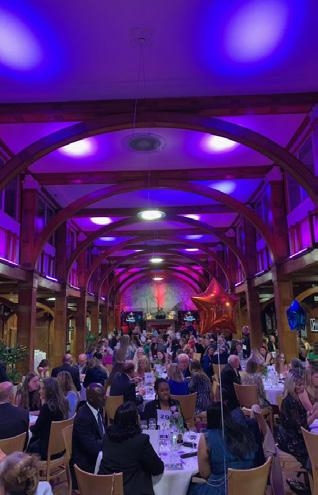
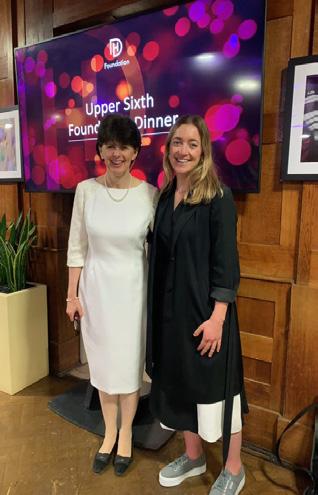
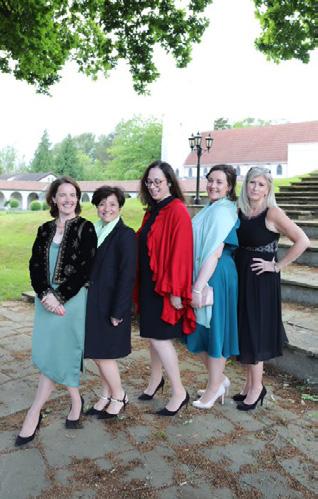
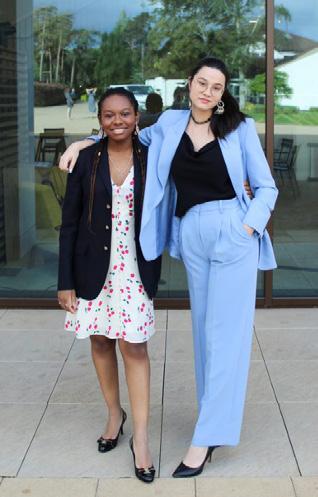


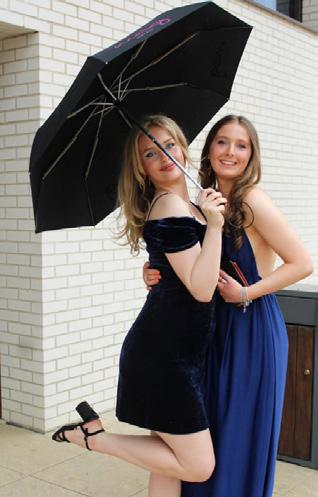
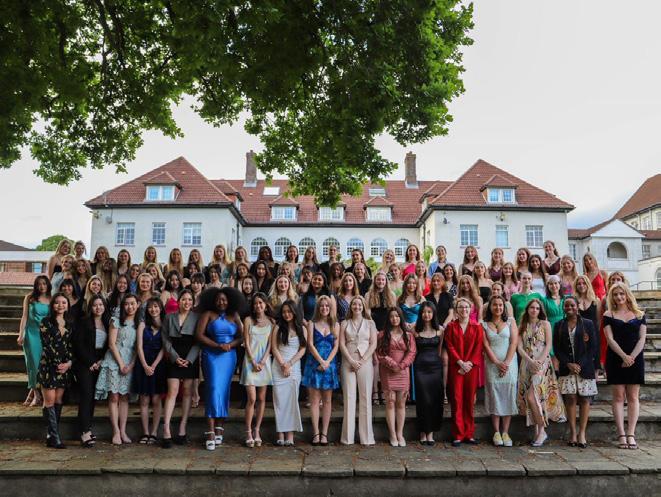
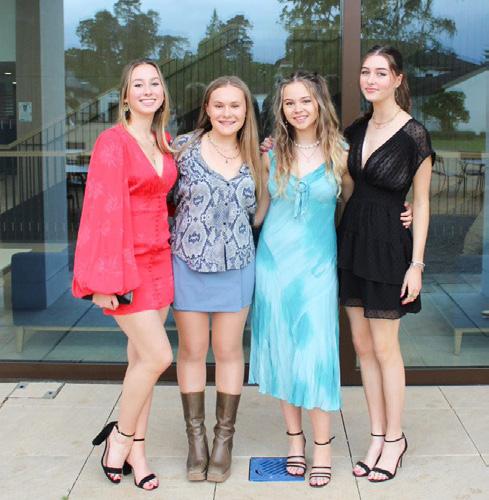
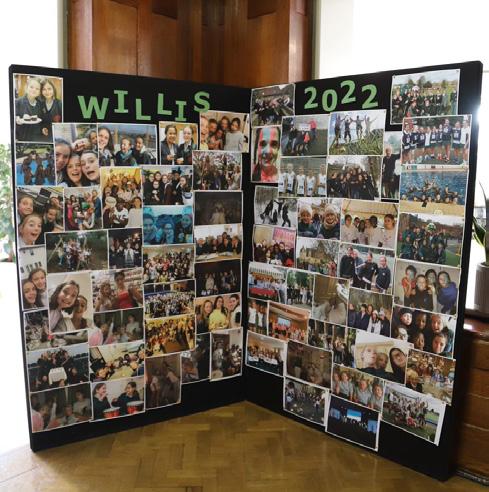

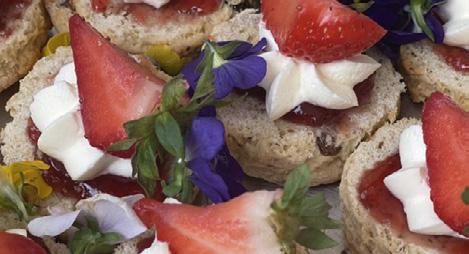
On Wednesday 25th May 2022, the Downe House community gathered together in the Cloisters to celebrate the Platinum Jubilee of Her Majesty, Queen Elizabeth II. We were not sure if the weather would hold but were fortunate that as the tea began at 3pm the sun came out, just as girls and staff began to gather. The Art Department shared some images of the Queen created by the Upper Fourth which everyone enjoyed. There were garden games including Giant Jenga and Croquet and a particularly fun game called Spike Ball, which was specially requested by the Headmistress. It was wonderful to see the girls all having fun together enjoying one another’s company.
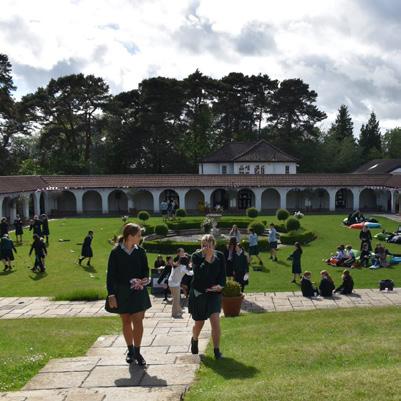
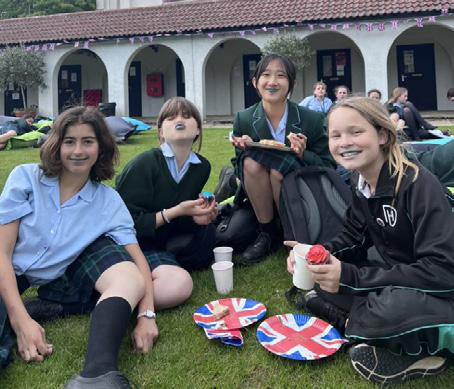
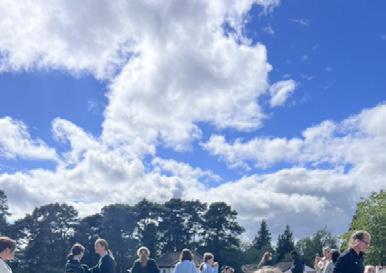
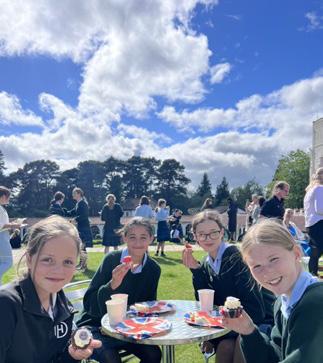


The highlight was of course the incredible tea produced and
served by our catering team. The sandwiches reflected the voting choices of the community and featured everything from tuna and cucumber to cheese and ham, and chicken salad. There were cupcakes with brightly coloured icing (and a few blue tongues were seen after eating) as well as traditional scones with jam and cream. It took nearly two hours for all of the School to have tea and there was a relaxed party atmosphere with a play list of music chosen by our Head and Deputy Head Seniors that stretched across the 70 years of the Queen’s reign.
It was with great sadness in September that members of our community learned of the death of Her Late Majesty Queen Elizabeth II, which makes our commemoration of her 70 years reign even more poignant. May she rest in peace.
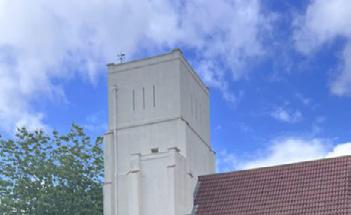
On a beautiful summer’s evening in June, our former Downe House parent, The Right Honourable the Lord Strathclyde CH PC, hosted an Evening Reception on behalf of Downe House in the Cholmondeley Room and Terrace at the House of Lords.
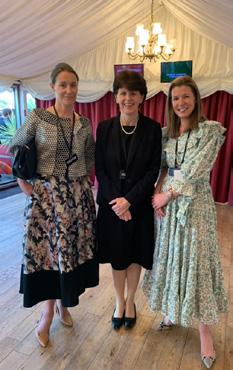
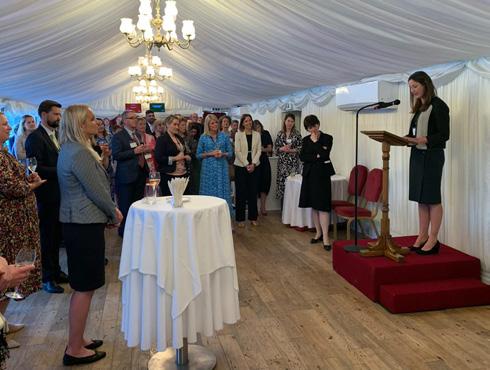
After having to postpone this event twice due to the pandemic, it was once again a great pleasure to be back at this splendid venue and to be joined by 150 guests from our feeder Preparatory Schools, Downe House alumnae and community including parents, governors, staff and newly appointed School Ambassadors.
This wonderful occasion was an opportunity to celebrate all that has been achieved in our school over the past couple of years. The Lord Strathclyde gave a welcome speech, followed by Mrs McKendrick who spoke about the challenges schools have faced in recent years and how the resilience of staff and pupils has shone through
during these difficult times. Mrs McKendrick spoke of the many achievements made, the global links that Downe House has created both in Muscat and Riyadh, and provided an update on the Ten Year Vision to ensure every pupil receives the education and care to prepare them for any avenue they wish to take in life.
We were delighted Downe House Alumna, Dr Libby Brewin (DH 2008) joined the celebrations as our guest speaker for the evening. Libby spoke fondly of her memories of Downe House, both academically and on the sports field. Libby explained how the School prepared and supported her to make the step straight from Sixth Form to study Physical Natural Sciences at the University of Cambridge. Libby proceeded to the University of Warwick to study Medicine and has since dedicated her career to working for the NHS, even coming straight from a shift to the House of Lords that evening.
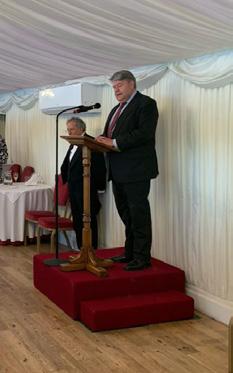
Founder’s Weekend is always a special time in the School calendar, however this year even more so. It marked the end of a wonderfully normal term following the disruption of the pandemic and it was great to see unrestricted rehearsals taking place across Music, Drama and Dance, as well as a great deal of preparation for Sports Day.


An inspiring School community, pioneering education for generations
Years in Cold Ash
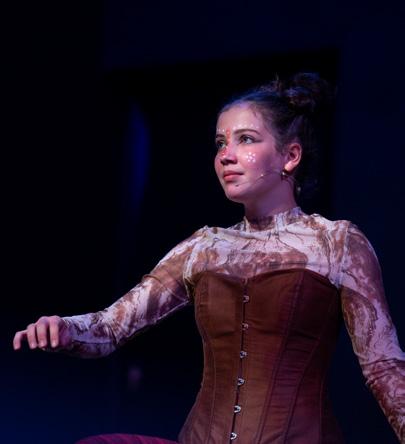
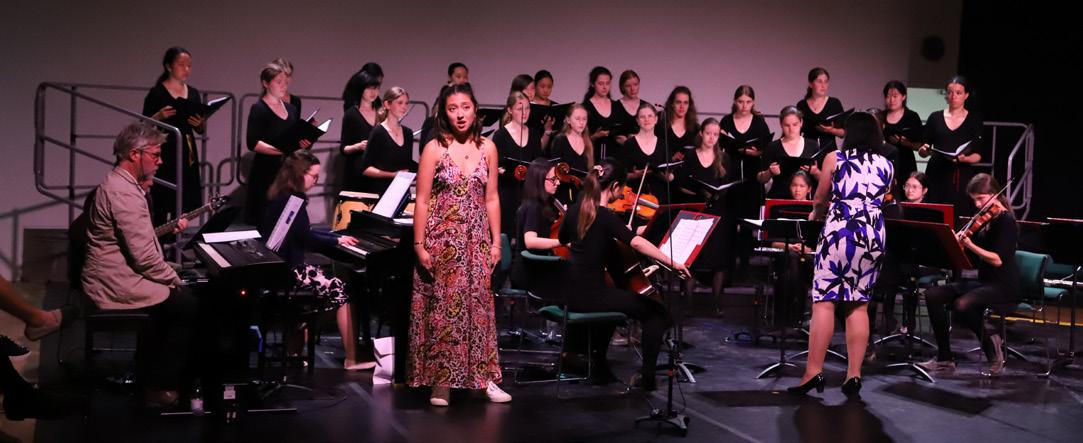
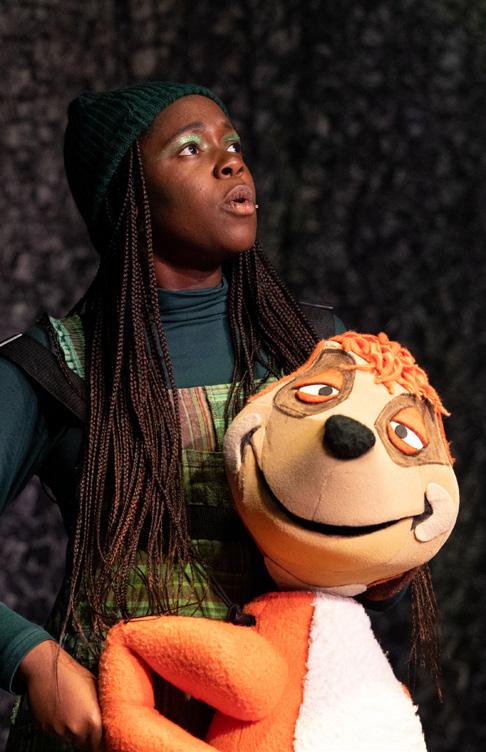
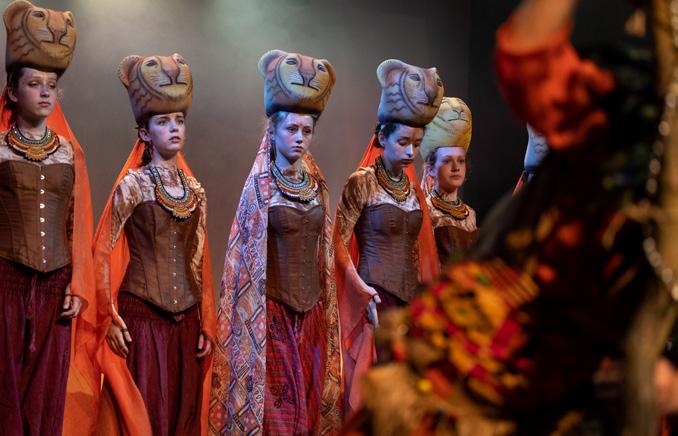

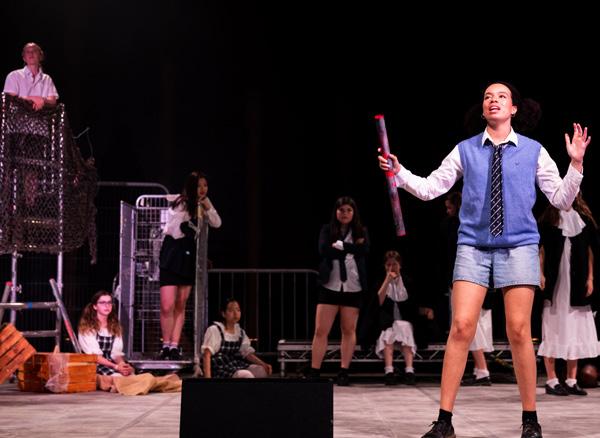
It was wonderful to bring the whole community of girls, parents, alumnae, staff and friends back to together to enjoy a weekend of dance, drama, creative arts, displays, sport and much more. This year in celebrating the centenary of the School being at Cold Ash, neighbours from Cold Ash were also invited to attend the special weekend. It was fantastic to see so many of the local residents across many ages come and enjoy the experience of Founder’s Weekend.

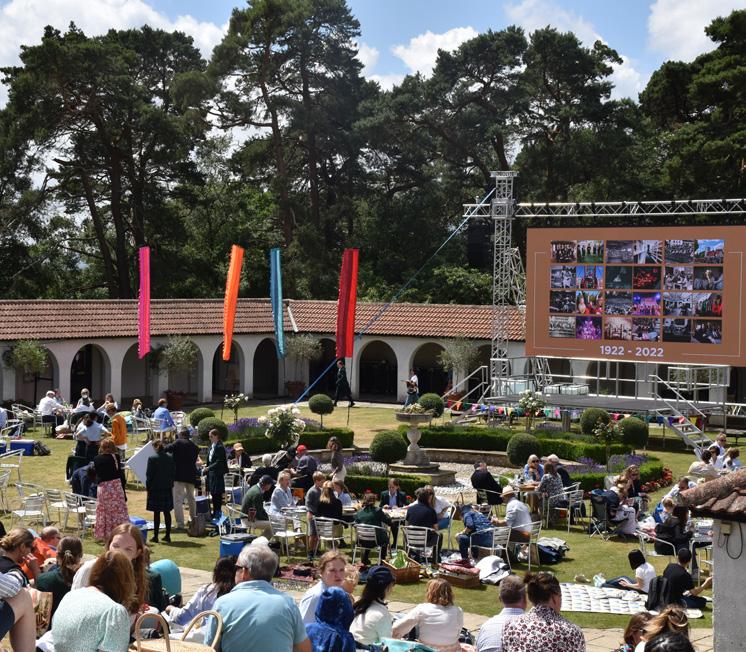
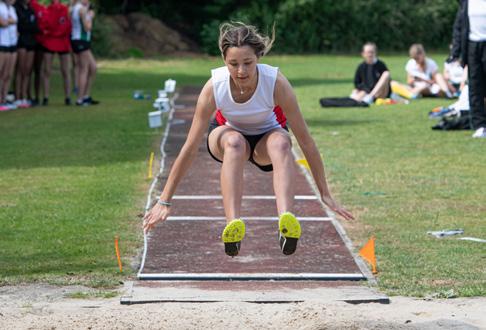


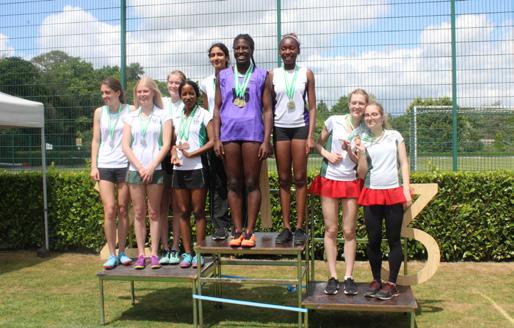

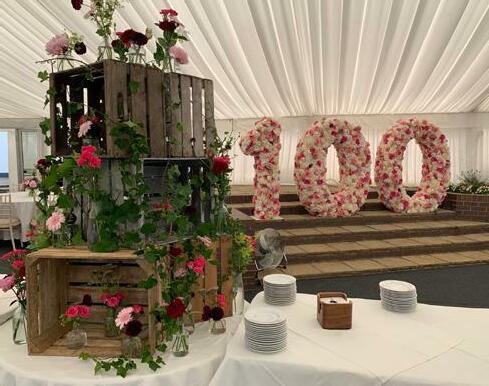
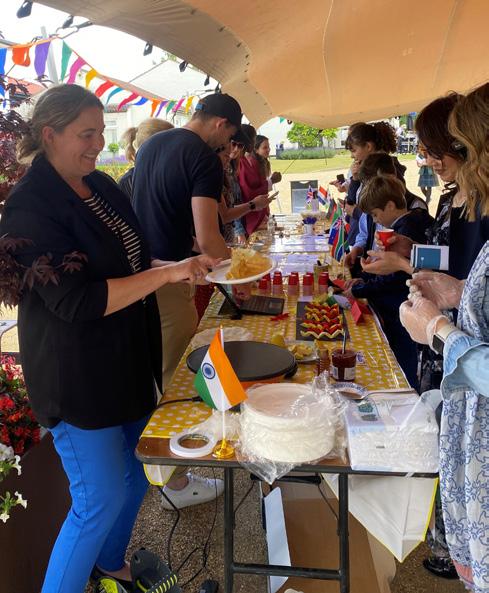
As we mark the centenary anniversary of Downe House in Cold Ash, as part of our celebrations, we were delighted to host pupils and teachers from Cold Ash St. Mark’s Primary School for an afternoon of fun workshops.


Downe House teachers created six interactive workshops in total, which included nature, exciting science workshops, a sports medley, robotics and an introduction to the Chinese language! Each workshop was delivered in a fun and interactive way, whether it was creating magnets, programming a robot, ‘chasing the cat’ or singing in Chinese; the workshops gave the children an opportunity to immerse themselves in something completely new.
‘We had a lovely time getting to know the Year 3 and 4 pupils from St. Mark’s school through some fun and interactive games using a parachute. They loved hi-fiving under the canopy, being chased by the ‘cat’ and doing the ‘washing machine’. Our wonderful Seniors, Cordie, Grace and Jess, were superb and facilitated the games with great confidence and leadership. There was a wonderful buzz of excitement and high energy generated –each group left wanting to do more. It was a winning formula!’
MRS NICOLA RIDDLE, PE TEACHER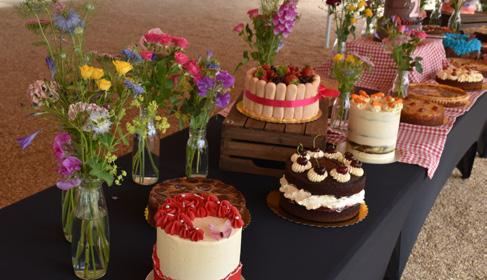

On 24 June, a very special double celebration took place to recognise the 25th year of Mrs Emma McKendrick’s role as Headmistress of Downe House, which coincided with her birthday.
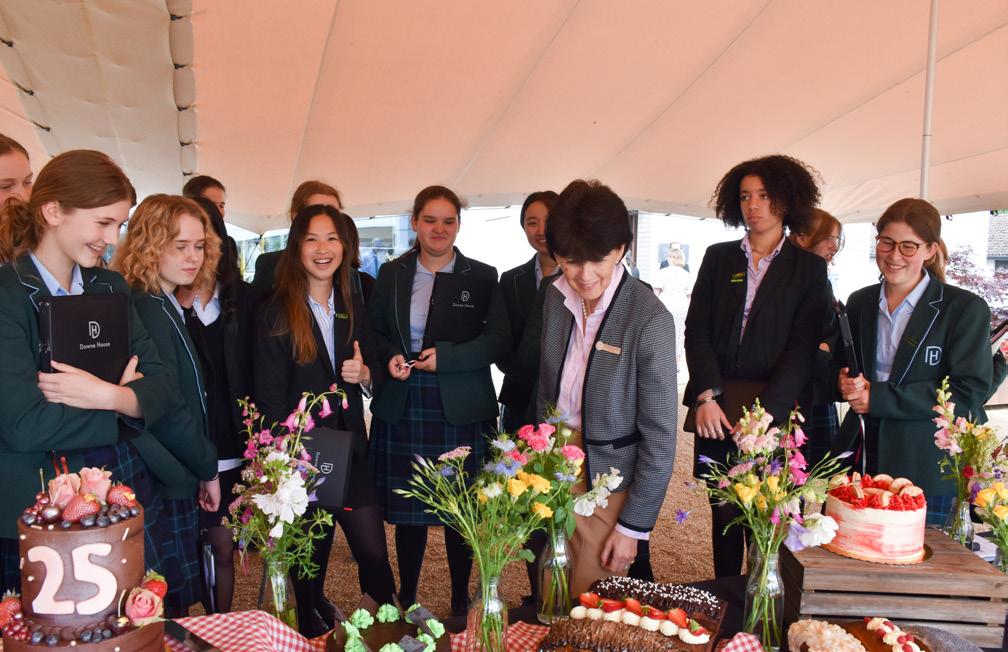
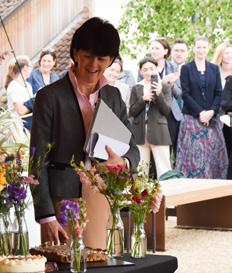
The whole school surprised Mrs McKendrick with a rousing rendition of Happy Birthday outside the Murray Centre along with twenty-five different cakes to reflect each of her years at Downe. Despite commenting on how delicious the chocolate cakes looked, the jammy dodger cake was Mrs McKendrick’s favourite!
Lola and Cleo (Head and Deputy Seniors for 2022), thanked Mrs McKendrick for her years of service and commitment to the School, before Prima Voce performed ‘A Blessing’ written by Bob Chilcott especially for the occasion. Mrs McKendrick was then presented with the framed original manuscript of the piece.
‘Thank you! Twenty-five years. Goodness knows where it has gone! I see it as an enormous privilege to get up every day and do something that I love and to have the opportunity to work with you, so for me it is not a job it is a wonderful way of life.’
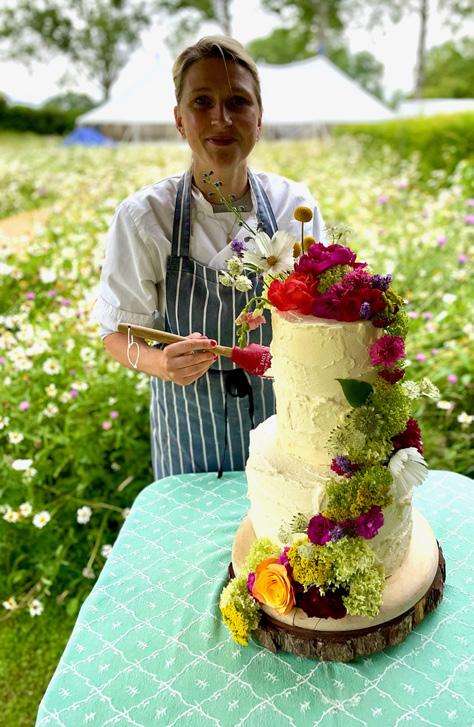
As part of the Founder’s Weekend programme, we saw the culmination of a baking competition where groups of girls from across the School competed to devise, bake and decorate Centenarythemed cakes. The winning cake – a beautiful earl grey tea flavoured cake with a sugar crown was created by Milly, Effy and Anna in the UIV.
Rose has been in the catering industry since 2013 after setting up her own business – Peardrop London, a luxury event catering company and bespoke cake maker. As a catering professional, Rose has a passion for parties, produce and planet. For more information about Peardrop London, please visit Peardrop online:
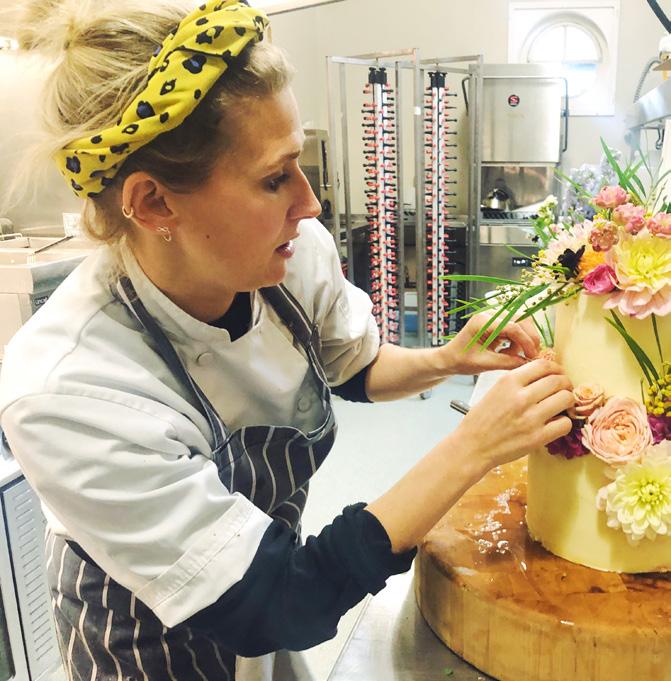

With their exams finished, it was time to say farewell to the Class of 2022 and to celebrate all that they have achieved at Downe House.

On Friday 1 July, we welcomed our Upper Sixth parents and their daughters to celebrate their Leavers’ Day. The day began with a Whole School Assembly outside in the Cloisters with a prize-giving ceremony for nominated pupils across the year groups and Leavers’ Awards for the departing Upper Sixth girls. This term, the House Cup for Stars & Commendations was awarded to Aisholt. The Olive Willis Cup is awarded each year to a student who has made an outstanding contribution to School life through generosity of spirit, kindness, compassion and care for others and this year this was awarded to Lauren Raeburn-Ward (DH 2022).
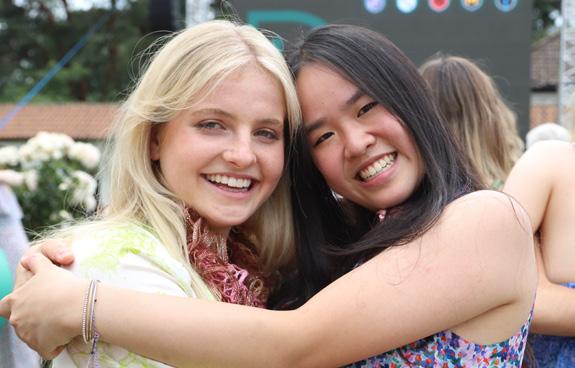
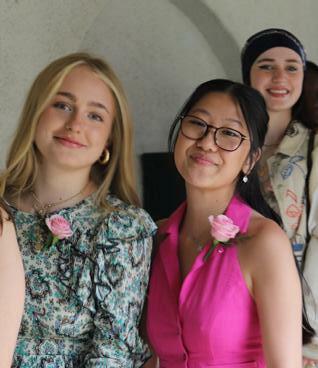
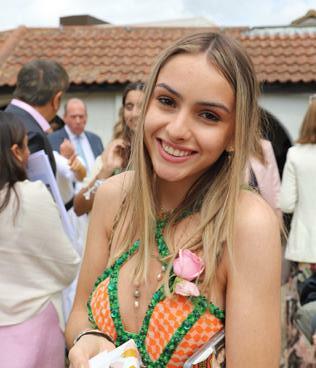
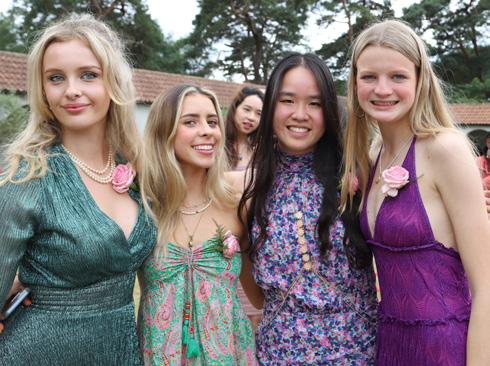
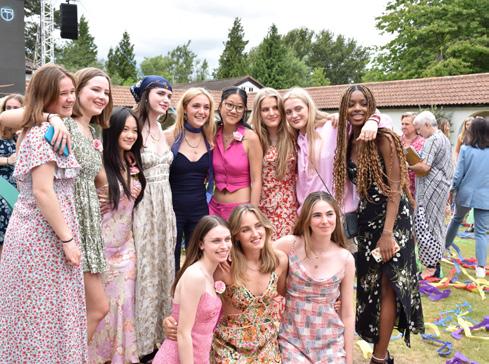
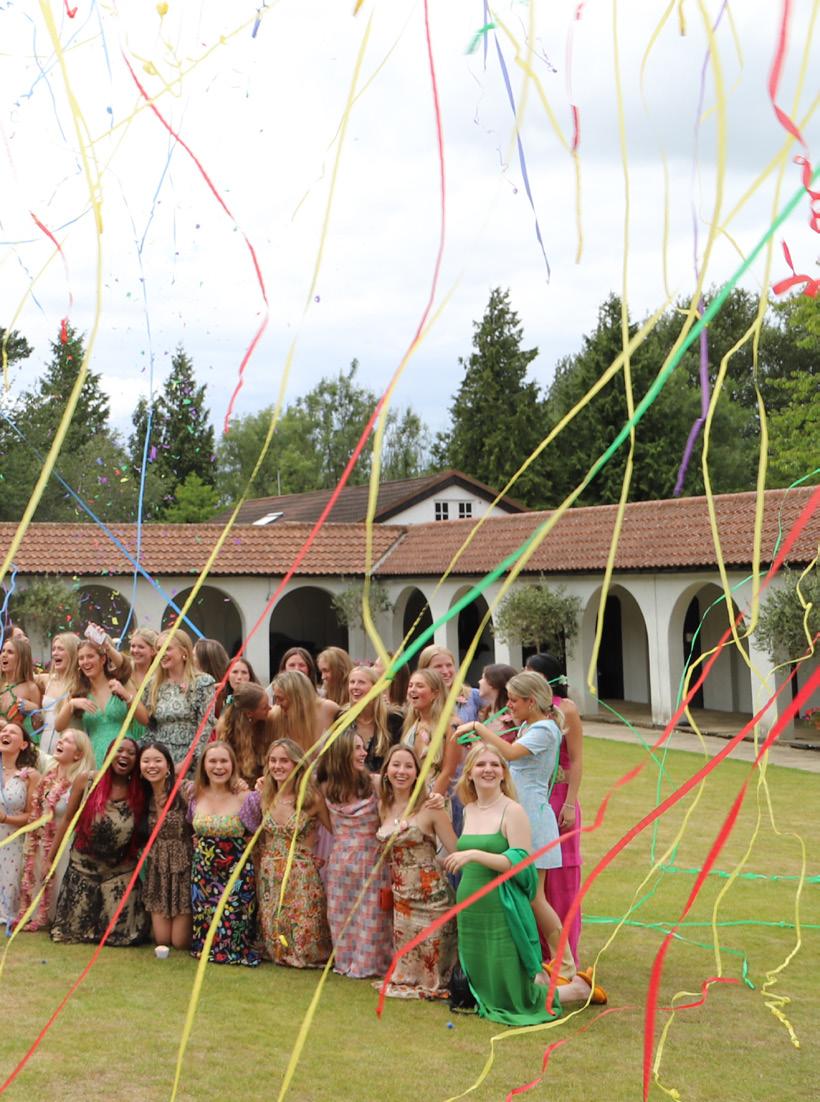 WORDS ALEX BARLOW
WORDS ALEX BARLOW



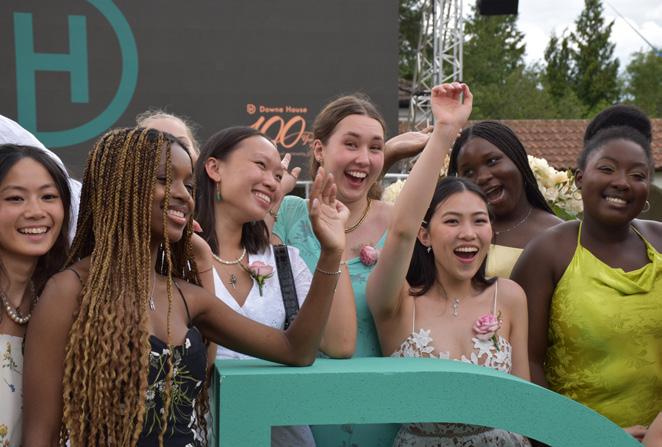
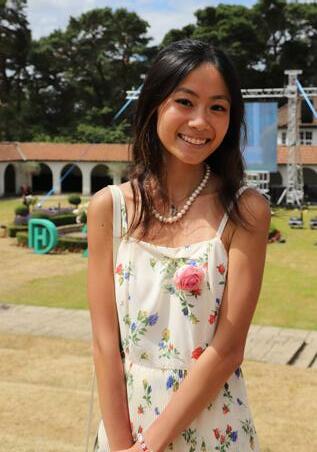
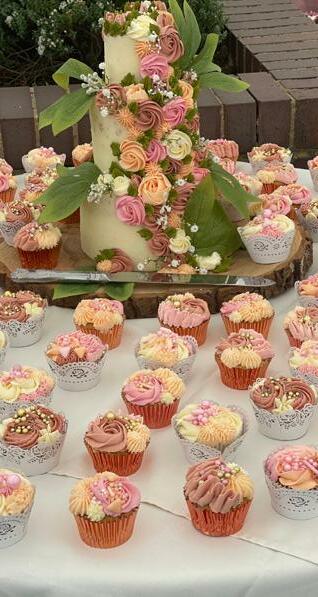
Our guest speakers for the prize-giving ceremony were Olivia Humphries (Scott-Webb DH 2002) and Laura Addis (Palmer DH 2002) who have remained great friends since leaving Downe, having been in Tedworth together and sharing a passion for Drama while at School. Laura studied English at Oxford University and pursued a career in publishing; in 2012, she co-founded a new independent publishing company, Head of Zeus. Olivia has worked in both TV and film as a Casting Director for over ten years, working on casting projects such as Maleficent, Snow White and the Huntsman, Pirates of the Caribbean, The Queen’s Gambit and Fleabag. Olivia received Emmy Awards for outstanding casting for The Queen’s Gambit and Fleabag.
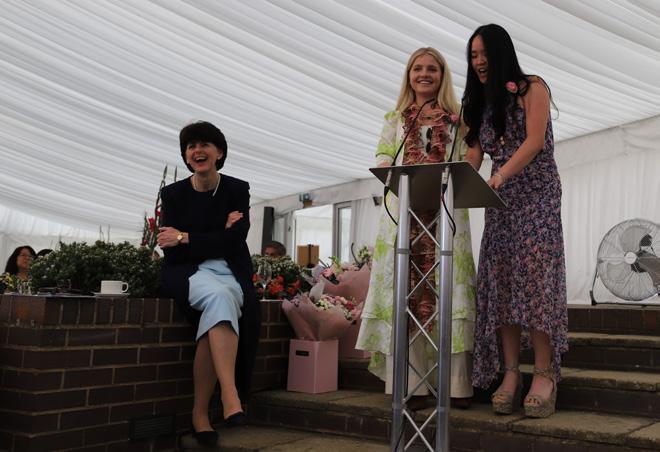
The Upper Sixth girls were piped from the Cloisters to Chapel in our traditional procession for the whole School community to enjoy. Following a Chapel Service for parents and girls, guests enjoyed canapés outside in the sunshine before taking their seats in the marquee for the Leavers’ Day lunch. The catering team pulled out all the stops for a delicious three-course meal and Mrs McKendrick gave a short speech before inviting the Head and Deputy Head Seniors, Lucy Barrie (DH 2022) & Teal Uahwatanasakul (DH 2022), to give their final speech to their year group. Flowers were also presented to the Upper Sixth parents who have had the longest connection to the School, Mrs Barrie & Mrs Biggs.

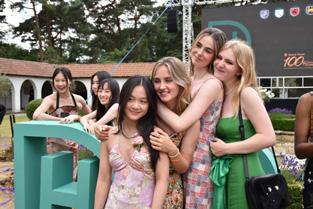

The day concluded with a spectacular confetti and streamer explosion outside in the Cloisters followed by photographs and final goodbyes.
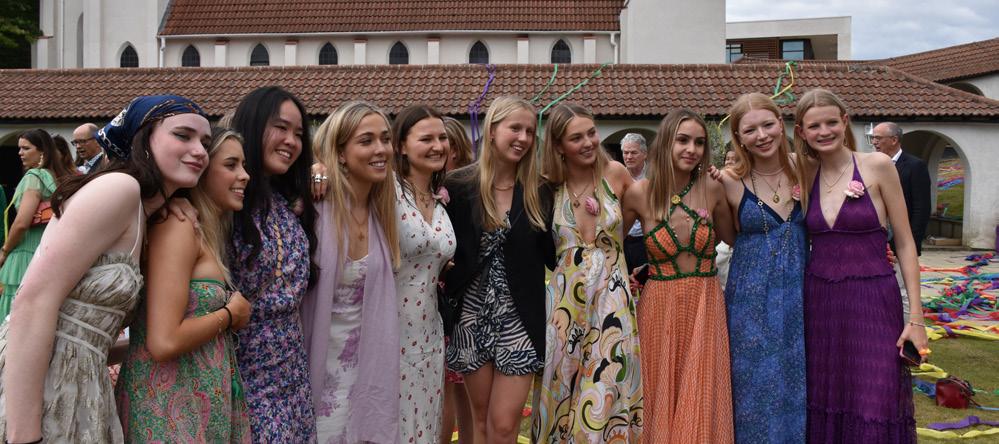
Thanks to the generosity of our alumnae community, the Foundation Office achieved great things in 2022!
We remain committed to building on our DH LINKS programme of events to support our current girls during their time at Downe House as well as our leavers on their chosen career paths.

This year the Olive Willis Prize was awarded to Lauren Raeburn-Ward (DH 2022). This award is given each year to an Upper Sixth leaver who has made an outstanding contribution to school life, through generosity of spirit, kindness, compassionate and care for others.



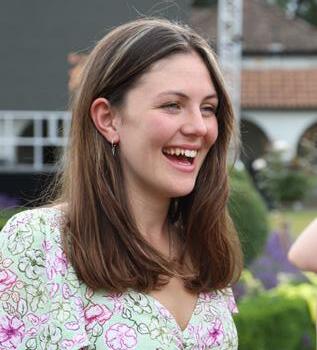
Bringing together members of our alumnae community in Scotland & Northern Ireland.
“Thank you so much for a really great regional reunion, and a wonderful chance to catch up with people we hadn’t seen for years. I was struck, as always, by how much one had in common even with Old Seniors one had never met before.”
Birthday cards are sent weekly to older members of our alumnae community.
“What a lovely surprise, a birthday card from Downe. Thank you all so much for thinking of me. I have so many happy memories of Downe, it has been a huge influence on me all my life, encouraging me to think for myself and to be an individual.”
In May, a small number of our alumnae from the 1940s, 1950s, 1960s and 1990s as well as former staff, were invited back to School for a tour, a delicious school lunch and the opportunity to take part in a special film to mark one hundred years of Downe House in Cold Ash.
Over forty alumnae volunteered their time in 2022 to support our current pupils through our DH LINKS programme. This support included mentoring, giving careers talks and networking, A current parent commented “My daughter was very energised by the DH LINKS event and enjoyed it immensely.” following a very successful professional networking event held at Founder’s Forum in central London in the Summer term.
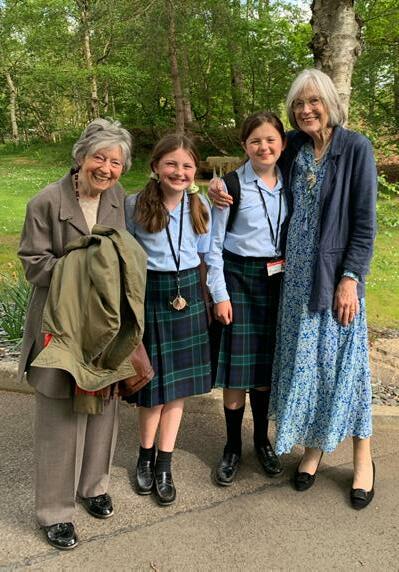

We were delighted to welcome Francesca Merton (DH 2004) back to School for an engaging discussion about architecture with some of our Lower Sixth girls. Francesca shared an illuminating presentation around her work as an architect, having recently set up the 121.Collective during the pandemic which is a collaborative network of young architects who share a special appreciation for craft, community and sustainability. Her portfolio demonstrated how


versatile architecture can be and Francesca spoke honestly and candidly about her journey since leaving Downe House.
After the presentation, we shared an open discussion with Francesca who was able to talk through some careers advice on course requirements and tips for pursuing specific fields of architect which was hugely beneficial to the girls looking to pursue a career in architecture. Francesca was happy to support Gabrielle (UVI) throughout her forthcoming summer school,
which reflects how positive and supportive these events can be for our girls.
Francesca was delighted to see her old school and the visit itself evoked a lot of memories for her. As a special treat, Ms Slocombe (History of Art Teacher) was able to pop in and say hello much to Francesca’s delight as she was a memorable teacher and influential in her decision to become an architect. A fantastic evening, once again showcasing the incredible support from our alumnae community.
Nestled off a quiet side street, away from the hustle and bustle of High Street Kensington, the Founders Forum office had an electrifying buzz of creative energy, full of entrepreneurs busy building their young businesses. This atmosphere set the tone for the DH LINKS event about to take place, where a select gathering of Downe House alumnae were invited to give a presentation on what it takes to be an entrepreneur. We were lucky to have a wonderful space at the venue, kindly arranged by alumna Isabella Boscawen (DH 2013) which allowed a relaxed, collaborative and inspiring atmosphere, perfect for a networking event.
We were fortunate to have six speakers, from a variety of industries to share their experiences and advice on what they felt were important characteristics of being an entrepreneur. Alyx Van der Vorm (DH 2017) was first to take the microphone and talked
On 4 May 2022, a very special DH LINKS event was held in London to shine a spotlight over successful Downe House alumnae and, in their opinion, what it takes to be an entrepreneur.
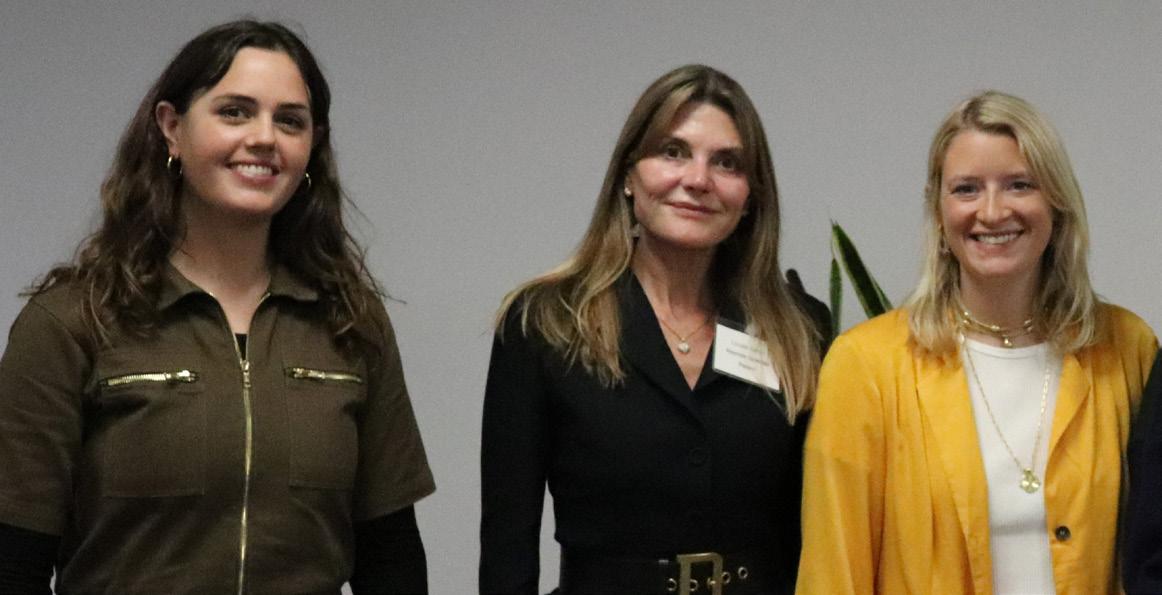

Here we share their inspiring talks.
WORDS EMMA BLACKMANpassionately about her business Clyx. Alyx was truly inspiring, despite being fresh from university and she ambitiously launched straight into her entrepreneurial role in setting up the app Clyx, an online platform to notify and connect friends with events and streamline the way people organise social gatherings. It was refreshing for our students within the audience to see that entrepreneurship can be achieved at any age and that if you feel passionately about something, you should not be afraid to pursue it.
Louise Galvin (Downe House parent) was the next entrepreneur to take the stage, talking humbly about her journey in setting up her haircare range over 15 years ago. Louise touched on the challenges she faced, the resilience needed to be an entrepreneur, but also the wonderful collaborations she had with chemists, designers and her support teams in delivering her haircare brand Sacred
Locks. Louise also touched on the importance of adapting to market trends and thriving in business, a true testament having set up her business 15 years ago.
Venetia Cohen (DH 2008) spoke candidly about setting up her Coco & Kinney jewellery business, exploring how initial dreams and visions began to take shape. Venetia was incredibly honest in terms of recognising her strengths and weaknesses, which helped define her strategies in building her business. It was also interesting to hear Venetia’s vision for the business going forward, particularly being online.
Grace Regan (DH 2009) shared an illuminating insight into being an entrepreneur, summarising three rules to be successful: Number 1: Be a ‘doer’ – be proactive, be a creator and get things done. Number 2: Never stop growing – the importance of having a positive, growth mindset and accepting failure to learn how to overcome life’s
challenges, which in turn will make you a more rounded and open-minded person. Number 3: Look after your mind and body. Grace drew similarities to being an elite athlete, and how
it requires lots of energy to be an entrepreneur and therefore it is so important to look after your mental health.
Katie Cary (Harland DH 2007) echoed a lot of the positive mindset Grace touched on, having set up Rogue Matilda back in 2015. Her vision started with the idea to revolutionise women’s flat shoes into vibrant styles to be worn anywhere. Fast forward a few years later and Rogue Matilda is a recognised footwear brand and winner of the 2019 Drapers Footwear Designer of the Year, a highly coveted footwear recognition.
Finally, Holly Mirza (Kirk DH 1991) wrapped up the presentations by sharing her experiences in co-founding Fabric PR. With a wealth of experience in consumer PR, Holly talked about the challenges she faced in a high-profile career and juggling motherhood, which ultimately led to her setting up Fabric PR. She never looked back and 12 years later, is now running a successful PR
company representing high profile clients such as Scotch and Soda, Crocs and EastPak to name a few.
Having generated so much creative force at the end of the presentations, the drinks and refreshments that followed provided a perfect opportunity for the guest speakers to network and mingle with the audience. We think it’s safe to say that everyone found the speeches inspiring and full of invaluable advice for those thinking about being an entrepreneur. The candid and honest view from each entrepreneur was refreshing and instantly created a rapport with the Downe House girls.
After a short interval of networking and socialising, the event concluded with special goodie bags for the attendees, filled with supporting merchandise donated by the guest speakers which seemed to be delightfully received by the recipients and a lovely way to conclude the evening.
DH LINKS offers careers-based networking opportunities for current pupils and alumnae. These events offer invaluable support for our current pupils to engage with industry-focused individuals and potentially leading to mentoring or work shadowing experience.
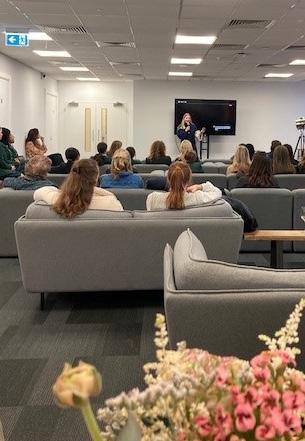
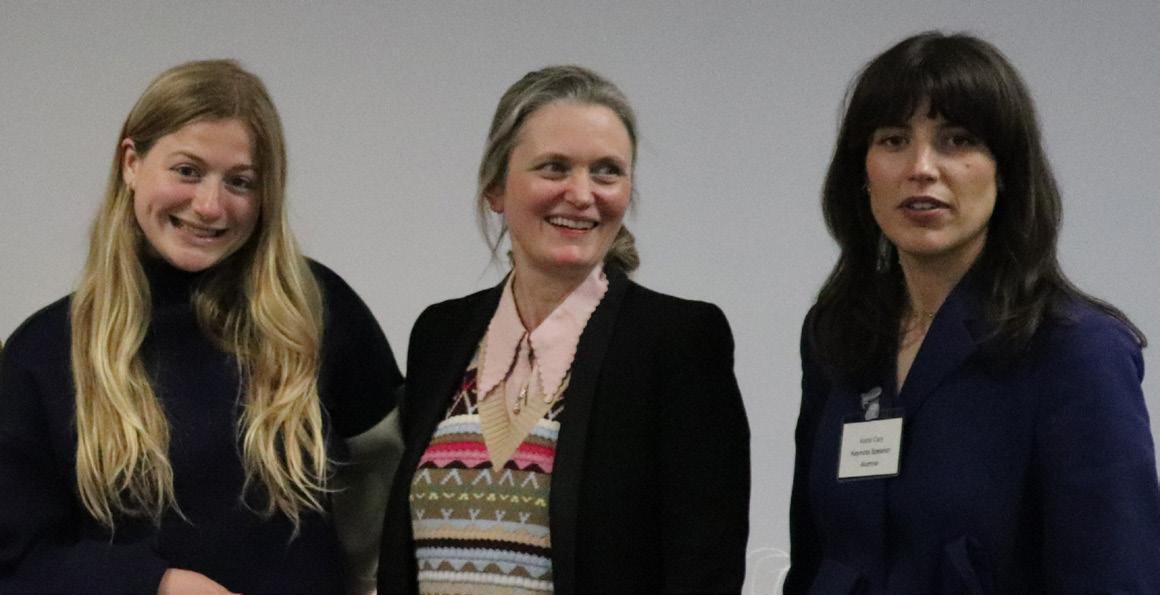
If you are interested in hosting or participating with our DH LINKS programme, please do get in touch
Email: foundation@downehouse.net Tel: 01635 204740
We would like to extend our kind thanks to Isabella Boscawen (DH 2013) for allowing us to host our DH LINKS event at The Founders Forum

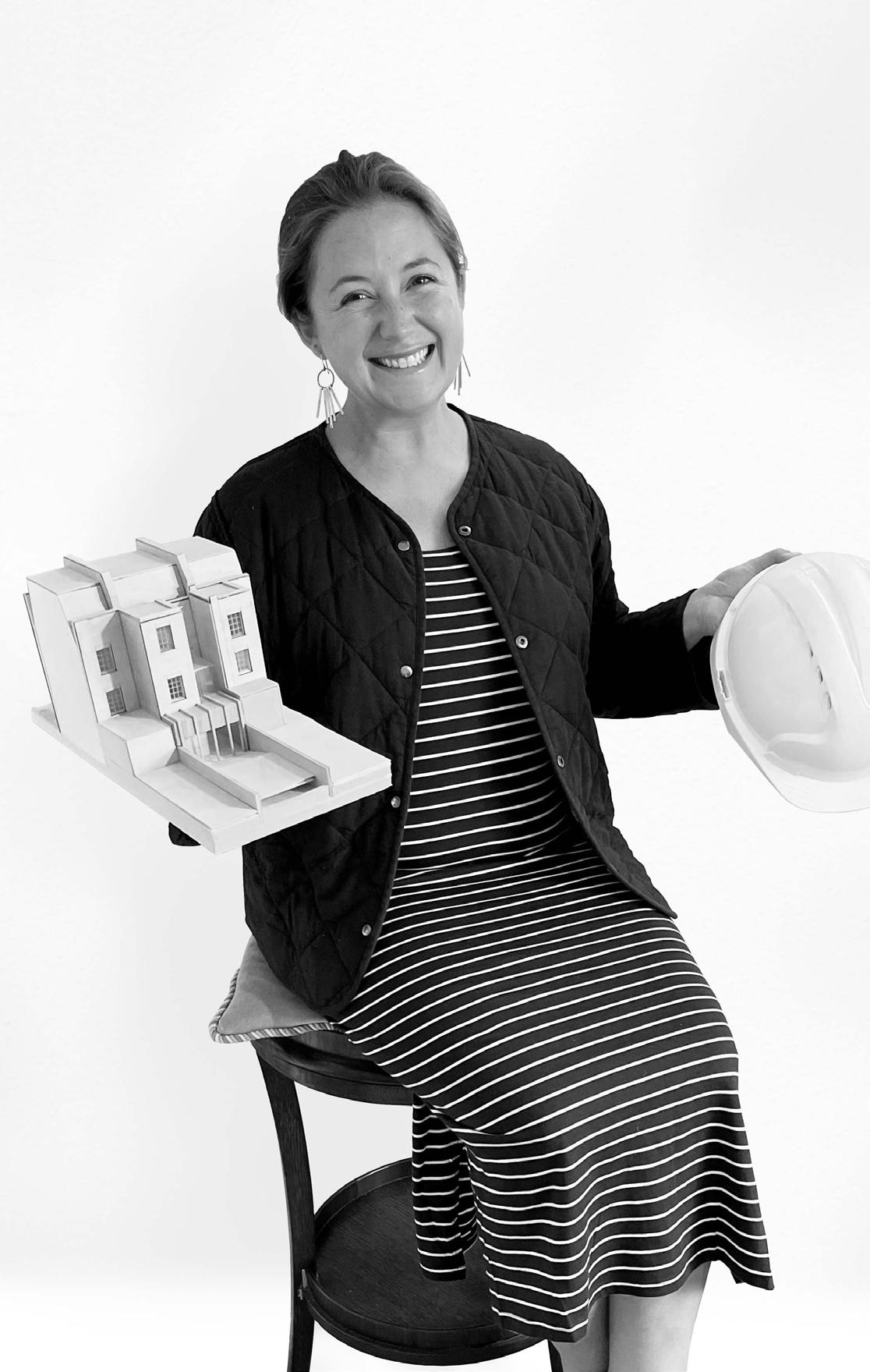
Tell us about your time at Downe House?
I started life at Downe House in 1998 as a fresh-faced and rather timid Remove, and graduated from UVI in 2005 full of enthusiasm, confidence and determination. I loved my time at Downe House and made some incredible friends. The support from teachers and friends gave me the confidence and courage to tackle anything, something that has stayed with me to this day.
What career did you envisage for yourself when you were in the Sixth Form? How does it compare with your career now?
I always knew I wanted to do something creative. I was happiest in the Art Room and Music Block at school but was utterly hopeless at Maths and Physics, despite a lot of time and effort from some very patient teachers! I mulled over studying Architecture or Fashion Design and decided to go for Architecture as it seemed like a great way to harness my creativity, give something back to the wider community and forge a career where I could financially support myself.
There was definitely a worry that my lack of prowess in Maths and Physics would hold me back, but where there is a will there is a way and for me it was about finding an Architecture course suited to my skills. This ended up being the course at the Edinburgh College of Art which I loved.
When I was in Sixth Form at Downe I envisaged a career in Architecture being purely about buildings, but I have been surprised and pleased to learn over the years that it is about so much more. Architecture is part art, part science, part geography, part history, part psychology, part everything really. It requires empathy and emotional intelligence, in equal measure to technical ability and accuracy. Architects simultaneously always have an eye on the past and an eye on the future.
How did your passion for Architecture begin?
I don’t think I realised it at the time but my passion for Architecture probably began in the Downe House Music Block and Performing Arts Centre of all places! The things I loved about playing music and helping produce things like the AGS House Drama are the things I love most about Architecture –a sense of community, team spirit and expression of human narrative.
Describe a typical day for you.
An early start (I’ve always been an early bird!). I will do a quick check of my emails to see if there is anything urgent that needs dealing with before setting out for a walk or quick potter around the garden. My mornings are then generally used for creative design (with emails turned off).
Afternoons are more meeting and project admin focussed, filled with design presentations to clients and meetings with design team members and builders. I often don my hard hat and high-vis jacket and love seeing my designs coming to life on building sites.
In running your own practice, tell us about one of your most exciting projects.
I qualified as an Architect in 2014 and have worked on lots of different types of buildings, from one-off theatres to giant office buildings to small crafted private houses.
I am currently working on an exciting project for a young couple in north London. It’s their first house and a wonderful old hulk of an Edwardian building that has had very little done to it for over 50 years. The refurbishment of the house, extension and garden design all hold environmental sustainability at their core. The design utilises supersustainable timber and green low carbon concrete to create a series of spaces that are suitable for modern living, celebrate the historic fabric of the existing building and provide adaptability for future family life.
What is it like to be an architect in today’s world?
Wonderful! As an Architect you play a key role in a diverse team of people united in the venture of building buildings. Now more than ever architects also have the skills and responsibility to build efficiently and beautifully to help address our local and global climate emergencies.
What has been the biggest challenge you have experienced in your career?
Making the leap to set up my own practice after working in a large commercial firm and having to learn very quickly how to run a business.
I have made plenty of mistakes along the way and am constantly learning.
As an Ambassador to the Architects Benevolent Society, tell us a little about your role.
I became an Ambassador to the Architect’s Benevolent Society (ABS) in
2017 when they launched their mental health support network. The ABS are a fantastic charity which provides essential support to architects, their families and Architecture students in times of need. My role specifically involves linking students and schools of Architecture to the services that the ABS can provide them with, also helping with lots of fun fundraising and community activities.
What advice would you give to Downe House leavers looking to pursue a career in Architecture?
If you are thinking about taking a gap year but are being put off by the length of the Architecture course – don’t be put off. Take a gap year! I chose not to take a gap year as I thought I would be “ancient” by the time I qualified. Maybe it’s my mid 30s talking, but I definitely wasn’t “ancient” when I qualified and in hindsight, I wish I had taken a gap year before studying.
Don’t be afraid of getting it “wrong” when you’re drawing or designing. Sometimes the best most exciting creative ideas can come from so called “mistakes”. A drawing or design doesn’t need to be perfect and it certainly won’t be first time. Architecture is an iterative process and requires drawing things again and again to test and finesse ideas.
What are your aspirations for the next five years?
The end of 2022 is going to see the arrival of a new and exciting project in the form of my first baby. Mini
Fothergill-Wilson is due towards the end of December! Therefore, life is going to change quite a bit in the next five years, I think! I am looking forward to seeing what motherhood brings and continuing my architecture practice.
I’m sure there will be challenges, highs and lows but I know a good dose of courage, humour and determination will help us on our way.
Finally, please indulge us with a random fun fact about you!
I’m a bit addicted to cold water swimming. I got into it with a friend five years ago when we decided to do a swim for every month on the year of our 30th birthday. We’ve never looked back!
What career did you envisage for yourself when you were in the Sixth Form at Downe House? Have you always had an interest in engineering?
Having committed to doing Maths, Physics and Design & Technology for A Levels, I have always envisaged myself being involved in something creative that required technical input.
I have always been interested in architecture and my curious mind would often wonder how things work and how structures are built, etc which I suppose is essentially what engineering is.
What has been your career path since leaving Downe House?
I graduated with a Masters in Civil Engineering from the University of Warwick. I then got sponsored to complete an MSc in Tunnelling and Underground Space the following year.
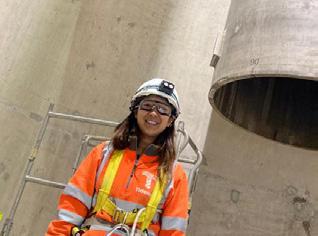
I started as a tunnel design engineer and worked on the Putney package of the Thames Tideway for two years. The project upgrades the existing Victorian sewer that was built in the 1860s to accommodate the increasing population in London, to stop future sewage from overflowing into the River.
Having worked in a consultancy for two years, I moved on to work on a highways project and high voltage electricity substation for the National Grid and Highways England as a design manager to bridge the gap between designers and constructors.
I then realised I wanted to be part of the operational delivery team to help build the structures, so I found the opportunity to return to Thames Tideway to bring the designs that I was involved with to reality. I spent the past year and a half wearing a high-vis jacket and a hard hat everyday, travelling via our own transportation system under the River Thames.
Describe a typical day for you. Typical day involves a morning briefing to provide the construction team/ operatives with an overview of what their day will entail. Depending on the lead time, I usually liaise with the planning team a week or days before to make sure the men have all the required materials and equipment in place to carry out the works required.
For the majority of the day, I would be present on site to make sure the operatives are adhering to all the safety measures outlined in approved documents.
Describe some challenges you have faced in your career?
I found it challenging at the start to adapt my style of delivery to effectively communicate with a wide range of target audiences within different disciplines of the design teams, different functions within the project team, labourers and clients from different countries, commercial team and sometimes, the
general public who are furious about the ongoing works outside their residence.
What words of advice would you give to young girls who wish to pursue a career in engineering?
The perception of what engineering entails is almost certainly different to what it really has to offer. It is an amazing industry with opportunities in planning, quantity surveying, commercial management, stakeholder engagement, traffic management, engineering management, surveying, computer modelling, electrical engineering, architecture, project management, the list goes on!
The best way to discover your pathway through engineering is to do work experience, look into industry placements and apprenticeship opportunities because there is always a high demand for engineers, everywhere you look.
Companies are always keen to take on work experience students and apprentices as it is also one of their compulsory key performance indicators (KPI’s) that need to be reported.
I have been working very closely with CITB (Construction Industry Training Board) and various local councils to help promote STEM subjects. “Goconstruct” is a very good interactive and informative website with a lot of details on industry-wide opportunities.
Finally, please indulge us with a random fun fact about you! I can lick my elbow.
INTERVIEW EMMA BLACKMANThe best way to discover your pathway through engineering is to do a work experience, look into industry placements and apprenticeships opportunities
Tell us about your time at Downe House?
I joined Downe House in Remove back in 2010, and throughout the seven years I spent there I was lucky enough to meet some wonderful people and get to have great experiences. My fondest memories are centred around the musical opportunities I had at Downe, including learning to produce music with Dr Alexander, my love for performing with Miss Grandi, and travelling to Prague for our choir trip!
Can you briefly describe your professional journey since leaving Downe House?
I had a strange start to professional life, I decided to work in event operations as an assistant during what was meant to be a gap year but I grew to love it so much that I never left! Eventually, having dropped my university place, I studied event operations for a year, left with a placement at a conference company where I was persuaded to join the marketing team – and I’m so glad they did!
Over the next three years I worked up from a Marketing Assistant, on a variety of B2B conferences including Gambling, Defence & Security, Renewable Energy and most recently I moved into Life Sciences as a Marketing Manager
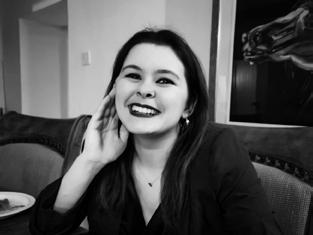
Tell us about your current job and describe a typical day I’m super-happy to be in a job where there is a hybrid option, so I can enjoy both working from home and seeing my colleagues in the office. Whilst conferences have a cyclical campaign, each one is slightly different in terms of what audiences interact with, so I get to be creative with each strategy and the channels I use. A lot of my job is cross-departmental collaboration with the sales and production departments to make sure that I am sending out the correct messaging via emails, social
media and our website, so in turn creating good quality leads to convert into event bookings or sponsorship.
What are the most valuable skills for someone to be successful in your career field?
The top three skills I’d say would be time management, creativity and being data centric. Time management because regardless of B2B or B2C campaigns, you’ll most likely be running multiple projects at the same time all at different stages in market, so knowing when to prioritise is essential. Creativity, for a job that will centre heavily around data, there are always ways to improve and test different strategies and channels to make sure you’re optimising your budget and getting the best ROI. Plus, you get to work on the more brand led type of creativity with your website, email styles and collateral designs –the ‘fun’ bits!
What have been some of the biggest challenges you have had to overcome in your career?
I think anyone who was working during the pandemic and would have their own struggles from it. Mine was being put on furlough. It seemed like an exciting thing at first, but I ended up feeling such a loss of purpose. Having worked straight out of school, suddenly not having anything to do every day really affected my mental health, so not long after I volunteered with a couple of charities and that kept my brain ticking and in return helped relieve pressure for both charities.
If you could go back to your younger self, what piece of advice would you give yourself?
The first big one is going to university isn’t the be all and end all. There was such a pressure that you need to do your A Levels, get into a Russell Group University and then you get a job in the City. Of course, going to university is a fantastic opportunity, however, for me personally, not going to university has actually worked out better.
Finally, please indulge us with a random fact about yourself!
I guess because I’m in a fitness training regime, the first one that comes to mind is that by the end of 2022 I will have run more km than there are days in the year, with my end target of 407km.
Reach out to people who do things that interest you, I’ve made such great connections, and landed some freelance jobs on the side just by going after what I wanted, and if you prove yourself they’ll keep using you!
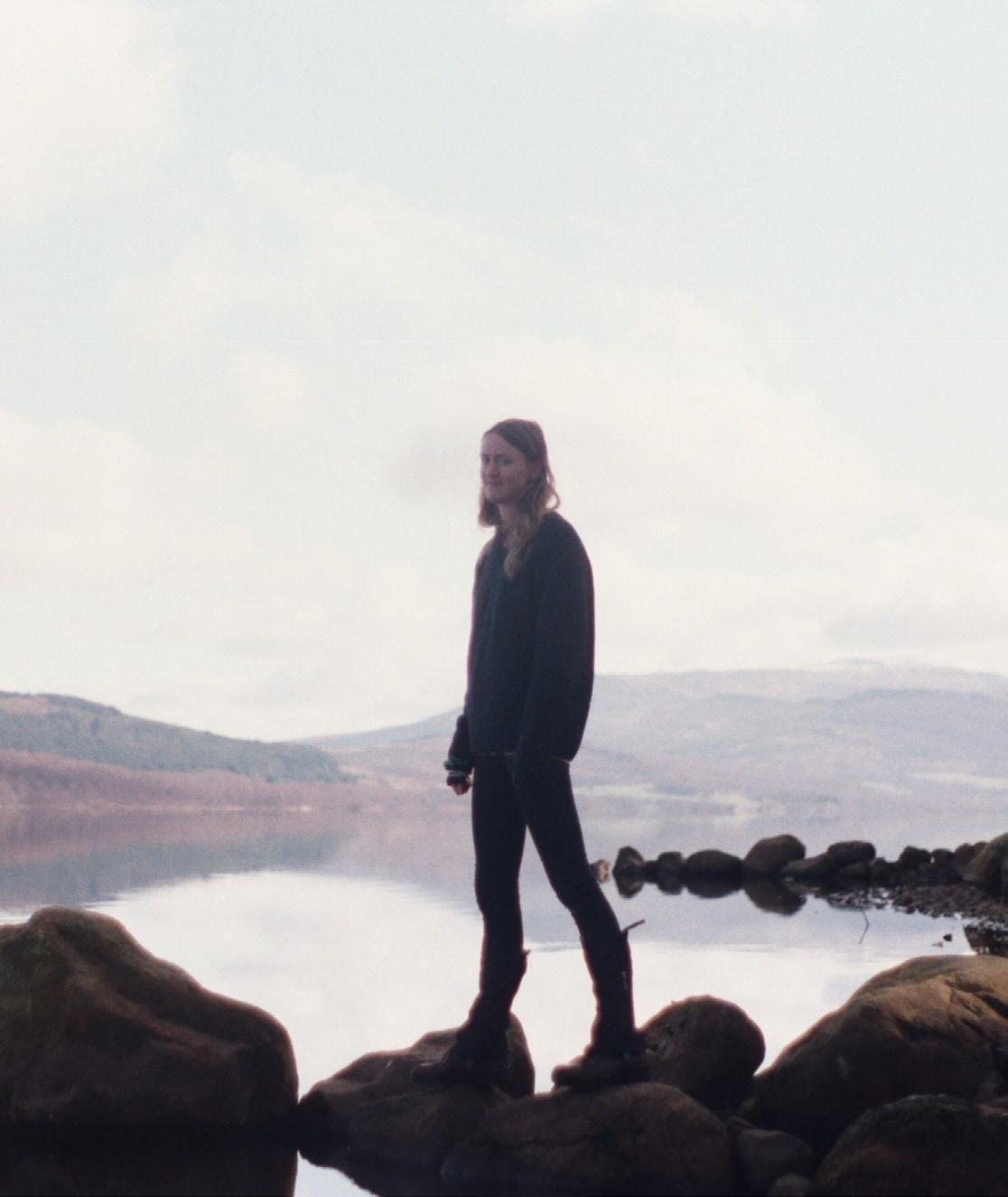 INTERVIEW EMMA BLACKMAN
INTERVIEW EMMA BLACKMAN
I was at Downe House for seven years, which spanned some quite tumultuous teenage years, but I managed to come out alive and with some amazing friends. We had our 10-year reunion a few weeks ago – there’s nothing like catching up with the people you went to school with!
What has been your career path since leaving Downe House?
I studied Philosophy & English Literature at Newcastle University, after which I got a job (after working for a few start-ups) working in marketing and administration at an environmental NGO, Forum for the Future. Absorbing understanding on the pervasiveness of environmental degradation and its interaction with business and societal activities, I decided to leave to pursue nearer term solutions.
I latched onto seaweed as a scalable nature-based climate solution and went on to study an MSc in ‘Climate Change: Managing the Marine Environment’. Ahead of the MSc, I worked in the Faroe Islands on the biggest seaweed farm in Europe, harvesting and processing the summer seaweed crop. During that MSc year I studied human and climate impacts and carbon sequestration on/in marine environments. I picked up useful technical skills including conducting biodiversity surveys, scientific scuba diving, mapping, writing papers and data analytics. I wrote my dissertation on the integration of blue carbon storage with offshore wind farms in the North Sea.

After having a brief spell as a freelancer, I got a job at Forest Carbon. Instigators of the UK voluntary carbon market, Forest Carbon has been developing carbon standards since 2006 to open the flow of private investment from businesses into tree planting and nature restoration. I now work as a Project Manager, helping farmers and landowners to get new woodland planting and peatland restoration projects funded through carbon finance. We certify the projects with government-backed carbon standards to generate credits to sell to businesses. With standards now developing for UK marine environments –I am hoping to start working this mechanism to drive restoration in marine environments.
Describe some challenges you have faced
I think the biggest challenge was getting through the melting point of understanding what climate change meant for everything and shifting away from the death march mentality to a place where I could channel this care into the pursuit of tangible solutions.
What words of advice would you give to young girls who wish to pursue a career in environmental sciences? Do it! Not being behind a desk all day and doing something positive for the world feels good. There is also a huge
skills gap at the moment, we need so many more trained and skilled people in this sector, its requirements and size are growing very quickly and having people who understand the technicalities is paramount to the success of any project.
What are your aspirations in the next five years?
I hope to be working on more marine restoration projects.
Finally, please indulge us with a random fun fact about you!
I have a VW T25 Autosleeper Campervan called Clive.

doing some positive for the world feels good, how scientific research can support climate change is so important in our changing world

We were delighted to see the return of the Class of 2011 at the beautiful kitchen and bar venue in Parsons Green.
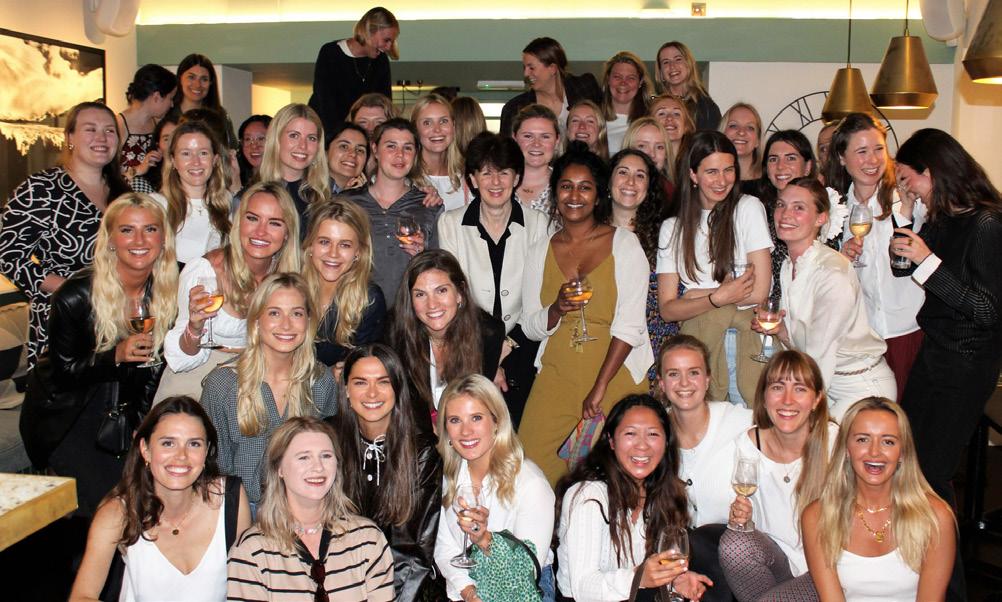
Over 40 girls from the year group reunited to catch up and reminisce memories of Downe House.
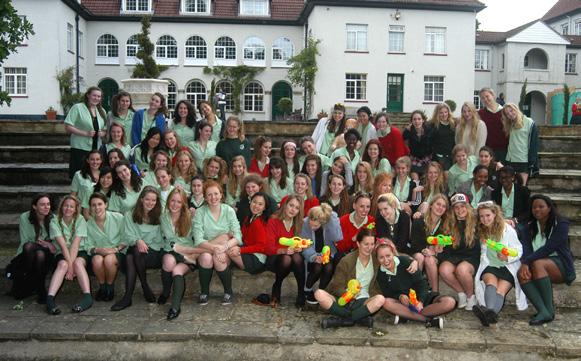 WORDS EMMA BLACKMAN
WORDS EMMA BLACKMAN
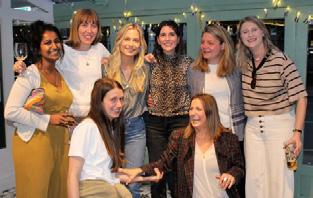
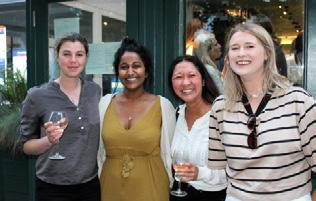


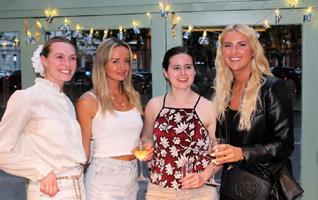
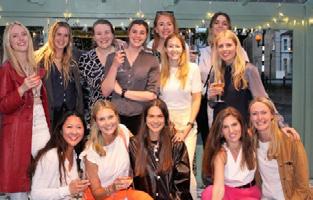
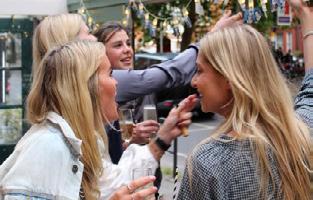
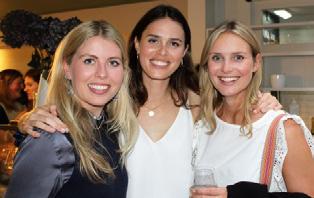
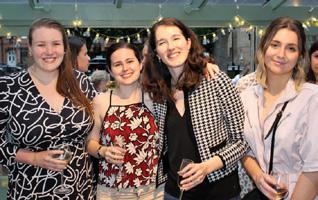
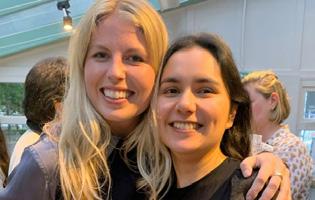
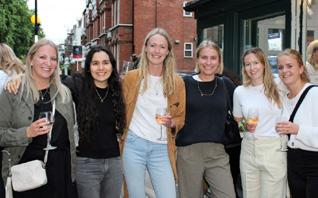

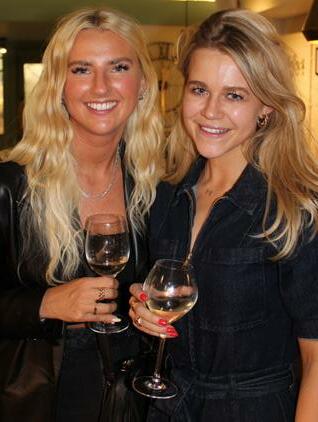
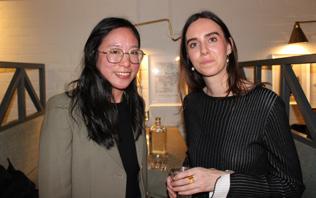
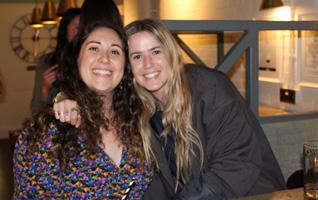
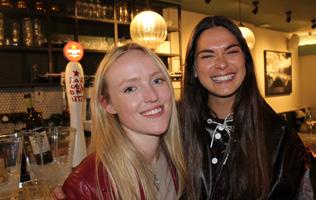
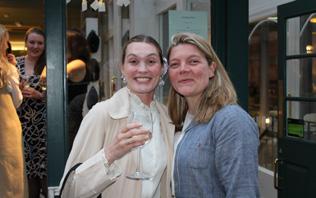
“Huge thanks to Emma and Alex for organising last night. Everyone I have spoken to said that they had a wonderful time and, needless to say, many long-overdue supper catch ups have been booked in as a result.”
Charlotte Dixon (DH 2011 Head Senior)
On Saturday 2 July, we were delighted to welcome back girls from the Classes of 1995, 1996, 2000 & 2001 to celebrate their 20 and 25 year reunions. The reunion was held in The Murray Centre in the heart of the campus, a new sight for many of the alumnae returning to the School.
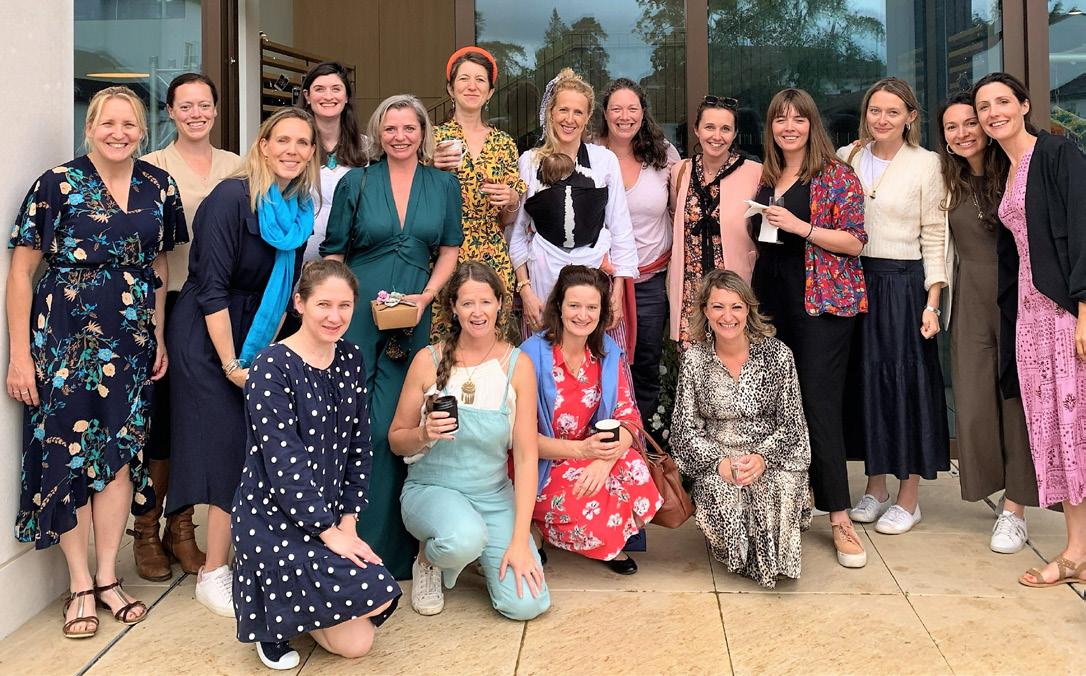
Amongst the Art that was fortunately still exhibiting in the Murray Centre from Founder’s Weekend, it was wonderful to see the alumnae catching up with each other and members of staff. Our guests enjoyed a glass of fizz and a beautifully curated picnic box along with some rather decadent cakes, provided by the local café: The Blackbird. Guests brought their families with them, much to their delight, to experience and see the School for themselves.
Groups were treated to an insightful tour of the campus by current pupils, Grace (UVI) and Yasmin (UV) and swapped stories from their own recollections of being at Downe House.
We are already looking forward to the next series of Reunions which begin in the Michaelmas term.
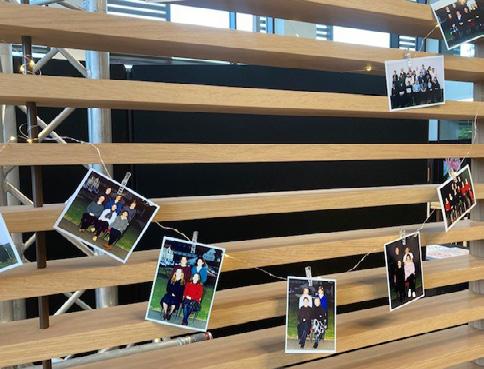

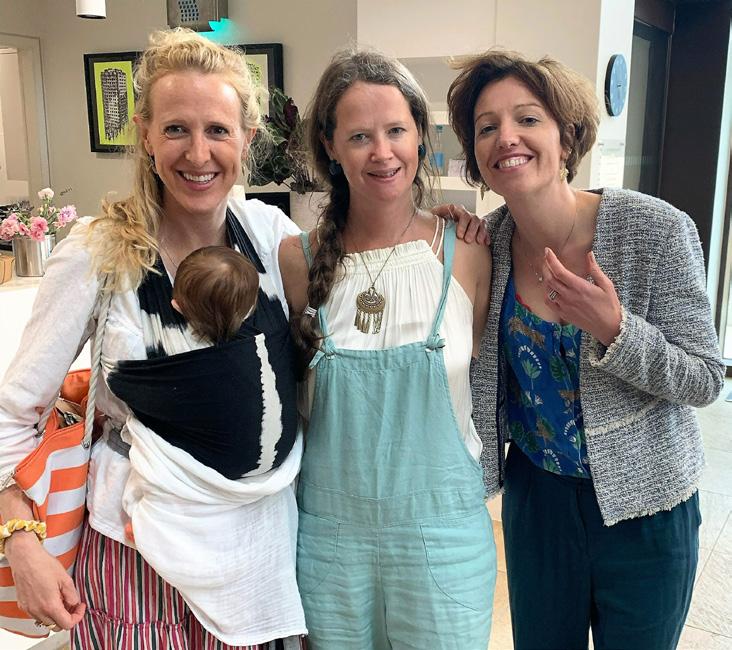
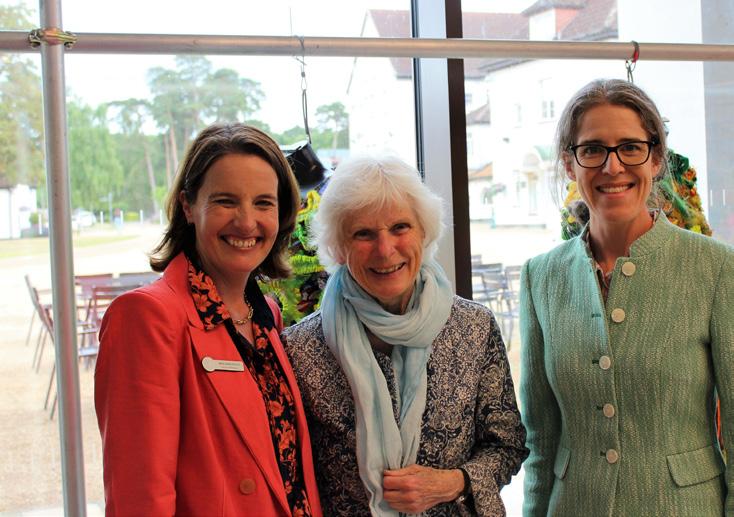
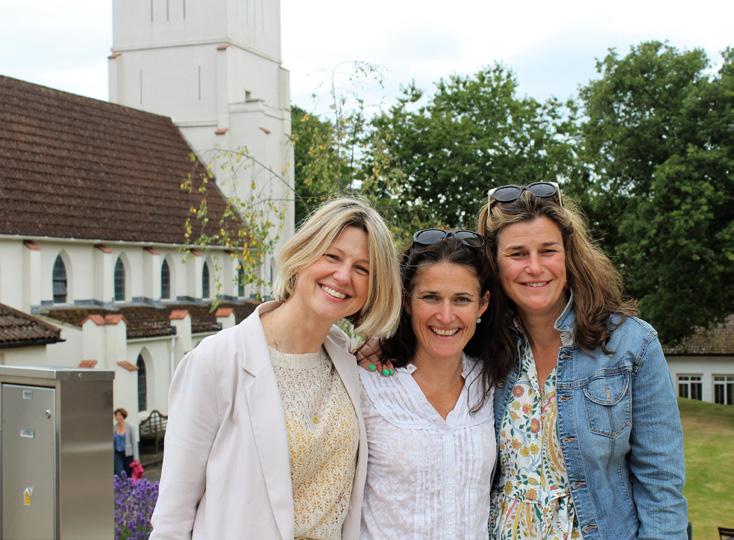
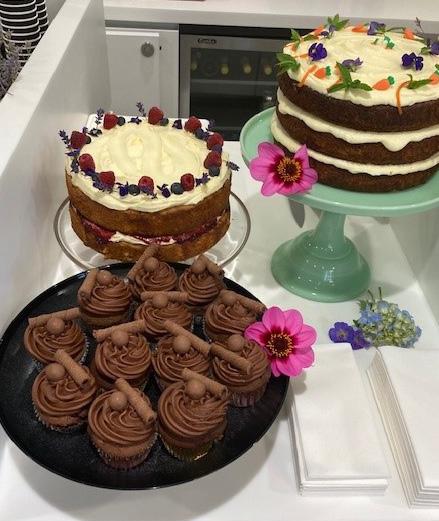

In the spring, several members of the Downe House alumnae community came together for a Regional Reunion at the magnificent Inveraray Castle – the fairy tale home of the The Duke & Duchess of Argyll, a place steeped in history and nestled on the banks of Loch Fyne.
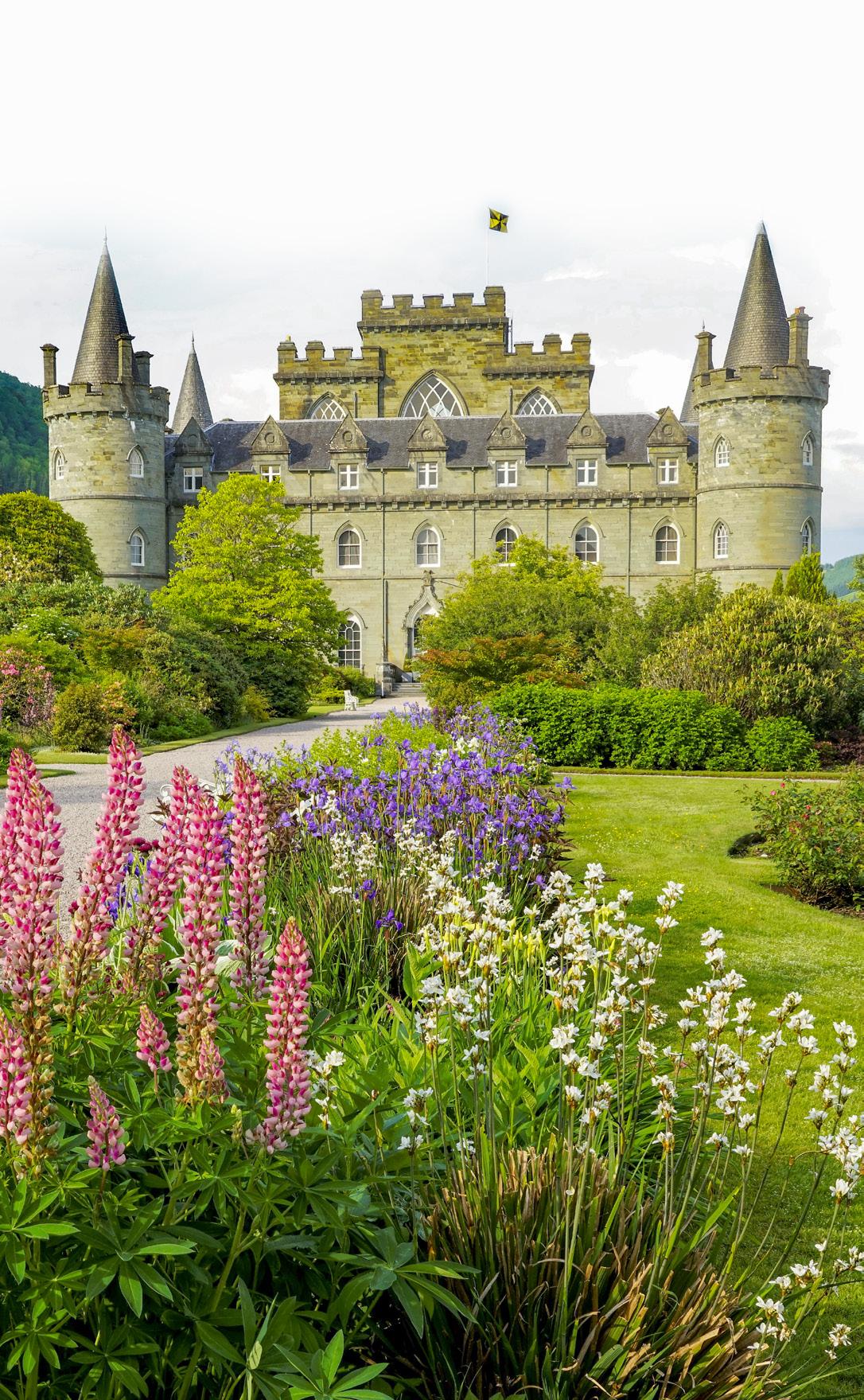
It was a real privilege to be part of this special occasion, and it was such a success. My thanks go to Eleanor Argyll (Cadbury, DH 1991) for creating a bespoke event for our 17 guests, who ranged in age from 44 to 94. Eleanor was very generous with her time and gave us a fascinating tour of the Castle, which included behind the scenes access to many of their private rooms. We all sat down for a delicious lunch in their private dining room, which was extremely noisy and jolly. After lunch we had a group photograph in the beautiful grounds, and we enjoyed the opportunity to explore the gardens before we all parted company.
“What a fabulous Downe House reunion you organised at Inveraray! It was very special indeed, because of the fabulous location of course, but also the joy at seeing Eleanor and Lucy again and meeting other old Downers who live in Scotland.”

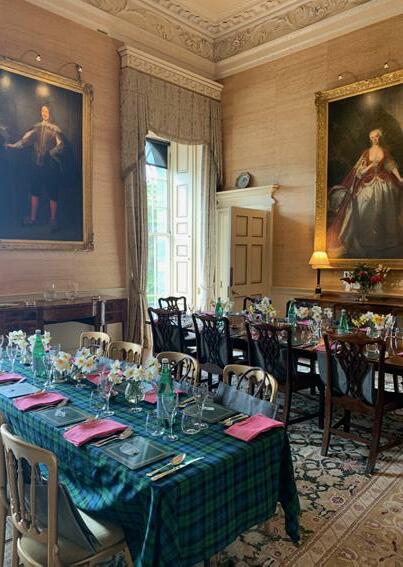
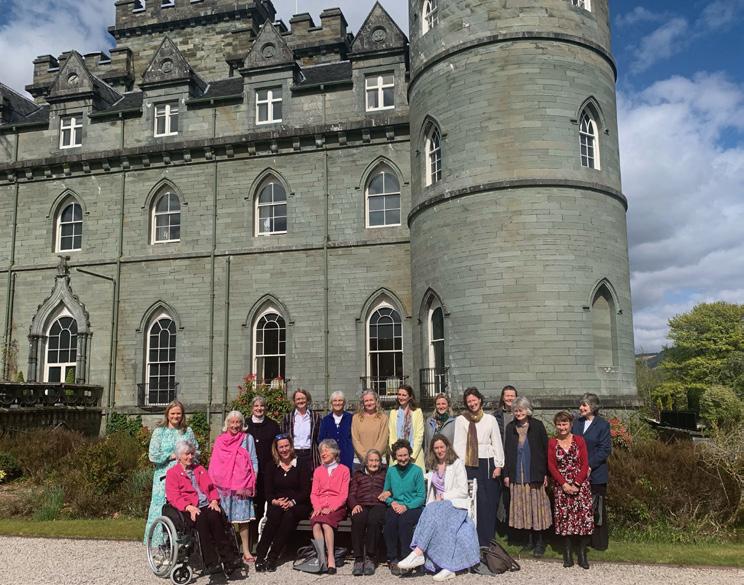
Eleanor Argyll (Cadbury DH 1991) Pictured below
WORDS LOUISE PETOLouise Burnet (Glanville DH 1977)
Shuna Colville (Denholm DH 1975)
Susan Cunningham (Ewart DH 1966)
Elspeth Fleming (Marshall DH 1970)
Heather Galbraith (DH 1947)
Joanna Grant-Peterkin (Young DH 1965)
Ghislaine Kennerley (Galbraith DH 1975)
Sophie Lindsay (Camu DH 1994)
Sara McCorkell (Galbraith DH 1969)
Fiona McNeill (DH 1993)
Natasha Meynell (King DH 1991)
Carolyn Normand (Arbuthnott DH 1973)
Lucy Ogilvie (Mackenzie DH 1994)
Elizabeth Ranson (Greig DH 1958)
Sylvia Sandeman (MacLehose DH 1966)
Libby Shaw (Gibson DH 1957)
Alex Barlow (Director of External Relations)
Louise Peto (Alumnae & Events Officer)
Our thanks to all those who attended:
Celebrating Lulu Urquhart’s (DH 1993) success in achieving Prize Winner at the Chelsea Flower Show this year for her Rewilding Garden.
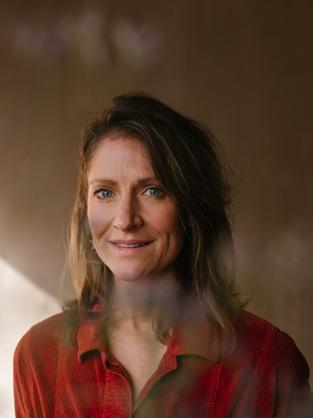
U rquhart & Hunt’s A Rewilding Britain Landscape at Chelsea Flower Show reveals the key role that beavers play as ecosystem engineers in landscape restoration
Beavers are natural rewilders. Their dams filter water and variegate flow, cleaning streams and allowing slow pooling. These pools, and the nature-rich wetlands that develop alongside them, support many other species – amphibian, vertebrate and invertebrate – allowing ecosystems to repair and recover. The ponds, regenerating trees and marsh grasses all act as a vital carbon sink, whilst also alleviating flooding by holding back storm water flows.
In Britain we’ve been slow to welcome back these habitat-creating, flood-preventing animals, after 4-600 years of extinction; but reintroductions are on the increase, bolstered by a
government announcement last week about the rewilding of London that will include releasing beavers into the marshes around the periphery of the capital.
Working in collaboration with the charity Rewilding Britain, landscape designers Urquhart & Hunt chose to make beaver activity the core of their garden at RHS Chelsea Flower Show this year.

The garden shows a rewilding beaver habitat in the south west of England. A brook flows beneath a west-country crafted dry-stone wall, under a woodland edge of hawthorn, elder, viburnum, hazel and field maple. Beavers have entered the landscape and built a lodge and a dam which has altered the water course and created the first large pool in the garden.
The lodge, built around a white willow (salix alba) is the beavers’ family home and within it are several
chambers and even a swimming pool for their young kits to learn to swim before they leave the lodge for the first time.
Below the dam, made entirely of beaver-gnawed sticks, there is evidence of the beavers’ activities: a beaver feeding station with “chopsticks” that have had all their bark nibbled off; felled trunks, that are either decaying or regenerating; beaver “chips”, left where they have chewed away the wood in the felling process; a muddy canal made by the mammals as they pull logs and materials to and from different dams; and beaver footprints in the muddy banks of the stream.
Beavers are nocturnal, sleeping in their lodge during the day, so sightings are rare, but a hide, equipped with binoculars and wildlife reference books, has been built over the stone wall, with a view to the lodge and dam,
for anyone keen to sit and spot the wildlife occurring in this flourishing and bio-diverse nature scape. The hide has been built from reclaimed elm and oak timbers and from corrugated iron taken from an old, dismantled barn.
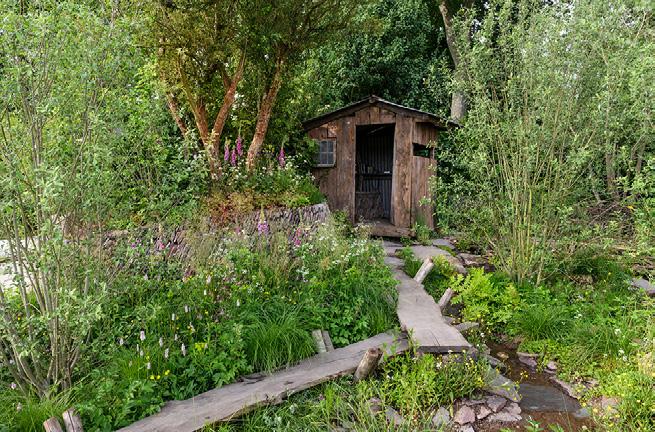
The fresh, clean water flowing faster from one side of the dam exposes gravel known as ‘redds’ and provides perfect conditions for fresh water fish to spawn.
You can spot a water-vole lawn further down the quiet stream, with holes in the bank where the voles would be living. They use the canopy cover of young regenerating trees, like the wetland loving Goat willow (salix caprea) and mature grasses like the greater tussock sedge, (carex paniculate) as protection from predators. Water-voles and otters thrive alongside beaver habitats, with blooming plant colonies and fish stocks providing food and safe places for their homes.
Approximately 3600 native and naturalising plants have been grown for the garden – a challenging feat, many grown from seed or in specialist water plant nurseries and all in peatfree soils. Native wildflowers mingle with grasses in the garden’s varied
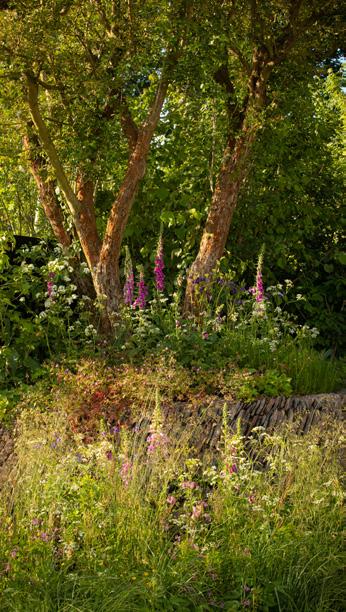

planting zones, while pretty native marginal plants establish along the edges of the pool and streams. The palette reconnects us with our own landscapes and the jewels found in our native plants. The planting style informs their natural growing habits and colonies, subject to moisture levels and furthermore a chance to observe the way native insects use them.
Urquhart & Hunt felt that it was crucial to bring sound into the garden: “One of the staggering experiences of a rewilding area is the sound, so we have collaborated on the creation of a soundscape that features noises long lost, but possible to recover, with ecological restoration and the reintroduction of keystone species,” they say. “The aim is to show melodies of a future landscape alive.”
They continue: “The inspiration for A Rewilding Britain Landscape came from us seeing, at first hand, the incredible abundance and diversity that appear in beaver habitats: the perfect imperfections of nature in balance with habitat emergence and species flourishing. Our journey in the making of this landscape has made us more passionate than ever about bringing the rewilding message to a
wider public. Ours really is a message of hope, showing how rapid ecological restoration can be, when given the space and right conditions for the land to evolve.”
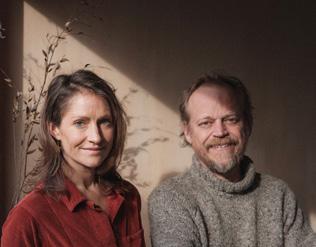
Post-RHS Chelsea Flower Show, all the plants from A Rewilding Britain Landscape went to awardwinning, nature-based health and wellbeing charity, Lindengate. Based in Buckinghamshire, thousands of people of all ages and cultures are welcomed to learn and benefit from nature as a teacher and healer, particularly young people and those working in support services such as the NHS and schools.
For further details please visit
Photograph: ©Tammy MarlarAfter two months of intense training, Izzy Huber (DH 2018) tells us about becoming ‘The Bristol Fighter’ and her journey on raising awareness for mental health.
The first time I was really hit hard was quite a funny, yet shocking experience. I rocked up to the Saturday sparring session, which is for the general public as well as Bristol University students training for the Bristol boxing event – the Bristol Fighter. Alas, no girls had attended the session and one of the guys leading the session pointed at me and an older man, “You two! You’re together.” I didn’t really think much of it as I was now used to training with another guy; if anything, I preferred it as it meant I could really train. “Go easy on me,” he said chuckling. “Of course,” I said, in my head I thought why would I go all out?

As a former Downe House girl, the mantra, ‘strong, independent woman’, has stayed with me throughout. We used to say the phrase ironically, now I can say firmly that Downe taught me to be just that. Countless hours training for athletic matches, as well as for cross-country and lacrosse, certainly paid off. Moreover, the variety of sporting
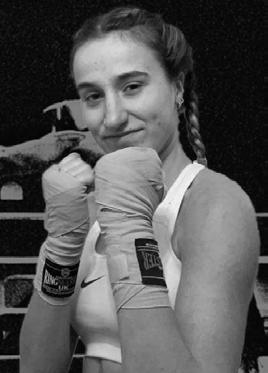
activities that we had access to at Downe House, such as squash, tennis, swimming and so on, clearly aided my ability to throw myself into any sport.
I guess my first real lesson in perseverance came around when I and a few other Downe girls decided to bike from Downe House to London with a few of the sports teachers. We did this solely for a challenge. This challenge taught me how to train, I remember spending a few hours a week preparing for the bike ride on the bike machines above the squash courts. I really believe this is where my love for a challenge began. As someone who has a lot of energy, exercise is key to my mental health. However, I find it hard to find the motivation to exercise without a goal or a challenge in my near future. At School, I never really needed a ‘future’ challenge – since we had a sporting match every weekend and sports lessons daily. Now, having left school, I can say that a lot of us miss the sporting opportunities provided to us and almost feel that we took the lessons for granted.
And so back to the Saturday sparring session, as we get into the ring, it’s going well. I’m nipping a few hits here and there, nothing too intense. Then out of nowhere, BOOM, I’ve been hit really hard in the head and my sparring partner just keeps rolling with the punches. Mainly out of shock, I burst into tears – it is quite a strange experience – when you feel completely out of control and the punches keep coming.
Strangely enough, in retrospect I cannot thank this man enough. It fully prepared me for the night we had all been training for. If I hadn’t had this experience, I would not have been braced for the punches that came on the night. Yes, it did knock my confidence for a while; I began to regret my decision to even participate in The Bristol Fighter competition. However, I came around and it motivated me even more, to put the hours in, train more, train harder. My first lesson was learnt; when you get ‘knocked down’, get up again…
My training started in January. Arriving at the boxing centre was the second win, as one can imagine, the boxing gym is a very masculinedominated environment. Walking in with my newly bought hand wraps and gloves I felt out of my depth; I looked around to see if there were any other fellow women, ah, there was not. Also, bearing in mind I had never even boxed before and didn’t know any of the combinations – I was thrown right into the deep end.
At the time of my training, I was in
the thick of my dissertation and essay deadlines, hopping on the train that took 10 minutes, looking out of the window at Bristol and turning up to the boxing gym became something that was very therapeutic. After each session the endorphin rush was crazy. The sense of achievement was super-fulfilling – even though I was physically drained! I truly believe that immersing myself into the training helped with my mental health and focus during my studies.
Eventually the day of reckoning approached, this alone was a completely different experience. Held at the O2 Bristol Arena, there was an audience of 2,000 people for The Bristol Fighter event. Surprisingly, I was nowhere near as nervous as I thought I would be in the run up. Arguably I was too relaxed! Walking into that ring you really face your fears head on. In my opinion, for the first round of the fight my opponent was winning. I wasn’t really fighting back; I think it was because I was too chilled and a bit overwhelmed. I also had this weird thing where I couldn’t hit anyone until I really had a reason, I knew I was holding myself back. My coach took me to the side, “Izzy why aren’t you throwing any of the combinations we went through?”
I also realised if it wasn’t her, it was me. Round two began and I entered the round feeling more on top of things, letting my body do what I had trained for. Boxing is a very mental sport. I read something saying its 80% mental when it boils down to the actual night.
I had been mentally preparing myself from January to be a winner. You’ve got to really believe it. So, I came back and really got into it. The fight ended in the second round – I finished with a win! The fitness, the routine and the discipline I learnt from my 12 weeks training was something that I would 100% do again and recommend anyone who’s up for a challenge. As I have ADHD,
I found that boxing was a great way to relieve stress and any built-up tension, allowing me to let go of anything that had been mildly bothering me that day. It also enabled me to begin to get to know what I am truly capable of.
I feel that my journey has come a long way since that bike ride at Downe House. I have walked 50 miles through the day and the night, ran a half marathon and just competed in the Bristol University Boxing event. They may not be the biggest sporting feats of all time; however, they are small wins for me. I am now looking for my next sporting challenge. I think that it’s key to view exercise as something to make you feel good; as well as something to push you out of your comfort zone, no matter how big or small the challenge is. When one begins to learn and understand just how powerful one’s body is, as well as mental capabilities, no matter who you are, I assure you that you will begin to see how it provides you with a confidence in practically anything you do. The mentality of ‘I can do this’, is something that can be applied to all aspects of my life; whether that is socially, academically, when faced with a challenging piece of work or essay, or physically.
My advice to anyone reading this is how important it is to take on something that challenges you. Whether it’s boxing, another sport, or partaking in something where you may have worries or doubts about your capabilities. The reward for commitment, discipline and effort that one gains is something that cannot really be put into words. At the end of the day, it’s about mindset and really believing in yourself! Cliché I know but it’s true.
Whilst I know I’m no Olympiad or elite athlete, I am someone who thrives on structure and routine. I hope sharing my story and experiences may inspire someone to put on their running shoes, pick up a new instrument or join a new society, and just go for it!
I truly believe that immersing myself into the training helped with my mental health and focus during my studies
We catch up with Alumna, Claire Heslop, a Speech and Language Therapist who co-founded The Speech Club, an online SLT course that helps give families access to speech and language therapy sessions in their own homes
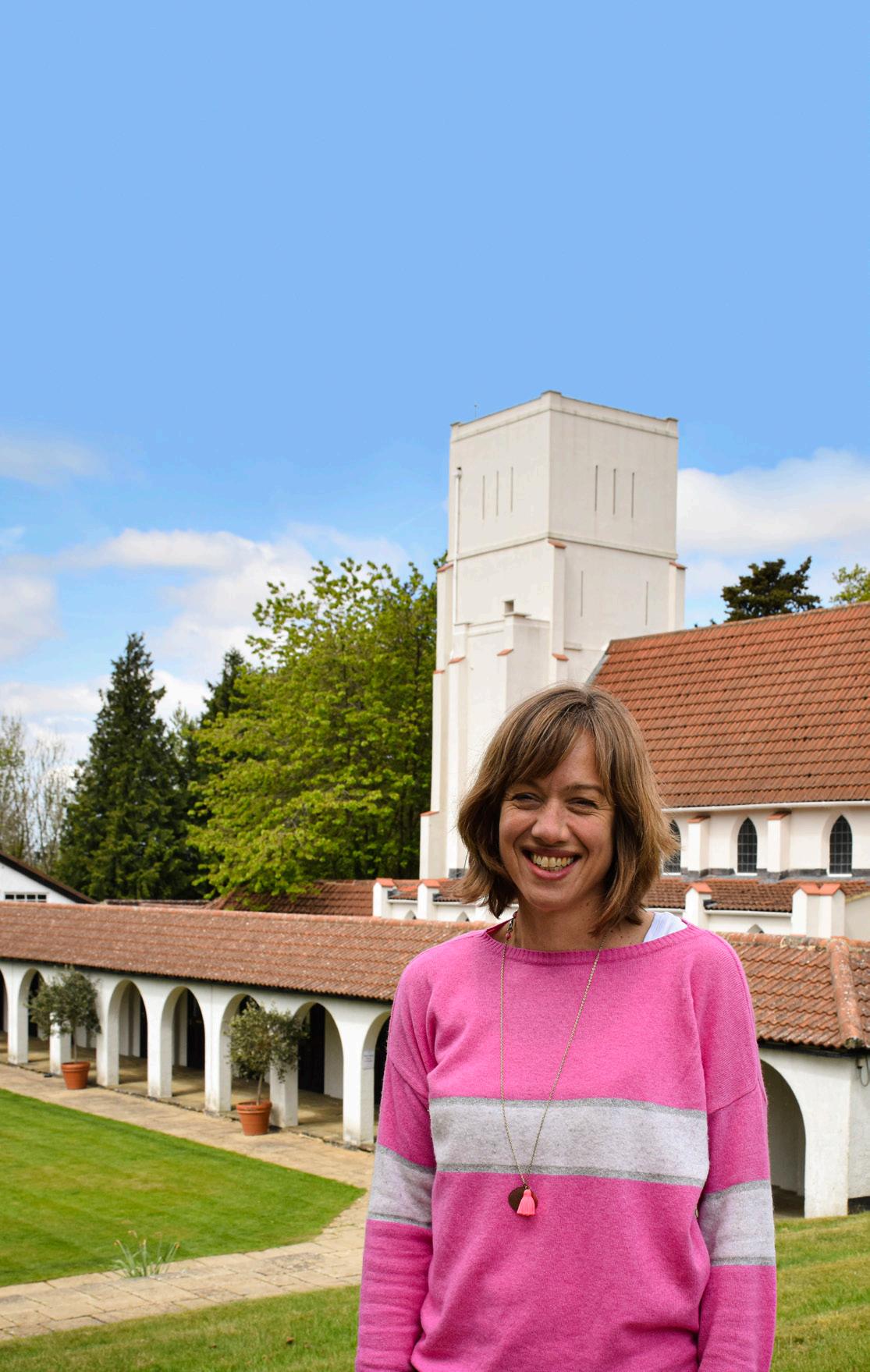
Tell us about your time at Downe House. Do you recall any individual or particular circumstance that may have shaped or inspired your career path?
I particularly remember a day when we had a careers event with lots of people from different industries. I spoke to a Clinical Psychologist (as I was planning to read Psychology at university), and she had a friend who was a Speech and Language Therapist (SLT) and she had always thought if she wasn’t a Psychologist, she would have enjoyed SLT. I decided to investigate SLT and it sounded like a fun degree and job to do for when I had finished flying helicopters (which was my second career plan after realising I couldn’t be a vet)! We also had regular assessments at School, where they discussed what we enjoyed compared to what we were good at and suggested some areas to think about.
Why did you choose to study at the University College of London? UCL offers a very medical based SLT course and as I was more of a scientist, I preferred this option plus I had grown up in Bradfield, so I wanted to experience the big city and the fun to be had up there! I had little forays into London with some of my school friends and they were so cool that I decided it was where I wanted to be!
How did your passion for developing children’s communication began? When I was growing up, I had always been told that I had a natural way with children. Shy children who visited our home always opened up to me, so I feel that working with children has always been part of my personality. I found working with children more reassuring than working with adults, as adults have usually suffered from a trauma or injury and are trying to return to a place before that happened. Whereas children are typically trying to progress to a future goal, therefore no-one can predict how far they can progress as children do not set themselves limitations.
I became increasingly aware during my degree how severely communication difficulties impact children and their families. I grew passionate and focused upon helping them as I went through my degree.
I see in 2006 you set up your independent practice, tell me about that and any challenges you faced I grew my independent practice gradually. I started very low tech and typed up my own invoices, worked
out of our spare room and travelled to Salisbury to see children in schools. As time went on, I took on more local schools and now cover schools that are very local to me.
I wouldn’t say I faced too many challenges as I had several connections with other independent therapists and would alleviate them if they had too much work to ensure all the children that need support received it as soon as possible.
I’ll never forget an electrician coming to my home to do some work and asking me how old my children were, I looked at him confused and explained that I don’t have children. He left the house very quickly and afterwards I realised he had seen the piles of toys I had in the spare room!
And then during the pandemic you saw an opportunity to set up a new initiative The Speech Club. In your own words how did that initiative come about?
We knew there was already a growing problem in the NHS with increasing waiting lists and then during the pandemic the NHS was initially not able to offer anything. Independently, we started seeing children on Zoom and so we knew that remote therapy could work.
My business partner, Claire Whittaker, was an SLT at Mary Hare and I always asked her to come and work for me and whenever there was a job at Mary Hare Claire would send me details! When Claire left Mary Hare, we met up and discussed the crazy numbers of referrals we were each receiving, the length of the waiting lists and started to work out how we could do something that helped children in a more affordable way than 1:1 in-person sessions. That was how Speech Club came into being!
Tell me about some features of The Speech Club
We have over three hours of prerecorded Speech and Language Therapy sessions, covering everything from preverbal skills such as eye contact, turn-taking and making choices, all the way through to using prepositions in simple sentences.
The idea is for parents of preschoolers to be able to sit with their child and watch the lessons (which are interactive), so they have immediate access to Speech and Language Therapy sessions in their own homes. Following the lessons, we give lots of activity
ideas that parents can do in their homes to keep working on the area of language or communication that we targeted in the lesson.
We have a private Facebook group where parents can get support, ask questions and receive regular content to support them further with more ideas and activities to do at home.
As well as a live Q&A each month for parents to have direct access to ask us any questions and get any further advice they need.
And how does a typical day look like for you?
A typical day for us is working together around a dining room table! Answering queries, planning further content for parents, writing our next course, having Zoom calls with our other business partner, Toby, who sets up our beautiful illustrations, worksheets, website and filming. Some days we head out in person to nurseries to speak to them about our upcoming new nursery package and we will be off to Reigate for more filming for our next course soon.
What has been the most rewarding aspect in setting up Speech Club?
The most rewarding aspect for me is hearing a family’s feedback about how relieved they are to have something they can work on with their children while they are on waiting lists. Also, hearing that one little boy say his first words.
What has been the biggest challenge you have experienced in setting up Speech Club?
Having to be good at so many different roles from marketing and presenting to potential investors to doing live TV interviews, all the while still being a therapist! It has been a steep learning curve BUT we’ve learnt so much already.
What would you say to someone who was considering setting up their own initiative?
Go for it!
Finally, what quote/phrase/advice do you live by?
That most learning happens outside your comfort zone. Which is an everyday experience for me right now!
and gets stuck in, I really admire this attitude. Likewise, I would also have to say my mother inspires me, she is a very strong woman and power character in our family, she knows how to get what she wants!
Reliable, dedicated, determined, creative, willing, colourful (as we hold the interview Kirsten is wearing the most fabulous pieces of colourful jewellery), calm, creative, I’d like to think I’m funny (KM- you’d have to ask around about that one) and these days, maybe a bit creaky!
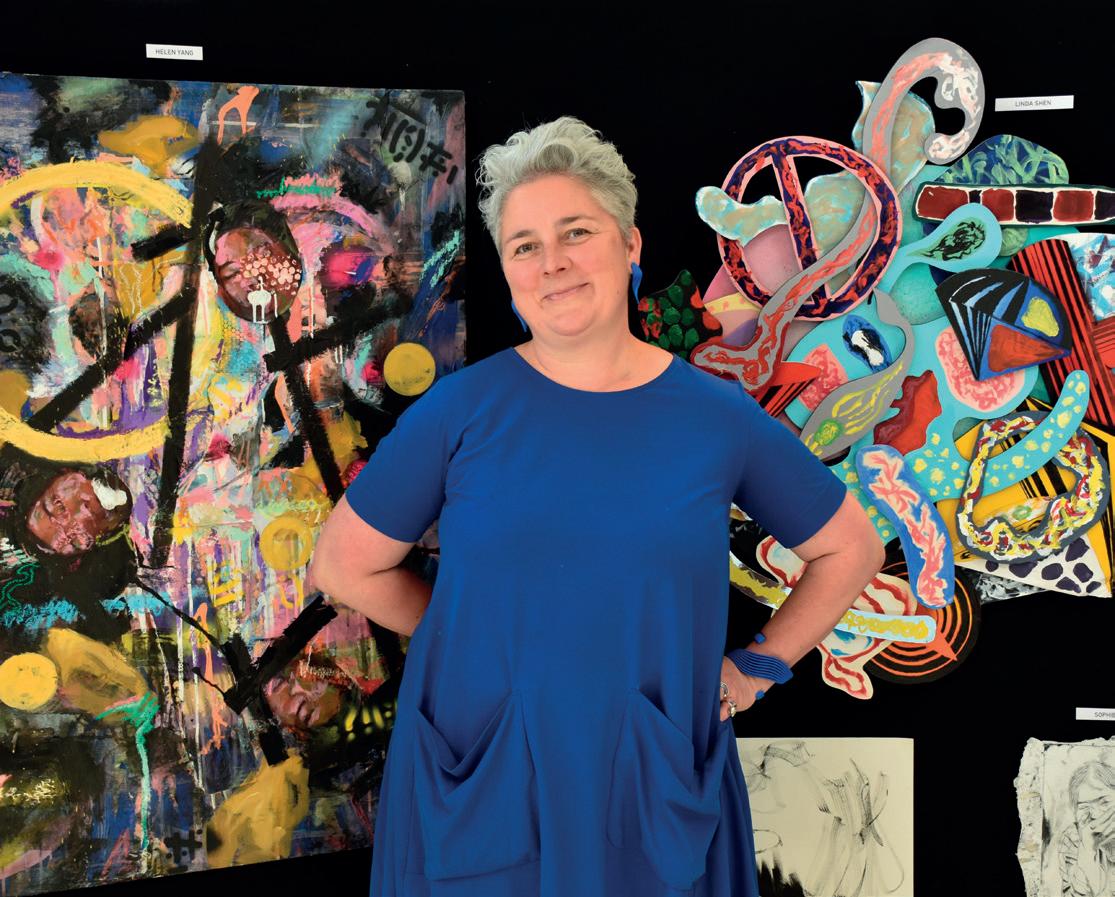
Travel is a huge thing for me, I missed
this so much while pandemic restrictions were in place, it reenforced just how important travel inspires my own artwork and teaching style. When you go to an exhibition for example, it really stirs something in you, this can be an extraordinary and exciting experience and instantly makes me want to create. I try to travel as much as possible for this very reason.
My father also inspired me, being a character that just rolls up his sleeves
My first interview was during the Easter holidays and everything was closed, so I didn’t get a full impression of School life. However, when I came back during term time the School sprung into life. I was really delighted when I was offered the position, particularly as the other candidate had been at the Slade School of Art and I was convinced that would give her an advantage.
“When you go to an exhibition for example, it really stirs something in you”
Following on from a hugely successful Founder’s Weekend, we meet up with our Director of Creative Arts and reflect on her 20 years at Downe House.
I remember attending my first term assembly and being very impressed by the ceremony with all the Seniors in their robes, it wasn’t like that at my previous school and I immediately thought this place means business.
When I joined, I was working with Sally Scott as Head of Department, Clare Risoe and Judy Powell, and Paul Risoe was in charge of History of Art. From the first moment I felt at ease in the department, I could see how able and hard-working the students were and I instantly knew that together, we could aim high.
The amount of food available at School was quite astonishing; you could have breakfast, scones at break, lunch, cake and sandwiches at tea and were even entitled to supper in the evening. It was a running joke that the average staff weight gain in the first year was a stone! It was a very different experience from my previous school, where most staff walked to the local Spar for a sausage roll!
Broadly speaking, tell us about your role as Director of Creative Arts
It’s an extremely busy role – there is always so much going on, largely because we organise so many activities and we are always pushing to do new projects to offer to the best experience for the students. Across the department, we work very much as a team and make joint decisions and never just mine because of my job title. I hold my colleagues in the highest regard and think that the Art Department is exceptional. I see my role as to listen, help when I can to the best of my ability and coordinate our technicians; we simply couldn’t run our thriving and outward looking department without them.
Beyond the teaching remit, I liaise with artists and creative establishments to organise trips and workshops for our students to broaden their experience beyond the classroom. I also reach out to the local community to organise projects and opportunities with other schools to enrich our students and theirs.
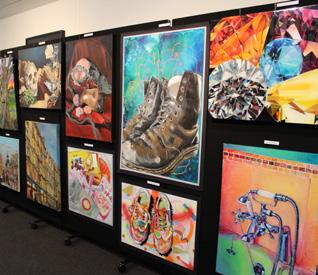
I also react to the needs of our students and staff and ensure I drive the faculty forwards, essentially if we have an idea – I will follow it up and make it happen.
Has teaching Art changed during your time at Downe House? Our use of materials and techniques have developed a lot, however there
is still a strong focus on drawing and painting which has always been a big feature of Art at Downe House.
Technology has had a big impact within art, enabling digital manipulation and this now feeds into our creative field, but at the end of the day, nurturing creativity and improving manual skills is our biggest focus.
Previously, I do remember that, for each girl that we taught, we had to compose full prose handwritten reports at certain times in the school year. It was a mammoth task, even with a slight mistake, you had to start again, thank goodness its not like that anymore!
One thing that will never change is finding myself in the store cupboard and completely forgetting what I have come to look for!
What has been a highlight during your teaching career at Downe House? Every year, the Founder’s Weekend is a highlight. It is the culmination of such an immense amount of hard work for students, staff and everybody involved. People who view it are always astounded by the talent of the students at Downe House, I am always so proud of them and my colleagues who enabled this and dare I say I even allow myself to be a bit proud, particularly when our students leave and go onto exciting futures. It is extremely rewarding to see our students go on to study at top Art colleges in the UK, Europe and the United States before progressing to successful creative professions.
Aside from art, the World Challenge expedition to Borneo was one of the most amazing things I have done in my life. In collaboration with the boys from Radley, we climbed a mountain, undertook project work in a village clearing in the rainforest, trekked through virgin rainforests and slept in hammocks between the trees. We had to sleep with earplugs as the sounds of the creatures was deafening. I did two World Challenges after this, to Venezuela and China, both were incredible, however the one to Borneo was the wildest.
Tell us about any exciting new developments within the Creative Arts department during the next year As of September, Textiles and 3D Design will move under my remit and we are excited about the collaboration and working together. We will also have two new members of staff joining us, Anna Lister in Art and Jennifer White in 3D Design, and we are looking forward to
them joining and what they will bring to an ever-growing department.
Heather Lamont is organising a Lower Sixth trip to Barcelona with the Spanish Department – this will be an inspiring and exciting trip and I am very grateful to her for all the work she is putting into this. Tracey Jones will continue to offer weekly clubs and workshops for our Award Holders and those with an interest in pursuing Art beyond the classroom.
We are also looking to add our Founder’s Weekend to the regional Open Studios scheme so that members of the public can enjoy the creativity of our students.
A lot of work has been done this year as well to improve the spaces where we work and learn, we always try to make them as functional and inspiring as they can be, so we will continue to work on this.
Finally, a quote, phrase or piece of advice that you live by I advise all our students to see Art in the flesh; there is no comparison to seeing it online or in a publication, you need to feel and experience art with your own eyes. I tell my students to keep up to date with their independent sketch book work, this shows us who they are and by going the extra mile, they will reap the benefits when it comes to determining their grades – I will be telling students this until I retire!
For me, creativity is a gift which sets you apart from others.
On a personal level, having grown up in the South West, there is a saying, “don’t get nasty, have a pasty”, so if that isn’t something to live your life by, then I don’t know what is!
You can follow Kirsten Mortimer’s work at www.kjm-art.co.uk Currently exhibited at The Globe (Newbury)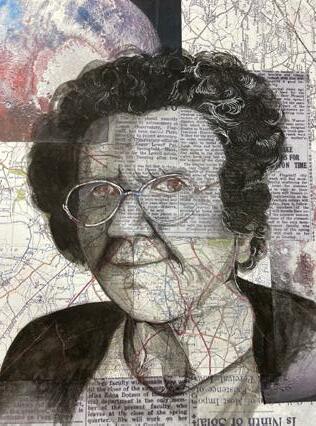


Students picked a notable member of the Downe House alumnae to feature in their work. They then researched their chosen person and put together a large collage of imagery that is reflective of the respective alumna’s life and achievements –this formed the background of their piece
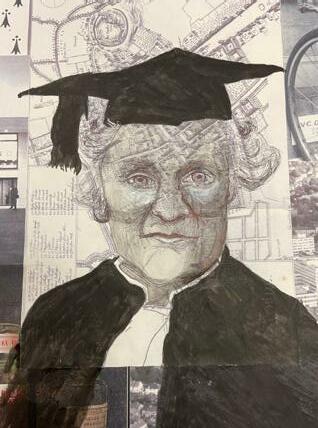
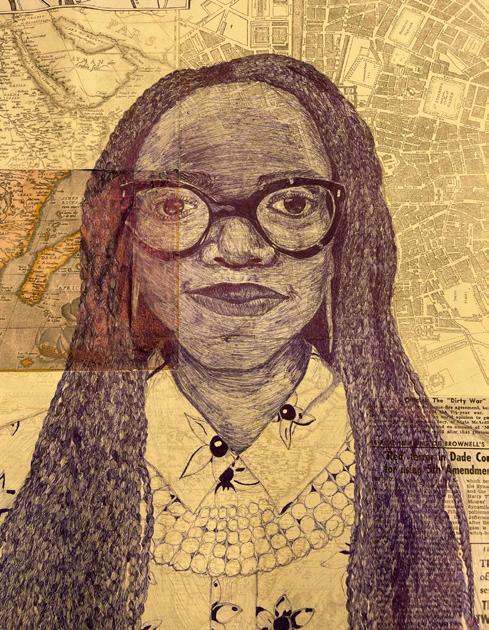
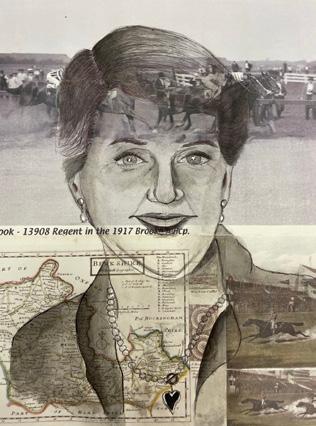
The portraits were drawn in pen and/or Indian Ink and featured in the DH Centenary Exhibition as part of Founder’s Weekend 2022.
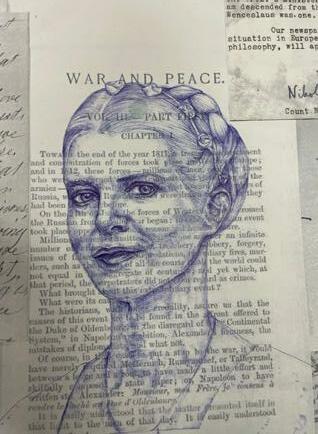
Garments by A Level Textiles students were the focal point at the entrance of the main exhibition in the Murray Centre and demonstrated skill, flare, imagination, and the fusion of an array of creative techniques. GCSE pieces were displayed on the lower floor and were hung from scaffold so that viewers were afforded an interactive experience.
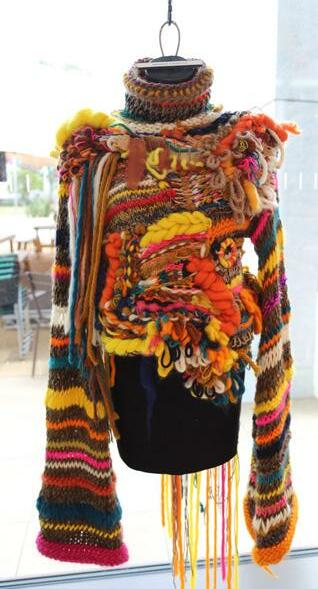
In addition, there were beautifully crafted Key Stage 3 insect, fish and ‘scene’ sculptures as well as flying bird mobiles hung from a scaffold gantry over the stairwell.

In the Nickel Room there was a special Downe House Centenary Exhibition which featured a display of archive material alongside creative work by Textiles, Art and English students. In their Art lessons the UIV made resin-coated Pop Art portraits of the legendary Miss Nickel, as well as lino prints. Further responses to the centenary theme took the form of wonderful Grayson Perry-inspired ceramic vessels, and Lower School Art Award Holders referred to archival photographs to inspire portrait pieces using print and mixed-media.
Some of the Lower Fifth Textiles pupils created a collaborative wall hanging depicting our Founder,
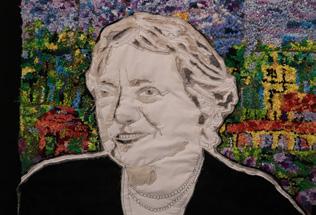

Olive Willis. The background was made using a rag rugging technique and featured the Pepper Pot on the left, and Chapel to the right.
Congratulations to all those who made the amazing pieces of work on show, and a huge thank you to the staff who made this incredible celebration of creativity at Downe House possible!
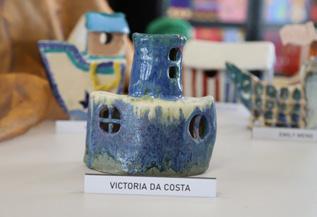
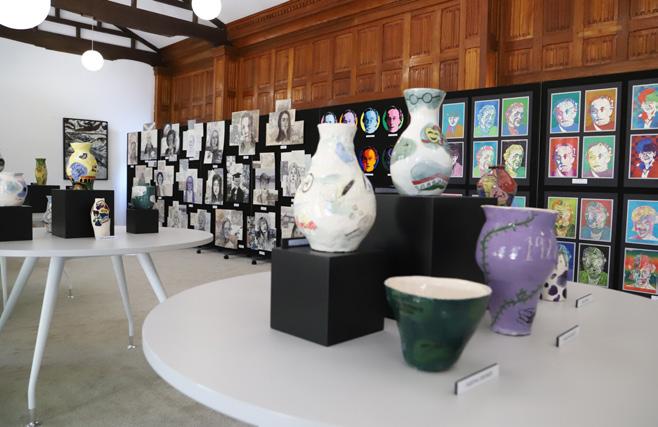 WORDS MRS KIRSTEN MORTIMER
WORDS MRS KIRSTEN MORTIMER
As part of the Centenary celebrations, the Creative Arts Department presented some outstanding pieces across the campus during Founder’s Weekend 2022.

Judith’s association with Downe House goes back 21 years. It began when her daughter, Hannah (DH 2008), joined Downe at 11+ as a boarder.
Hannah thrived, made strong friendships and excelled in many spheres prior to going to study Law at Cambridge. When Hannah left, I spoke to Judith about the role of Head of Lower School which, I am delighted to say, she thought would be of interest (she was a highly acclaimed Director of Music at a local Prep School). She went through a very rigorous interview process and the rest, as they say, is history.
During her fourteen years as a colleague, Judith has shown herself to be an outstanding professional whose love of children shines through in everything that she does. She is caring, hard-working, ambitious for her students and is always willing to go the extra mile. Judith built strong relationships with feeder schools and parents; she is a people person. She gives of her time freely, always wants to do the right thing and is exceptionally talented in a variety of areas! She has run choirs, supported the Music Department, been an excellent Tutor, a wonderful support on the Leadership Team and someone who always looks for ways to overcome obstacles. Her can-do attitude, professionalism and compassion will be sorely missed, as her sense of humour will be too. She should be in no doubt about the difference that she has made, and she moves on with our sincerest thanks and our very best wishes for her future happiness.
At the end of the Summer term we bid farewell to Mrs Judith Gilpin Jones (Assistant Head of Lower School). Headmistress Mrs Emma McKendrick shares her memories of Judith’s time at Downe House.
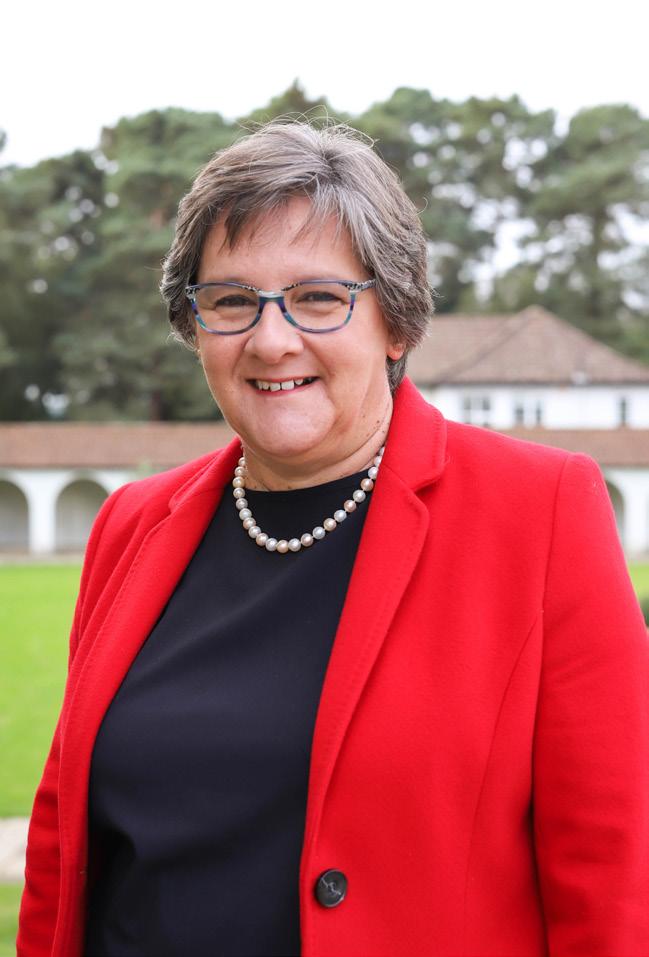 Mrs Emma McKendrick
Mrs Emma McKendrick
at the
October
RSVP by Monday 26 September
01635 204797
October
This year’s annual Downe House Seniors’ Association Short Story Competition was inspired by the Queen Elizabeth II’s Platinum Jubilee. The story content did not have to relate to the Queen; the themes were purely to spark ideas. The Sixth Form were given the theme of Dignity, Upper School had Endurance and Lower School wrote on Wisdom. The stories submitted showcased a passionate interest for a wide variety of literary genres. The shortlisted work was judged by a panel of DH alumnae with careers or interests in the world of writing and publishing. Mrs Boswell, one of our English teachers, who began the competition, and 2021 winner, Poppy Scales, also joined the panel.
Congratulations to the well-deserving 2022 finalists: Sixth Form winner: Lauren Sixth Form runners up: Lottie and Mary Upper School winner: Annabel Upper School runners up: Isabelle and Effy Lower School winner: Sophia Lower School runners up: Rosie and Aryana
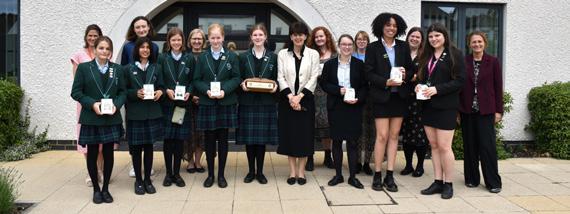









Sister of Barbara Brodhurst-Hill (DH 1930) and Mother of Annie Walker (Fellowes DH 1973)
Born 27 November 1923 Passed 9 May 2022 at the age of 98, becoming the longest-living member of her family on record.




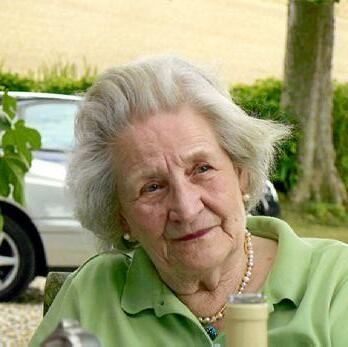
It has always been ‘Sue’ (‘oh, please call me Sue’) to allcomers, barring of course, her much loved and eagerly collected 14 grandchildren and 13 great-grandchildren…to whom she was respectively ‘Grandmama’ and ‘Greatie’, and she was delighted to learn not long before she died that her family was expecting to grow again with two more great-grandchildren.





Sue’s paternal grandparents on her mother’s side of the family went out to New Zealand with their children in the early-to-mid 19th century. One of them married into another family of settlers, hence regarding themselves very much as New Zealanders. Meanwhile, Sue’s father was an Englishman, thus Sue took great pride in being duel English and New Zealander, added to which she was born in New Zealand.
Her father, Ralph, had been posted by the Colonial Service as a District Commissioner to the far-away (but conveniently near to New Zealand when having a baby) Solomon Islands, eventually becoming the Resident Commissioner. He served there either side of the First World War and travelled back from the Solomons to join the fighting, only to be wounded on the Somme and taken as a prisoner-of-war. Sue arrived in England for the first time at two-years-old with her elder brother, David, whom she simply adored (he was tragically killed in the fighting in Italy in early 1944).
Still at school when the Second World War broke out, Sue longed to become involved. Before eventually joining the Wrens, she worked at London Bart’s Hospital as a ‘lady portress’; then she worked in the Home Guard based at home in her beloved Suffolk, but when it came to anything involving Maths she quickly gave up! Next came a role at Saxmundham Station with a very good friend of hers. They were trusted to perform ‘vital defence work’, immediately reporting on any signs of a German parachutist or an invasion,
or even both, but she confessed that, as gossiping teenagers, they never saw fit to raise any alarm at all!


At long last, she was able to join the WRNS (‘Wrens’) and served from August 1942 until the end of the War. She was a wireless telegraphist, trained to intercept naval messages from the enemy, as she had been posted to Ceylon (now Sri Lanka) for much of the time. These messages were then taken to a ‘higher unit’ for decoding (which was all she dared tell her family, even decades later, given she had signed the Official Secrets Act, this work being for the highly secretive ‘Y-service’).

One of the proudest moments in her later life came during her visit to Bletchley Park in 2012. Merely applying to attend an Open Day, they somehow sensed that maybe there was something a little different about this applicant, so Sue was requested to ‘report at the front-gate and wait there’, before being accompanied into the Lecture Hall. The whole occasion had been stage-managed, with the audience rising upon her entrance, to a rousing applause she took her seat in the front row. The Lecture commenced, all about Bletchley’s intriguing work during the War, but some time was made for a little ‘audience participation’. Unbeknownst to Sue, she was invited to have a go at taking down a Morse Code message on the same sort of machine that she would last have used seventy years earlier. There is clearly some truth in the adage ‘You never forget how to ride a bike’, as she rose to the challenge and proceeded to take down the message like the true professional she clearly had been, way back in the day!
She married Neville Fellowes, December 1948 and started a family, having three sons and then a daughter. When asked: ‘How many children did you envisage having originally?’, her direct answer was: ‘Seven for me, but just two for your father – so we had just two…and then quickly made two of the best mistakes of our lives!’
Sue was never a great traveller, once saying: ‘I am frightened and when I come home from abroad, I would always feel: ‘never again’. However, her eldest son, David, managed to persuade her go to New Zealand in 1992, now aged 68, this was the first time she had been back since her birth. Touring both islands and meeting several relations, they took time out to do a bungyjump in the Skipper Canyon near Queenstown. She had simply wanted her grandchildren to be proud of her and had the courage to jump off a bridge 229 feet above the Shotover River.
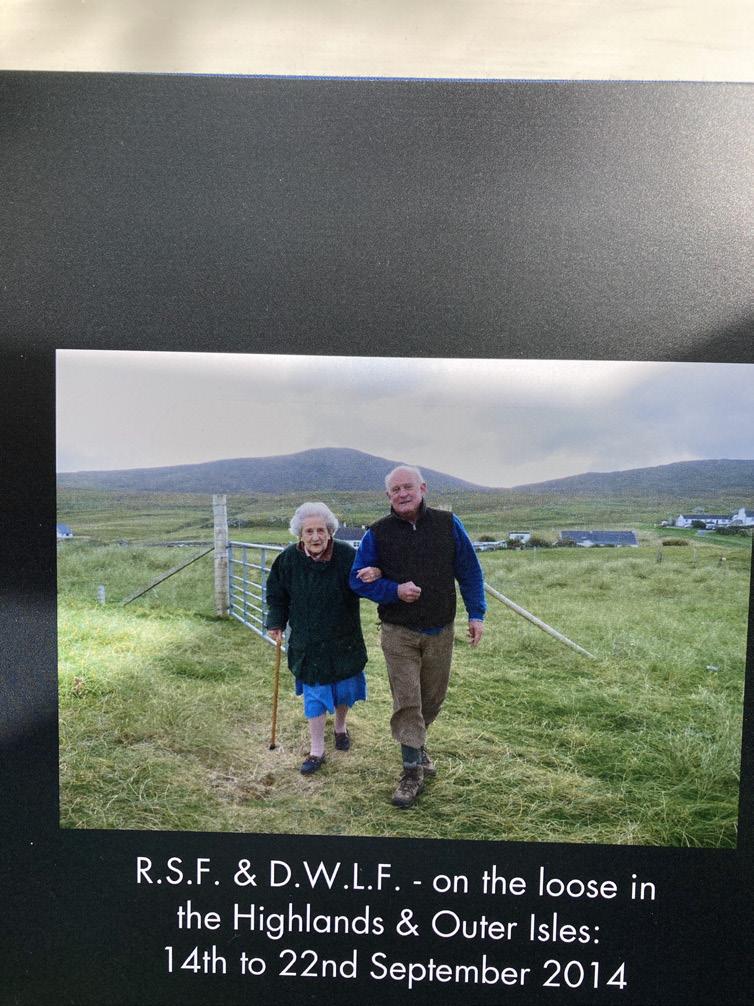
During a ‘family interview’ in 2009, she was asked two, rather more philosophical, questions:




If you could change at least two things, either in this country or more globally, what would they be?
What would your advice be to your family and friends?


“Peace for ever and…the end of ‘socialistic ENVY’”, wrote Sue (‘envy’ was written in capital letters and underlined several times).
“Be honest, be true, have patience and have a never-ending sense of the ridiculous,” said Sue.WORDS DAVID FELLOWES (SUE’S SON) Illustration:
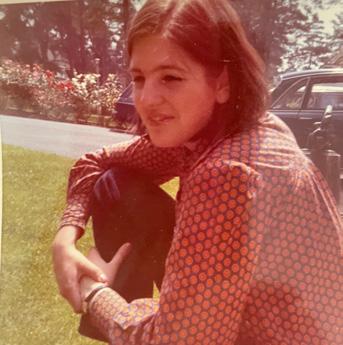
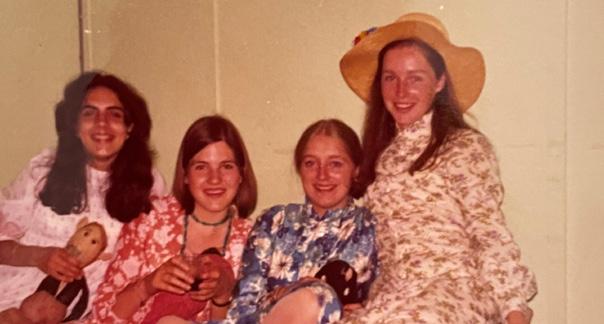















Ifirst met Victoria in September 1965 when we both shared a room in Top East. It was my second term and Victoria’s first term. Victoria had come all the way from Dublin and was as homesick as I was. We both spent the first term crying and probably most of the other terms too till the Sixth Form, when life was very different, and we could come and go every weekend if we wanted. It seems ironic that I was crying the day I first met Victoria and I was crying when finally, we said goodbye at the wonderful service for her at Worcester Cathedral.
Victoria did cry a lot though, she always cried when we said goodbye after spending weekends and holidays together. Victoria was in Remove C and I was in Remove A, and we stayed in our respective forms till the Lower Sixth. There were four of us close friends; Hanny Macfarlane (Foster) and Liz Rees (Calder), Victoria and me. We have stayed exceptionally close friends since 1965, getting together more recently when we could especially during Covid times. Being at boarding school meant that our friendships were so much stronger than they might otherwise have been. As Victoria had parents living abroad, she would often come home with me at weekends and half terms, and my parents and siblings enjoyed her company very much. Victoria was excellent at music –she played the flute and the piano and sang in what we called Choral and I think she even played the organ in Chapel. She carried on singing throughout her life and sang in all the Worcester choirs: the Three Choirs Festival Chorus, Worcester Festival Choral Society and Worcester Cathedral Chamber Choir. Members of all those choirs volunteered to come to sing at her service, where the music was so lovely, she would have been delighted.
Despite all the homesickness, our days at Downe were filled with laughter and bike rides, midnight feasts, early morning swims, giggles and messing about, and drinking L’Hirondelle rosé wine in our rooms in the Summer term after our exams, listening to our record players. We must have done some work though as we all came away with our O and A Levels successfully. After we left school in 1971, Victoria went to Froebel to become a teacher. She then went on to do a teaching degree part-time whilst she was still working once her girls were grown up and we were so proud of her for an amazing achievement.
Victoria met Mark Bradley and married him in 1977 in Ireland. Liz and Hanny were able to go to the wedding but at that time I was away in New York.
Victoria and Mark have two daughters, Issey and Harriet. Issey has a small daughter, Victoria’s first grandchild; fortunately Issey was able to tell Victoria before she died, whilst she was still fairly lucid, that she was expecting twins this summer.



Victoria and Mark moved to Worcester just before Harriet was born in 1987 but we still managed to get together as often as possible. After Victoria retired from teaching, she took up watercolour painting, made numerous tapestry cushions and knitted endless baby clothes for Issey. Everything she did was lovely –her watercolour paintings and Christmas cards she had printed every year are very special.
Victoria’s and our lives were fiercely interwoven. We all got married, we all had children and were godmothers to each other’s daughters. We spent days and holidays together, weekends away and so many supper parties in London. We were all at each other’s weddings and now have all been at each other’s children’s weddings. Once I had moved to Devon it wasn’t quite so far away and we saw each other regularly and spoke on the phone often –swapping stories of our children, our daughters’ pregnancies, grandchildren, recipes, holidays and mostly trying to organise the four of us getting together; Zoom calls with the four of us girls during lockdowns which were always fun as someone invariably had their mute button on. We managed a wonderful day out in Bath in 2019 just before Covid hit and then we all managed to make it to Liz’s house in Ascot at the beginning of December 2021 for a girls’ night away. Victoria drove rather nervously from Worcester as there was a massive rainstorm, my train from Exeter was delayed for hours because of it but we all made it; Hanny driving up from Chichester and Liz hosting us beautifully. Who would have thought that would have been the last time we were all together and if I had known I would not be seeing Victoria ever again I would have hugged her just a little bit longer and tighter, and told her I loved her and thanked her for being her.
Victoria was diagnosed with a brain tumour on January 4th and died on February 9th, 2022. We all miss her dreadfully.
WORDS KATIE MARTIN (SMITH DH 1971)






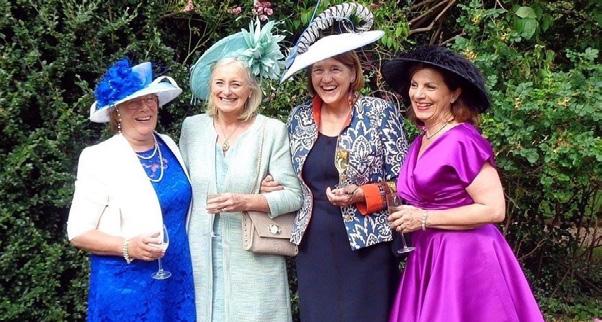
MRS JOANNA THOMAS (HARBEN DH 1948)
MISS SUSAN BATTY (DH 1945)
MRS BRIDGET CONNELL (FLETCHER DH 1946)
MRS JENNIFER WALLINGER (CLARE-LEES DH 1949)
MRS ROSEMARY NANKERVIS (CHARRINGTON DH 1960)
MRS GILLIAN GRIMES (TOWNEND DH 1948)
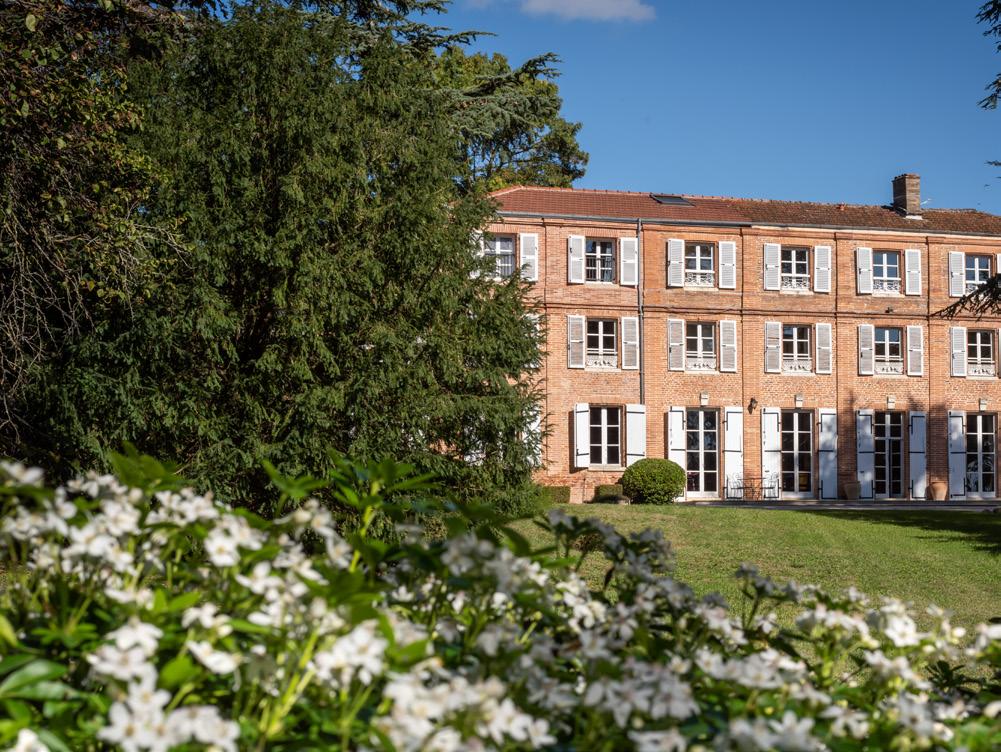
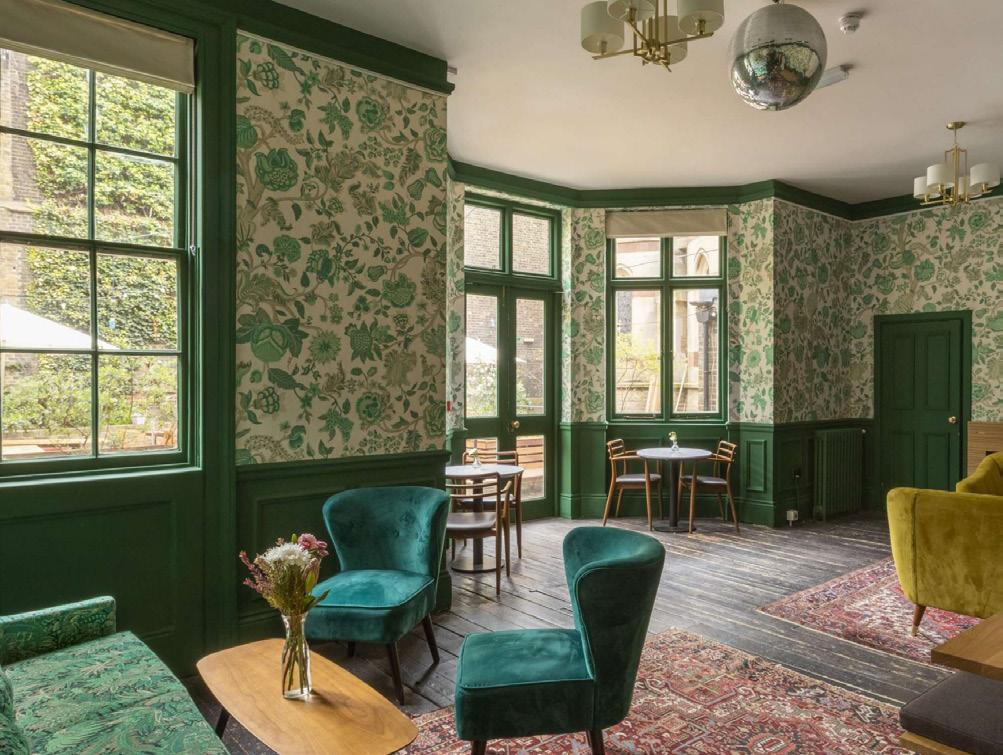
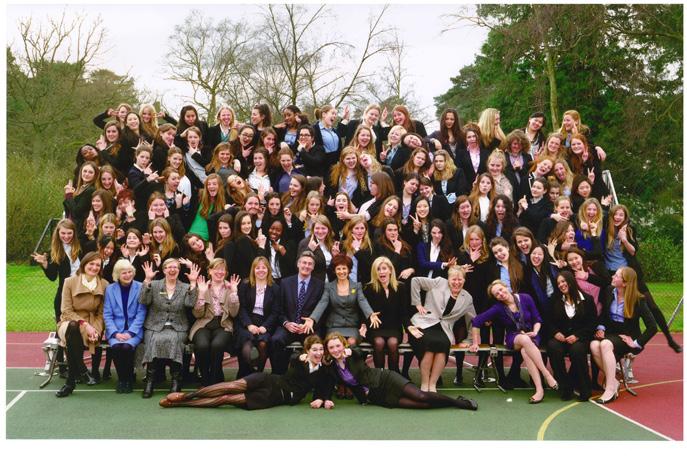
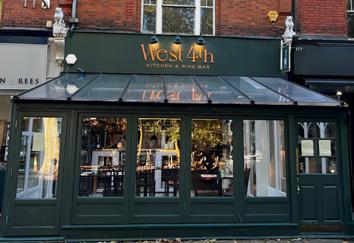

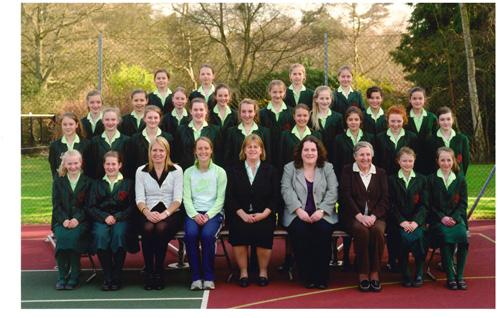

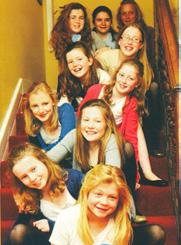
Ihave heard it said that when alumnae return to Downe House they will often admit to missing Chapel, even if during their time at School they were known for hiding in wardrobes to avoid attending the compulsory services! They acknowledge that Chapel was something they went onto miss! Was it the peace this beautiful space offers? Perhaps it was singing hymns as a community on a cold winter’s day? Or maybe it was gazing at the colourful cobalt blue and red stained-glass window as it was lit up by the morning sun? How well do you know the history of this window?
Our Chapel’s stained-glass window was in fact created as a memorial to a fifteen-year-old Downe House pupil, Margaret ‘Peggy’ Warrand Connal, who tragically died from a mastoid ear infection that spread to her brain. If you look closely, written on the edging of the righthand panel are the simple yet poignant words “In Love. Peggy Warrand Connal”.
From the late 1920s to early 1930s, Peggy attended Downe House with her sister Elizabeth Warrand Connal. Jane Caiger-Smith, our archivist writes, “her family commissioned the artist, Beatrice Ethel Lithiby, also known as B E Lithiby, to create a stained-glass window in her memory. The glass was painted and glazed by Lowndes and Drury at the Glass House in Lettice Street, Fulham.”
I regularly look at the stained-glass window during our Chapel services. The window depicts the life, death and resurrection of Christ, and according
to Lithiby, represents “a scheme of redemption” whereby the story of Christ is told simultaneously with the redemption of men, women and children. The window should be read from the bottom upwards, with Christ in glory standing with disciples surrounding him at the top.

Next time you return to Downe, why not visit the Chapel and have look at the window with a new perspective? You might notice that “at the bottom of the window, there are two quarter-circular panels on the left and right which depict Downe House girls and the buildings of the Cloisters including the Chapel.”
I like to imagine that they represent Peggy’s peers and perhaps one image may be inspired by her likeness, although I have no proof for this. However, I also like to think they represent all Downe House pupils, past, present and to come, who have and will be a part of this place.
Although you may have not yet created a lasting work of art, or there may not at this stage in time be a plaque or stained-glass window to mark your time at Downe House, your very being here in this place has contributed to the spiritual reality of the School. From when you were studying hard or playing on the sports field; in the friendships you made and the laughter and the tears you shared, to the Chapel services you attended – no matter which century these moments were created, they will always be a part of the fabric of our community that connects us all.
WORDS REVEREND ANTHEA PLATTIn celebration of 100 years in the Cold Ash, we conclude the magazine with our School Hymn



Dear Lord and Father of mankind, forgive our foolish ways; reclothe us in our rightful mind, in purer lives thy service find, in deeper reverence, praise.
In simple trust like theirs who heard beside the Syrian sea the gracious calling of the Lord, let us, like them, without a word rise up and follow thee.
O Sabbath rest by Galilee, O calm of hills above, where Jesus knelt to share with thee the silence of eternity, interpreted by love!
Drop thy still dews of quietness, till all our strivings cease; take from our souls the strain and stress, and let our ordered lives confess the beauty of thy peace.
Breathe through the heats of our desire thy coolness and thy balm; let sense be dumb, let flesh retire; speak through the earthquake, wind, and fire, O still, small voice of calm!
